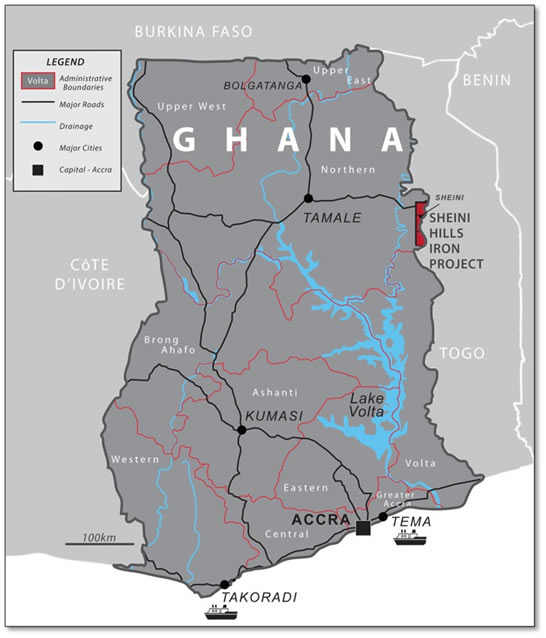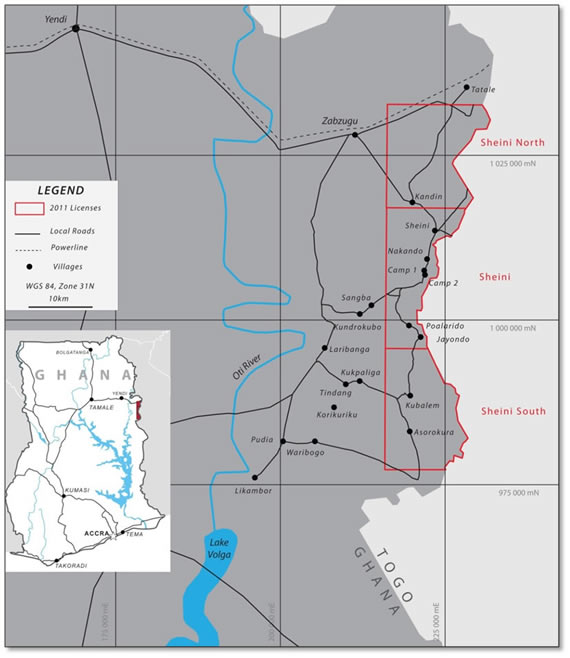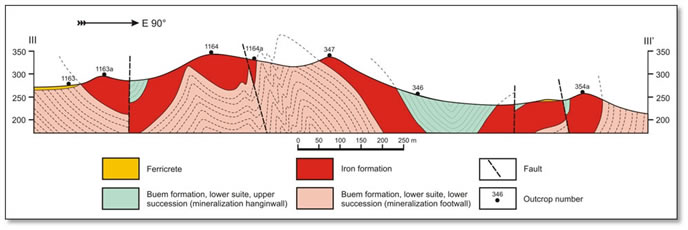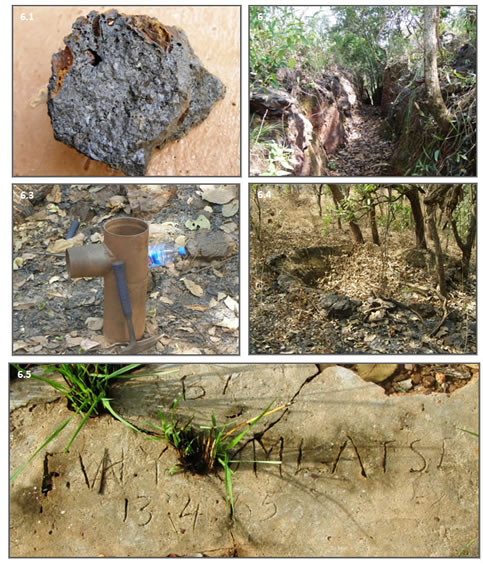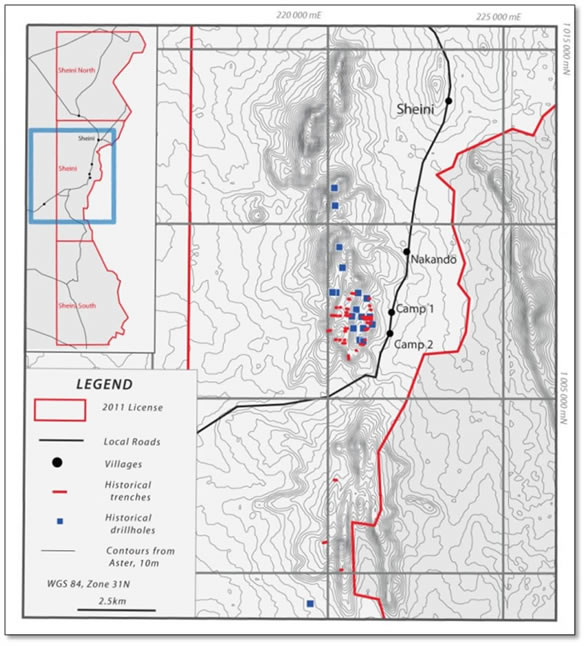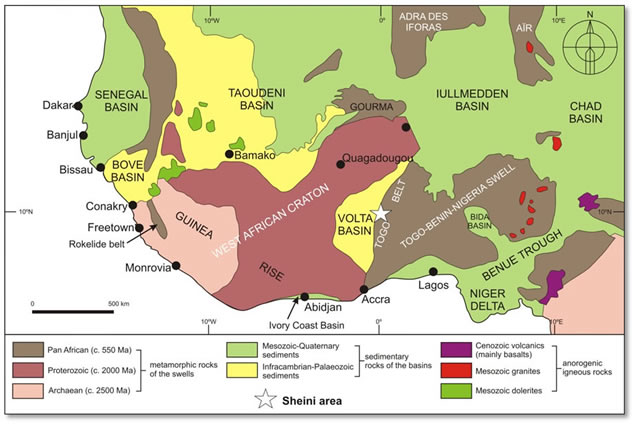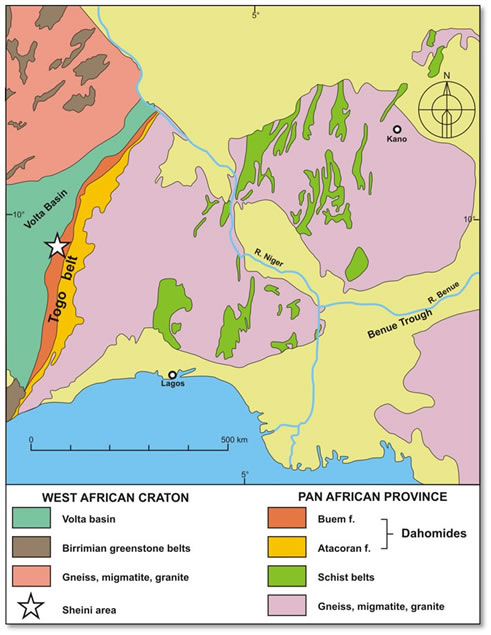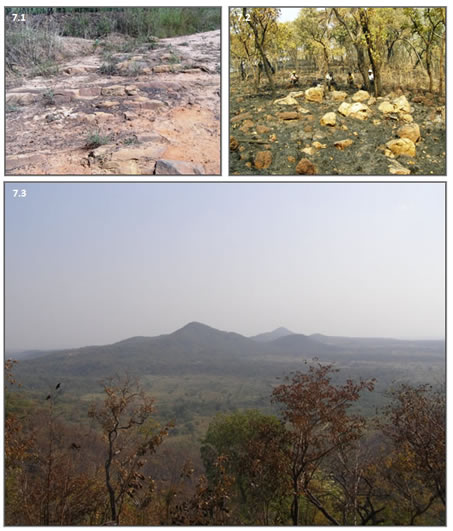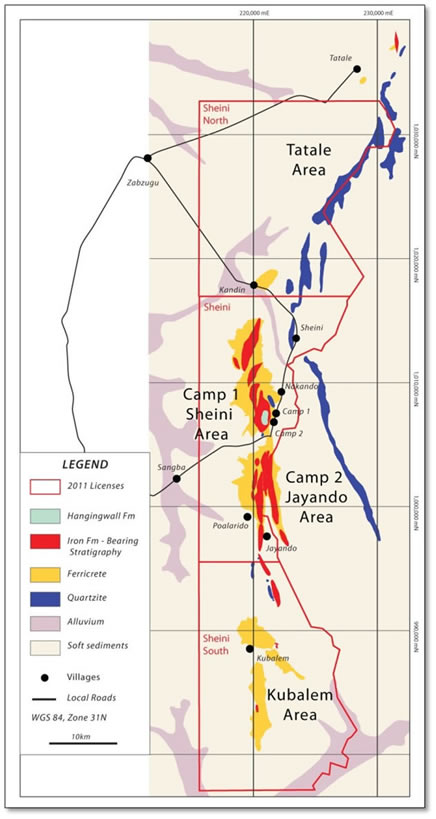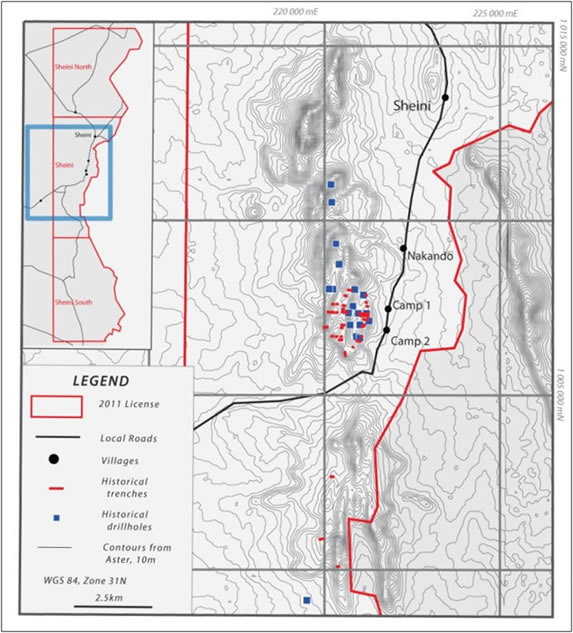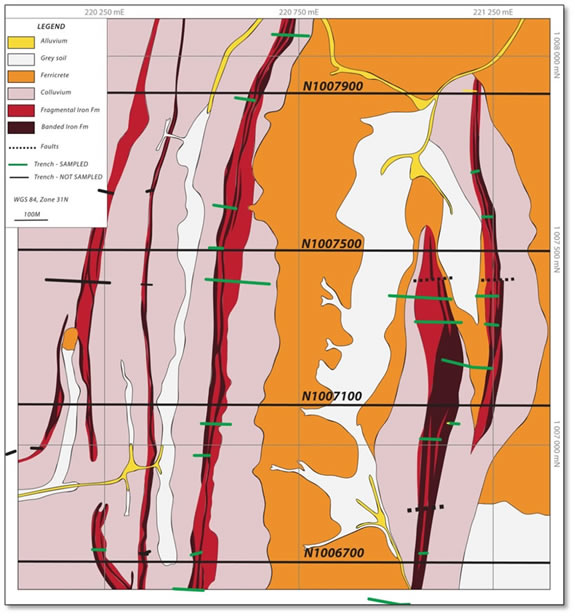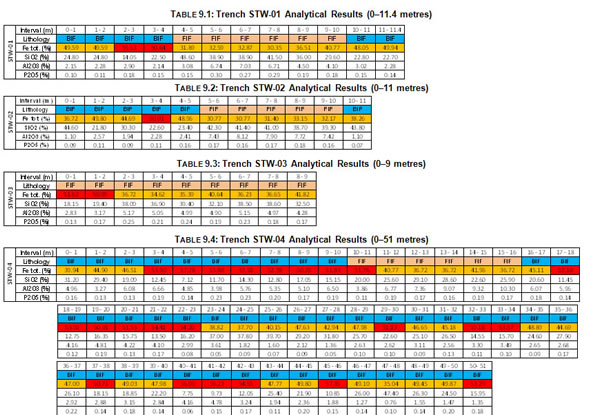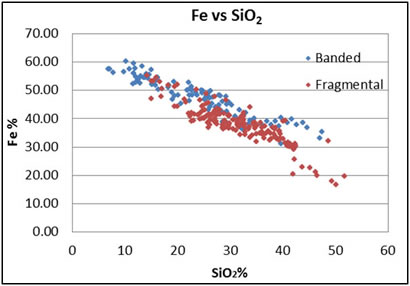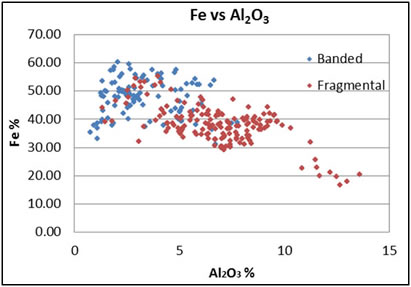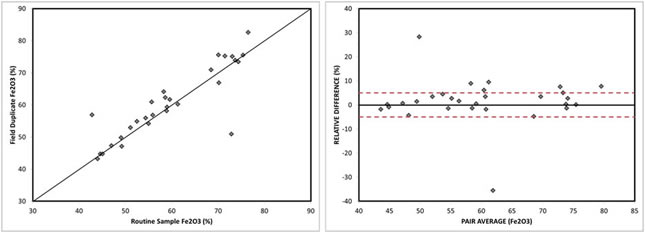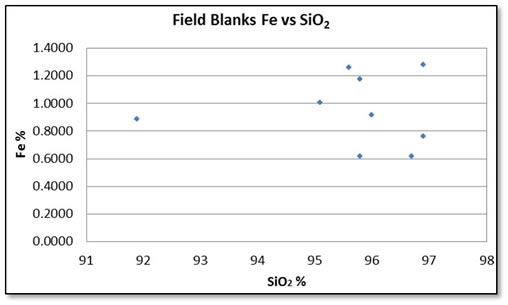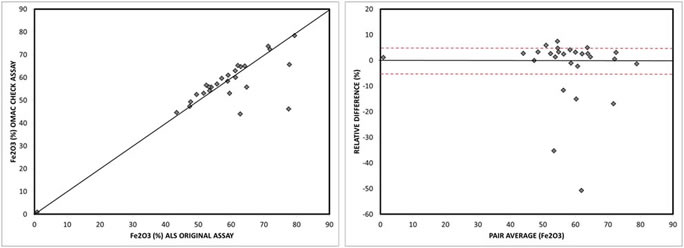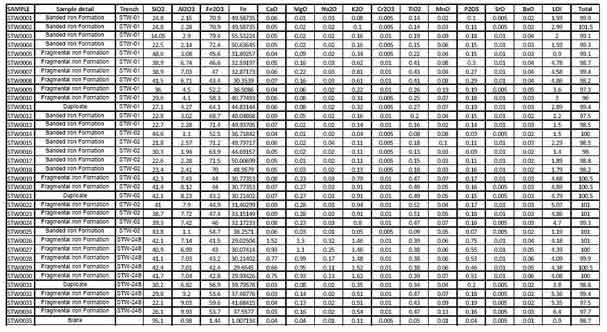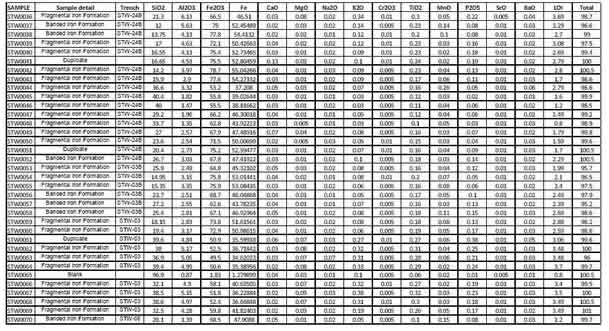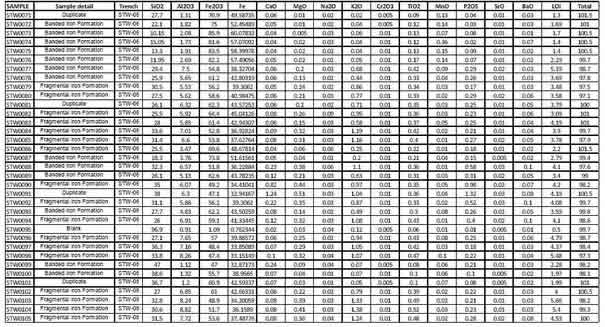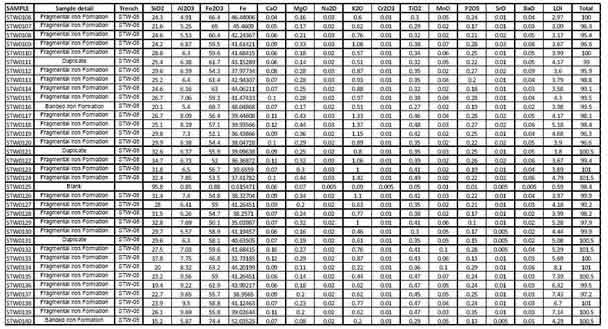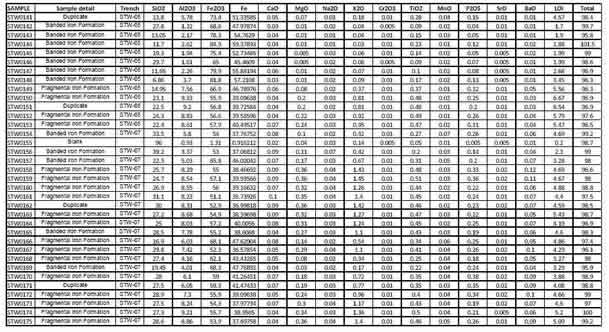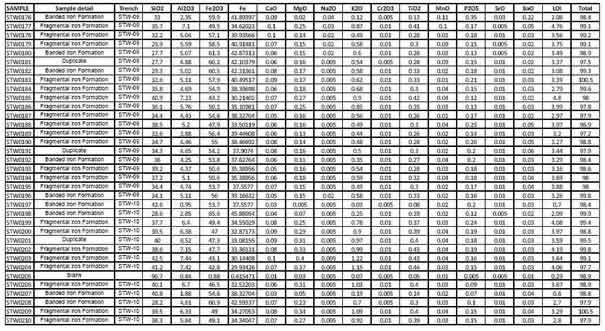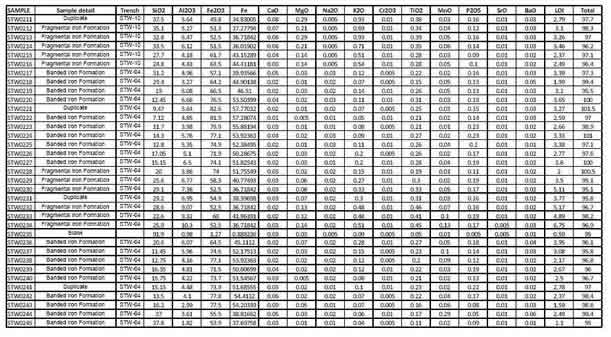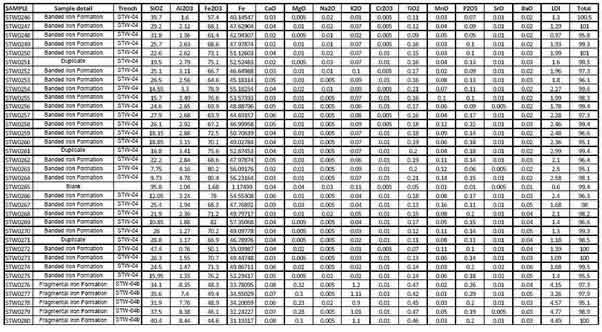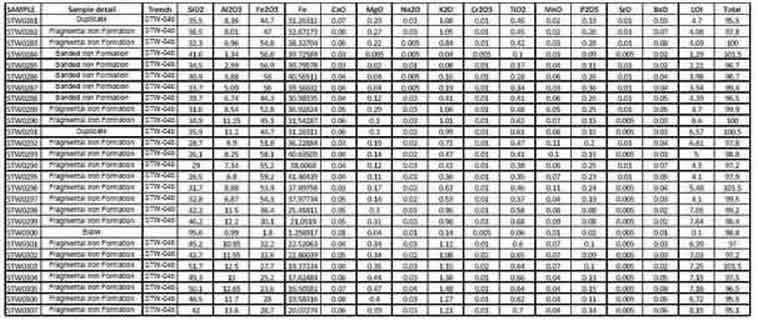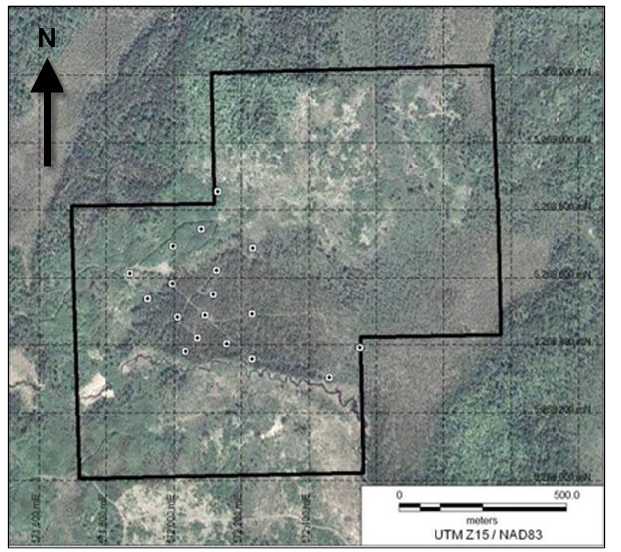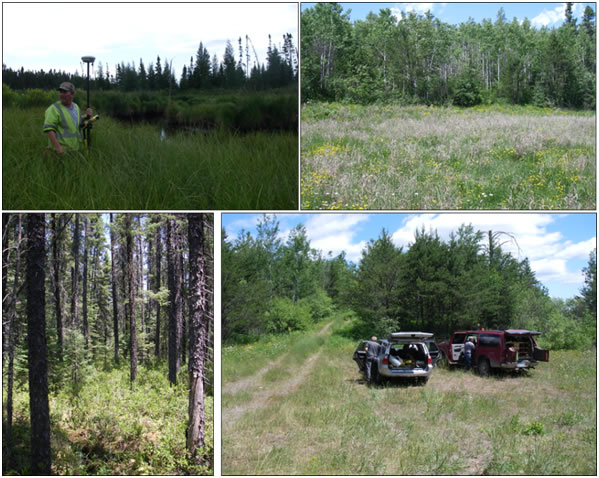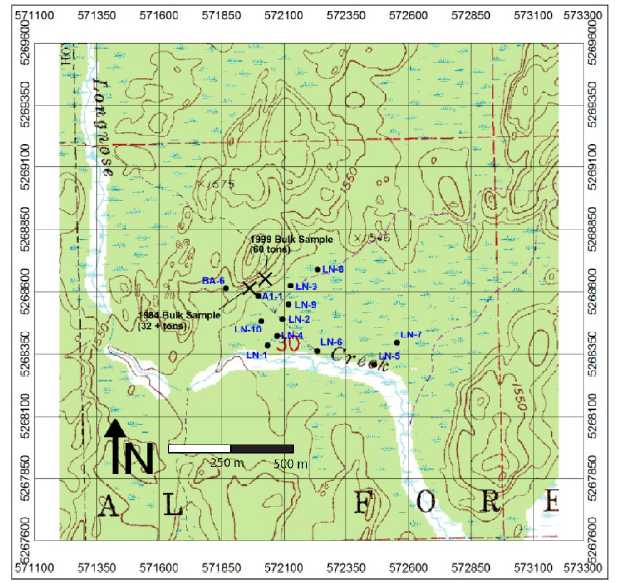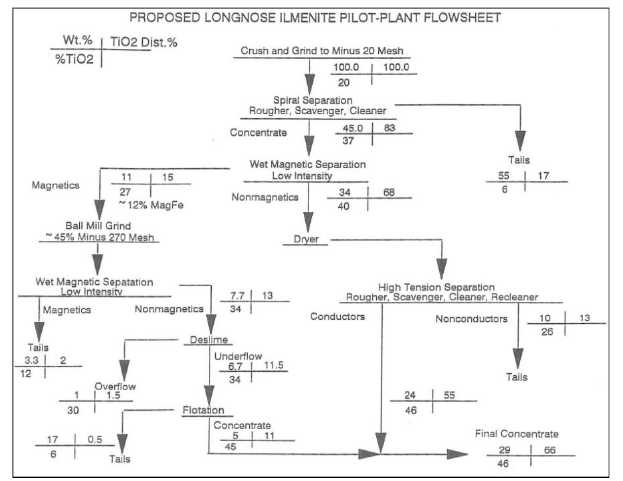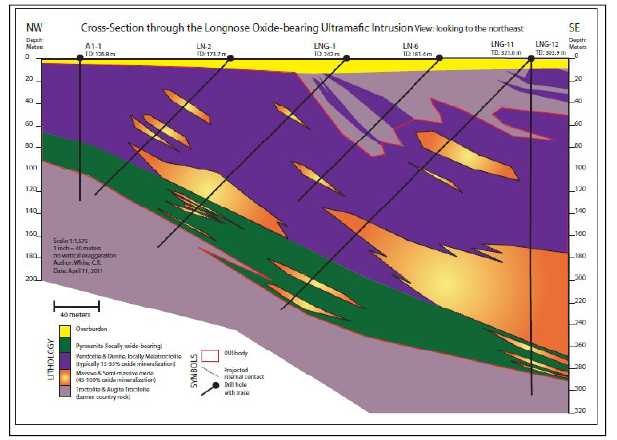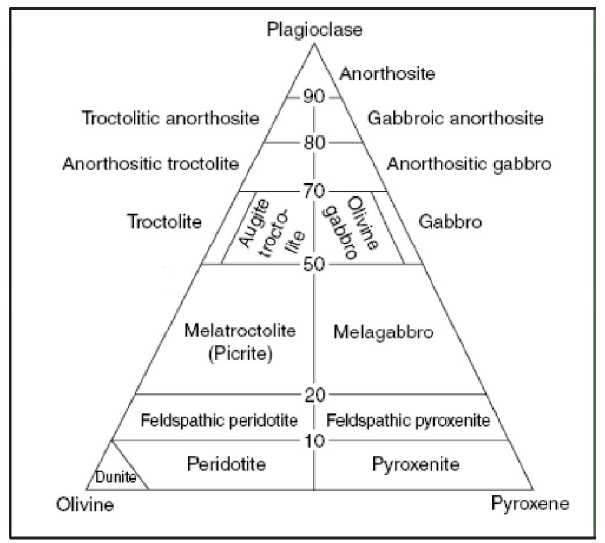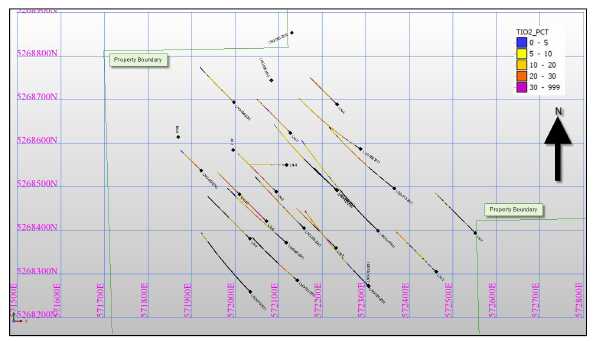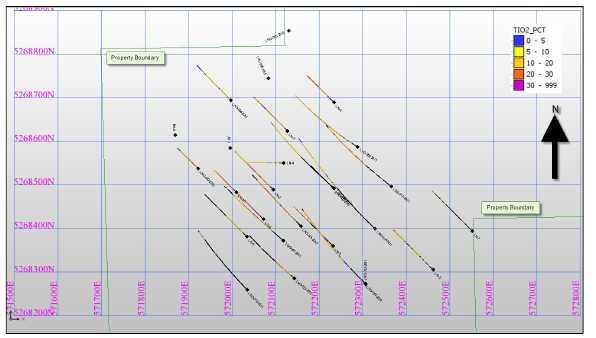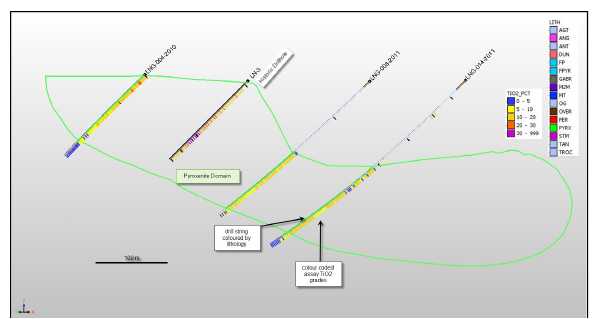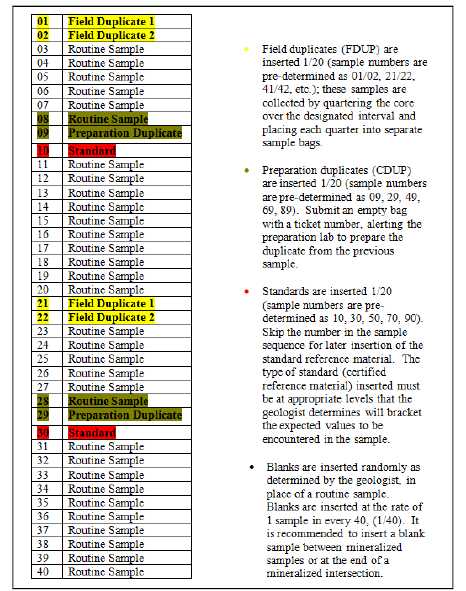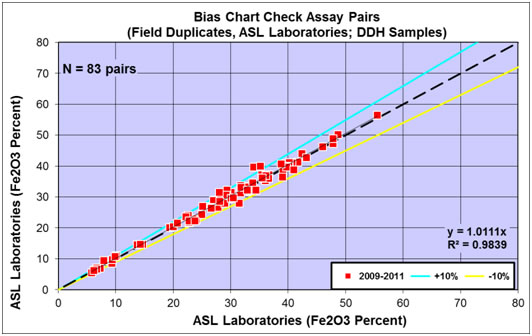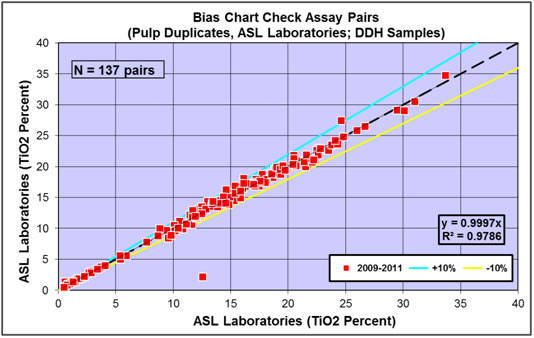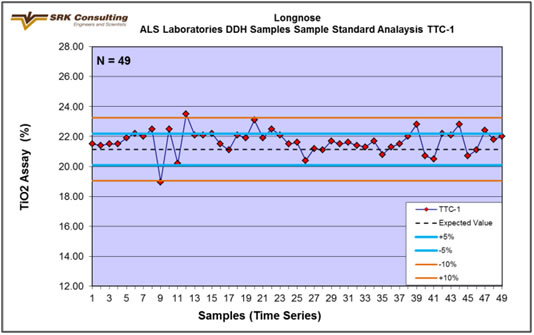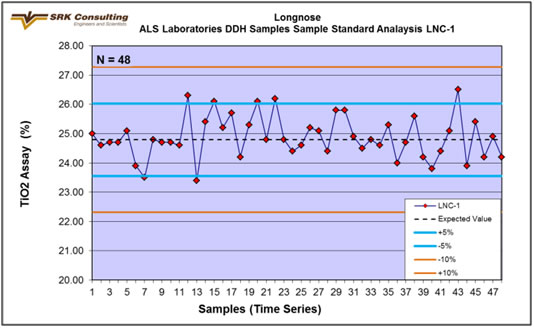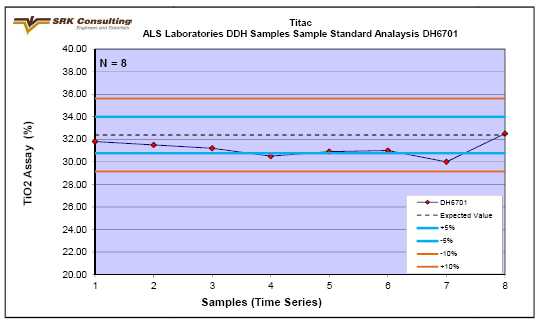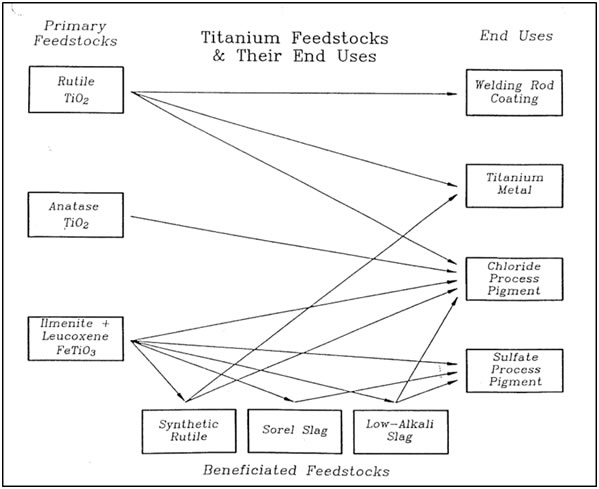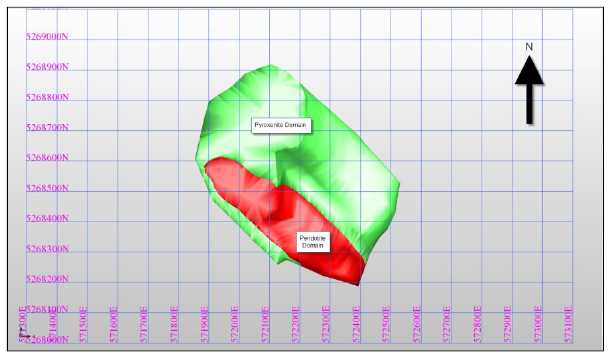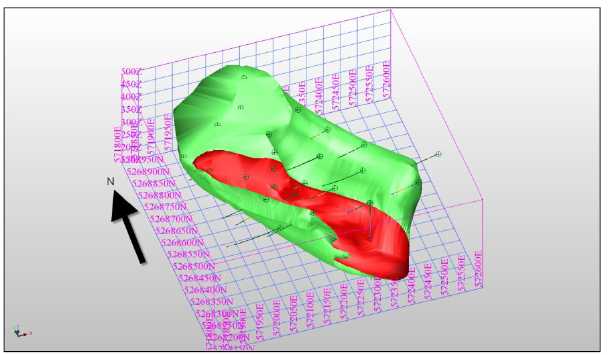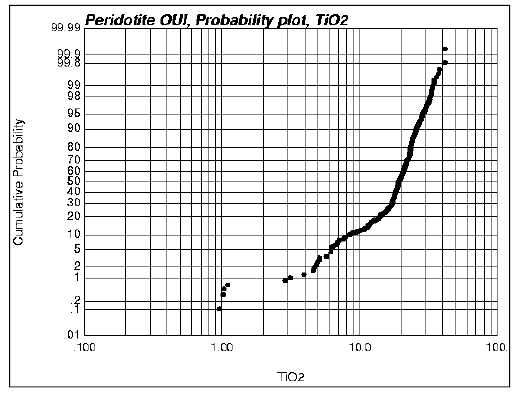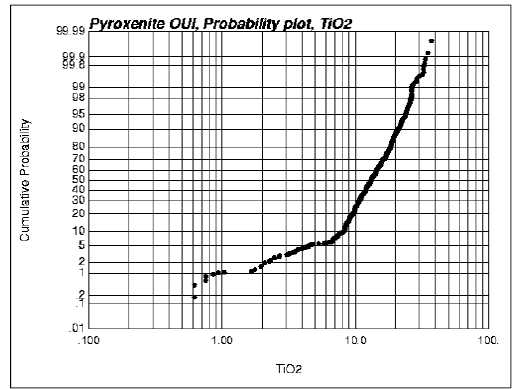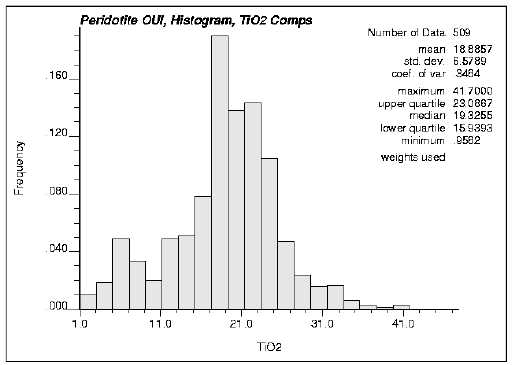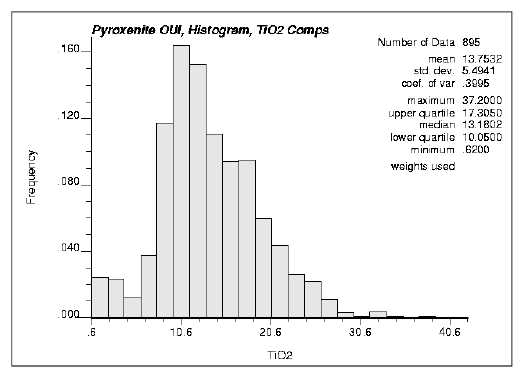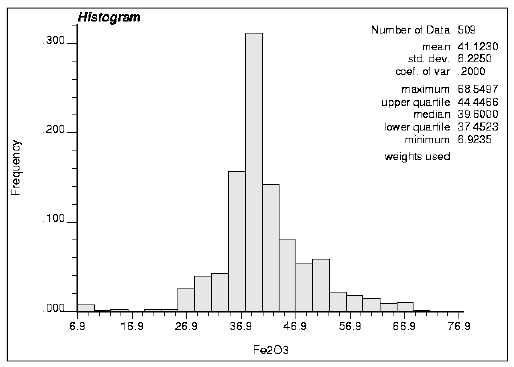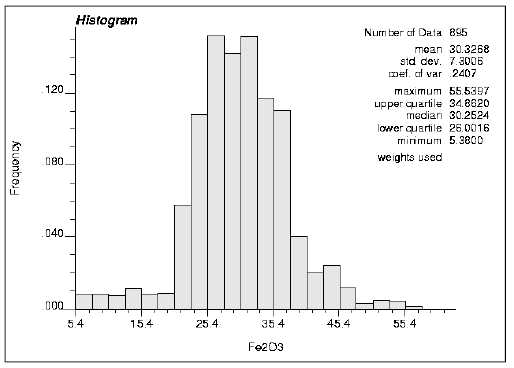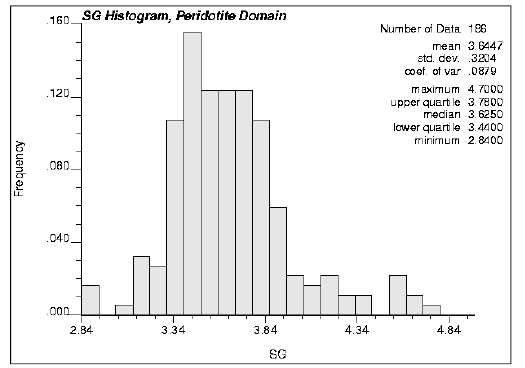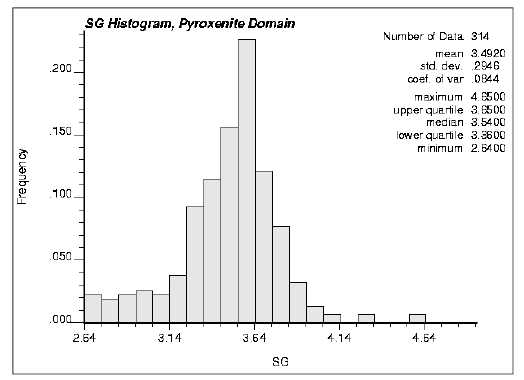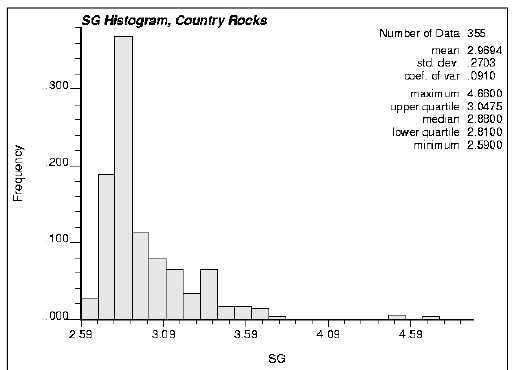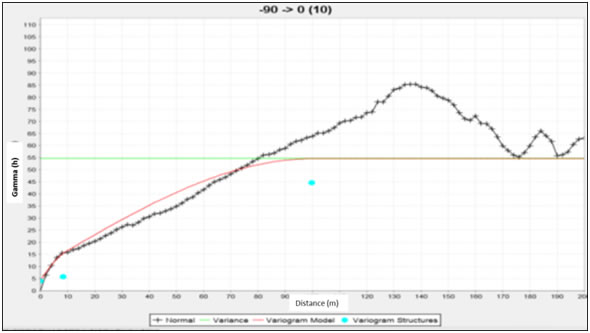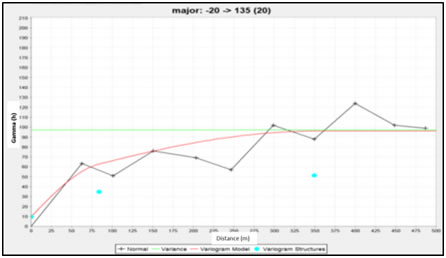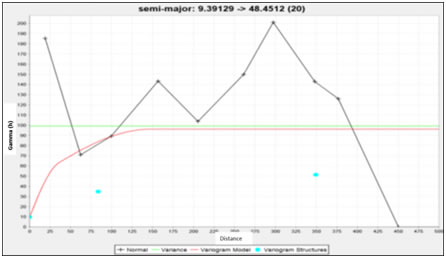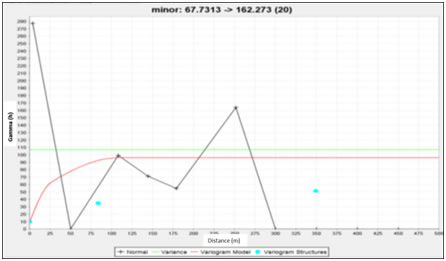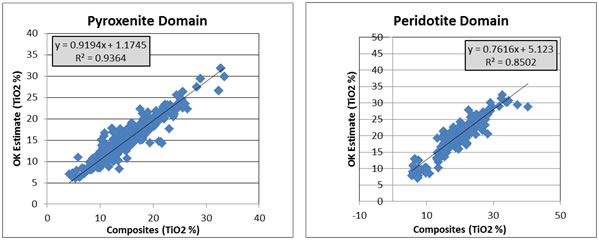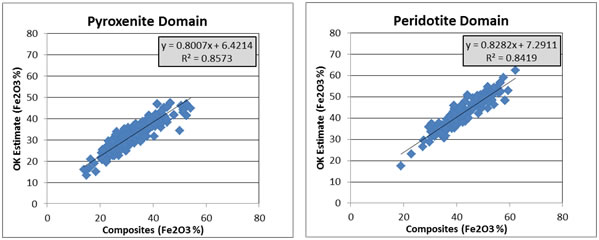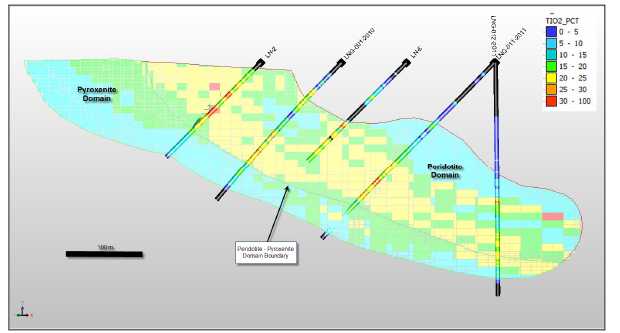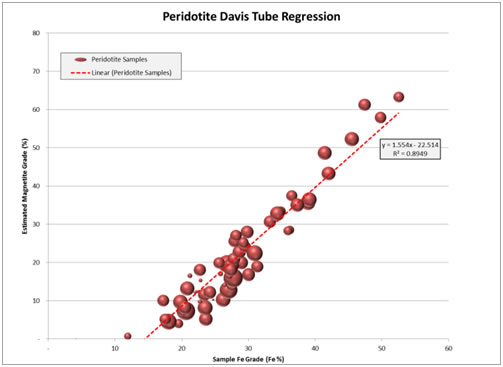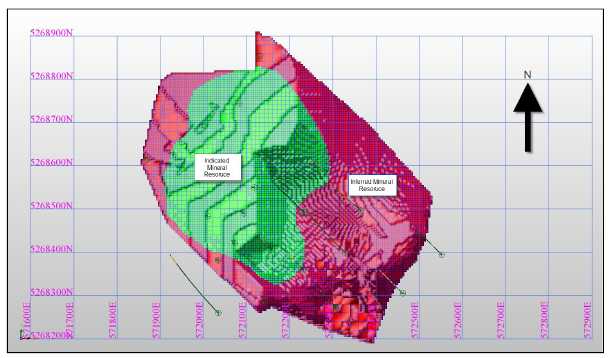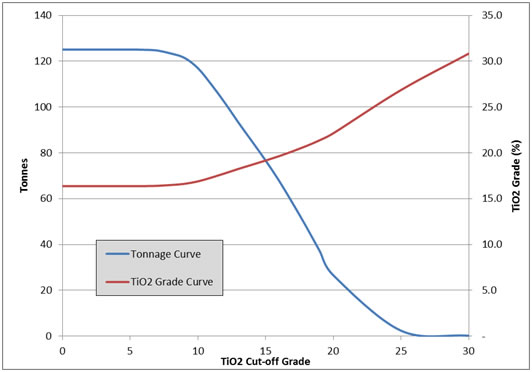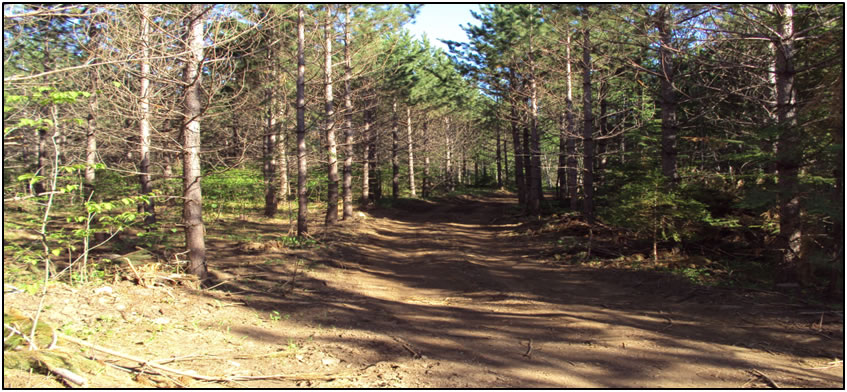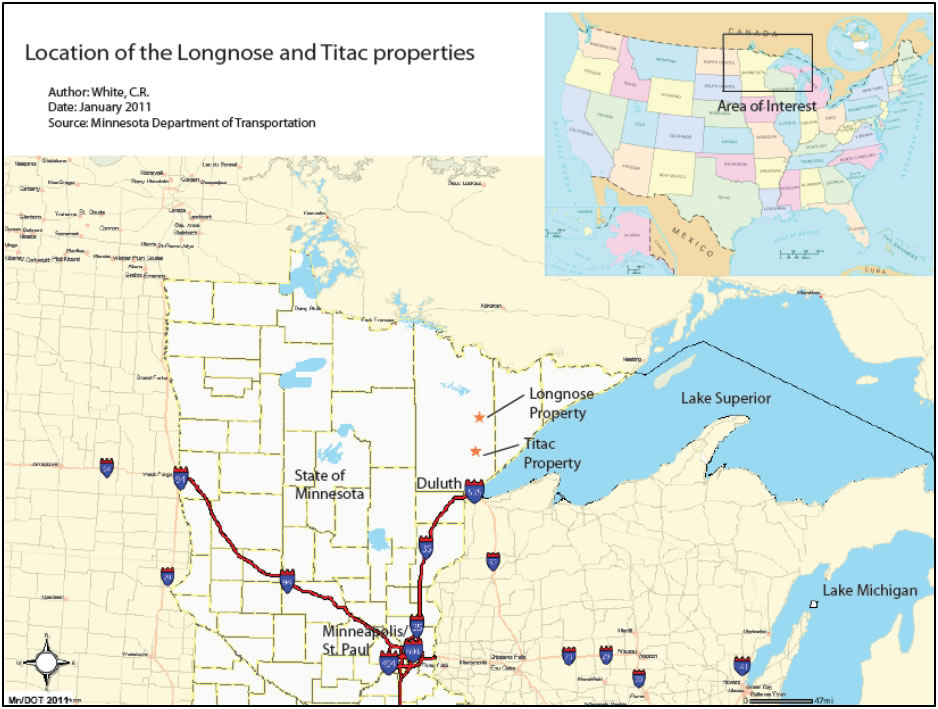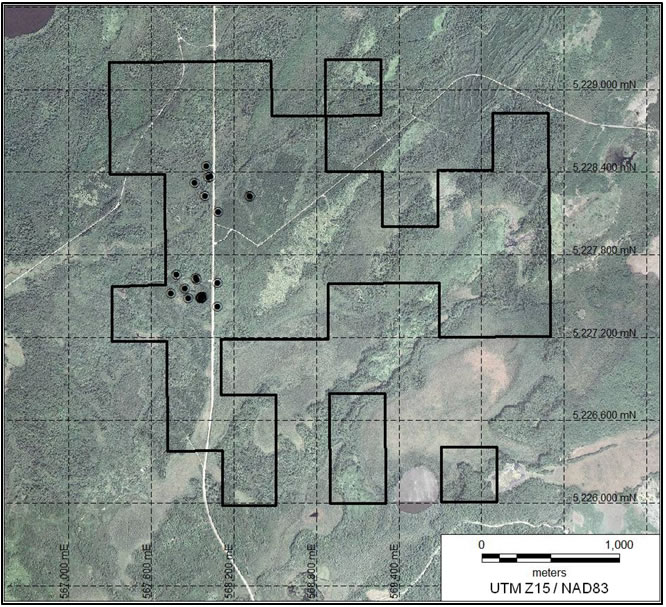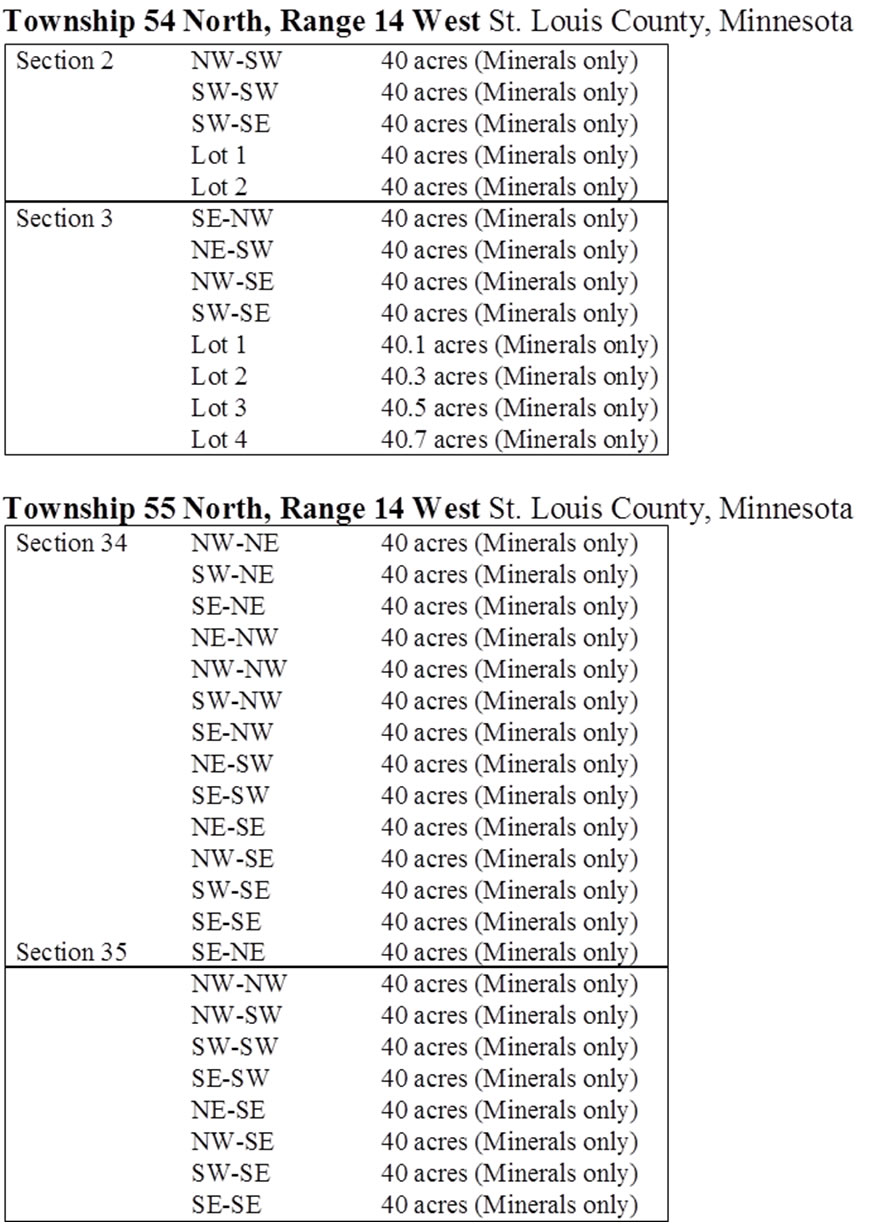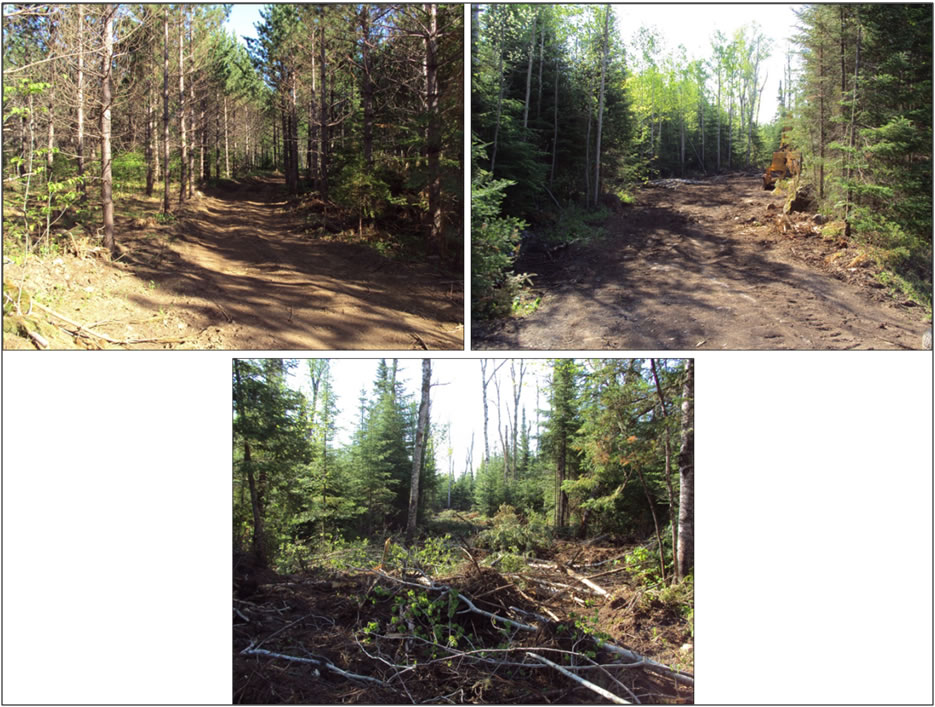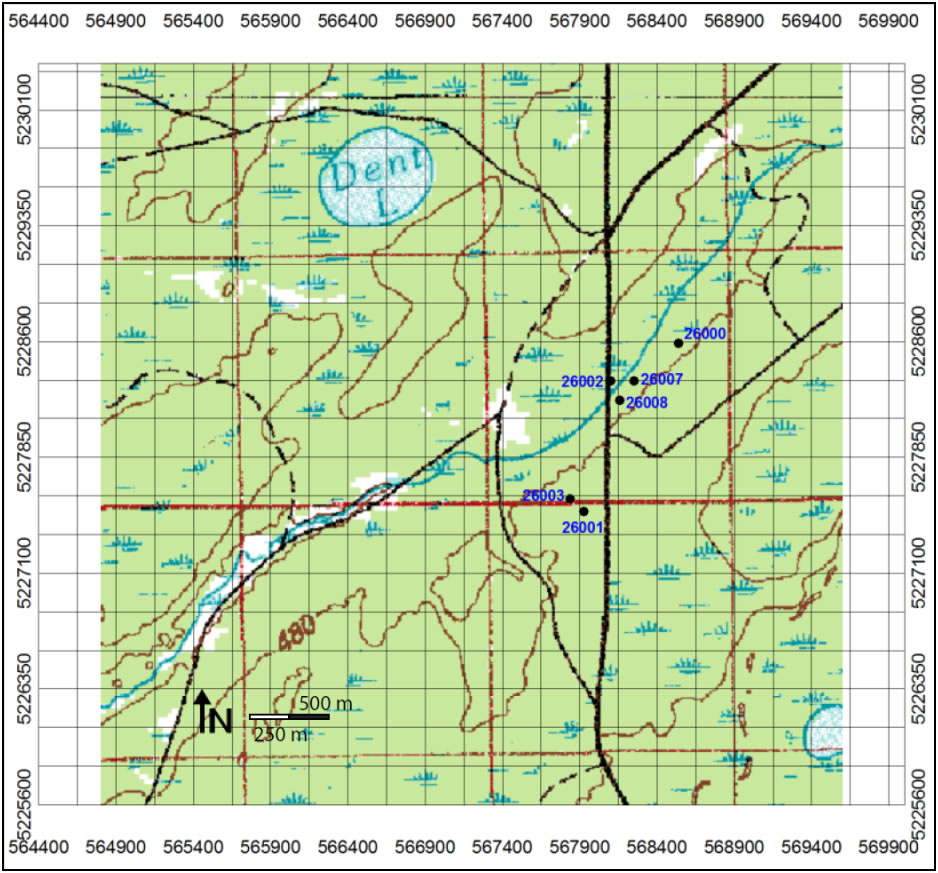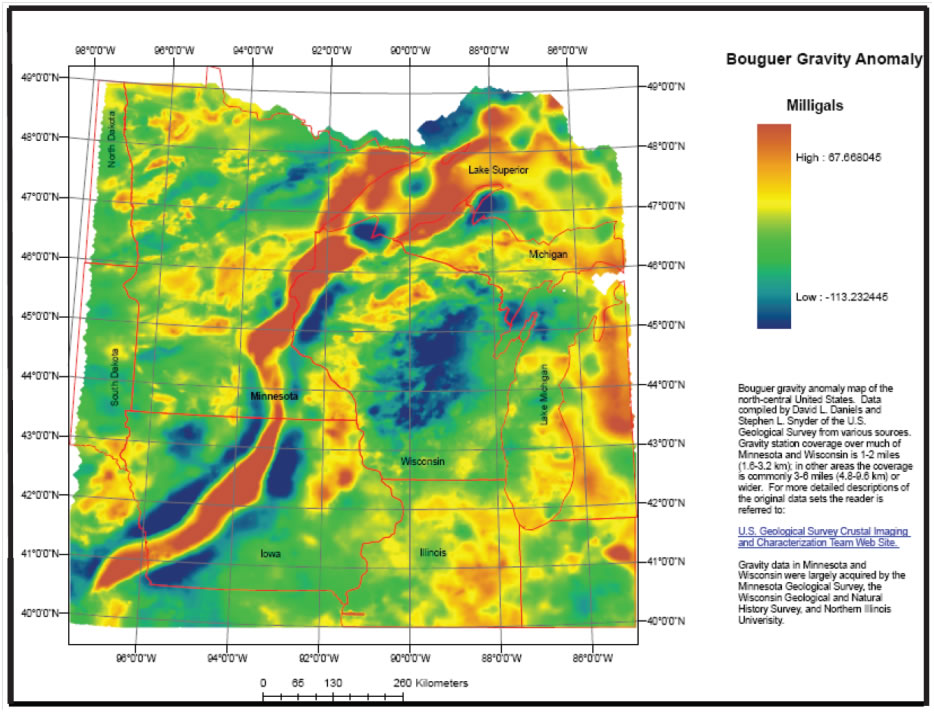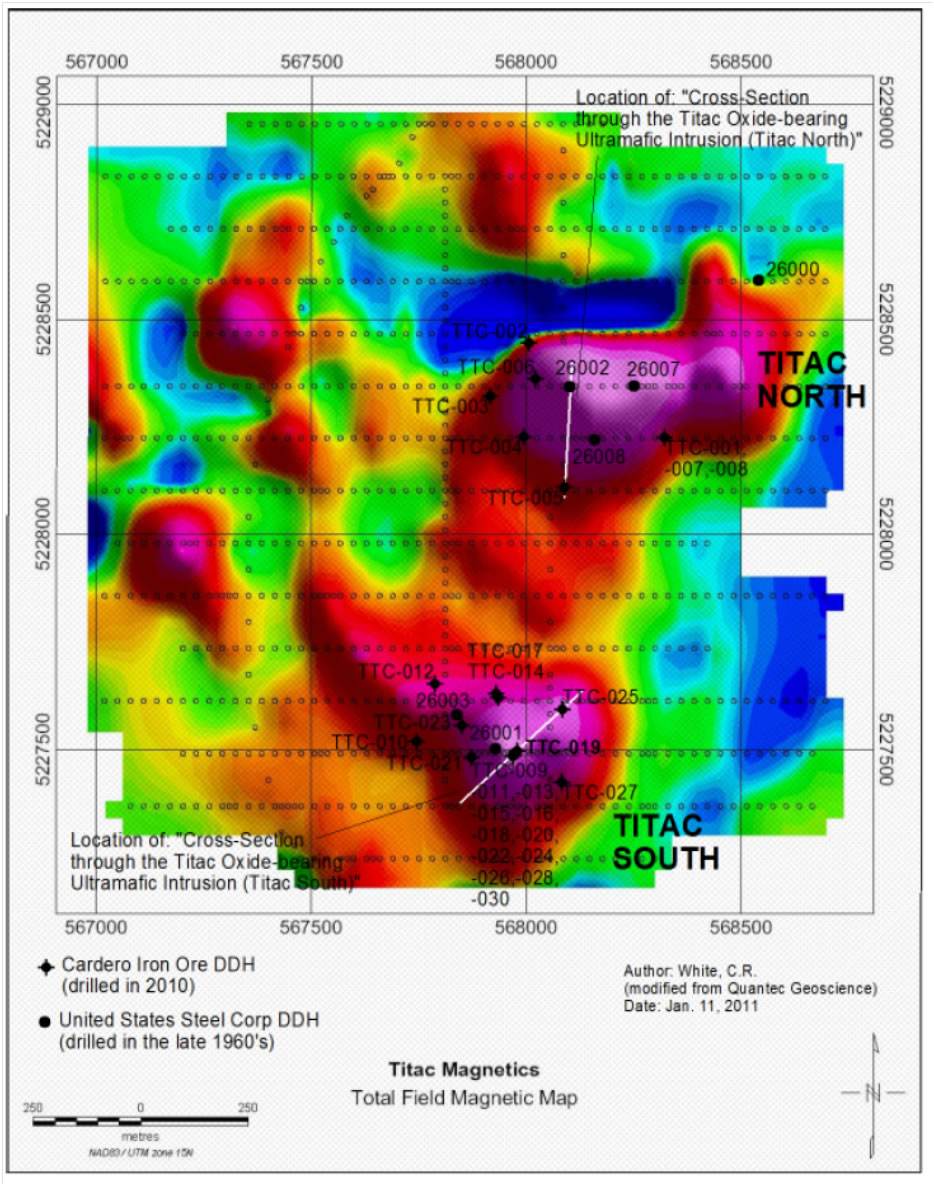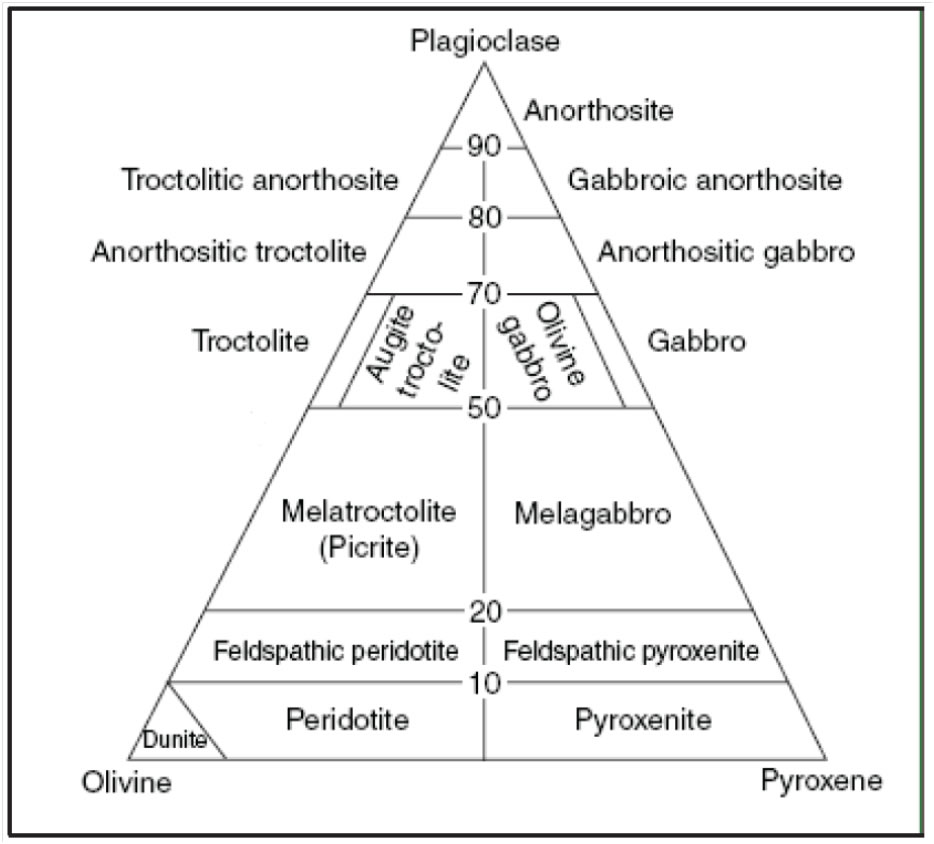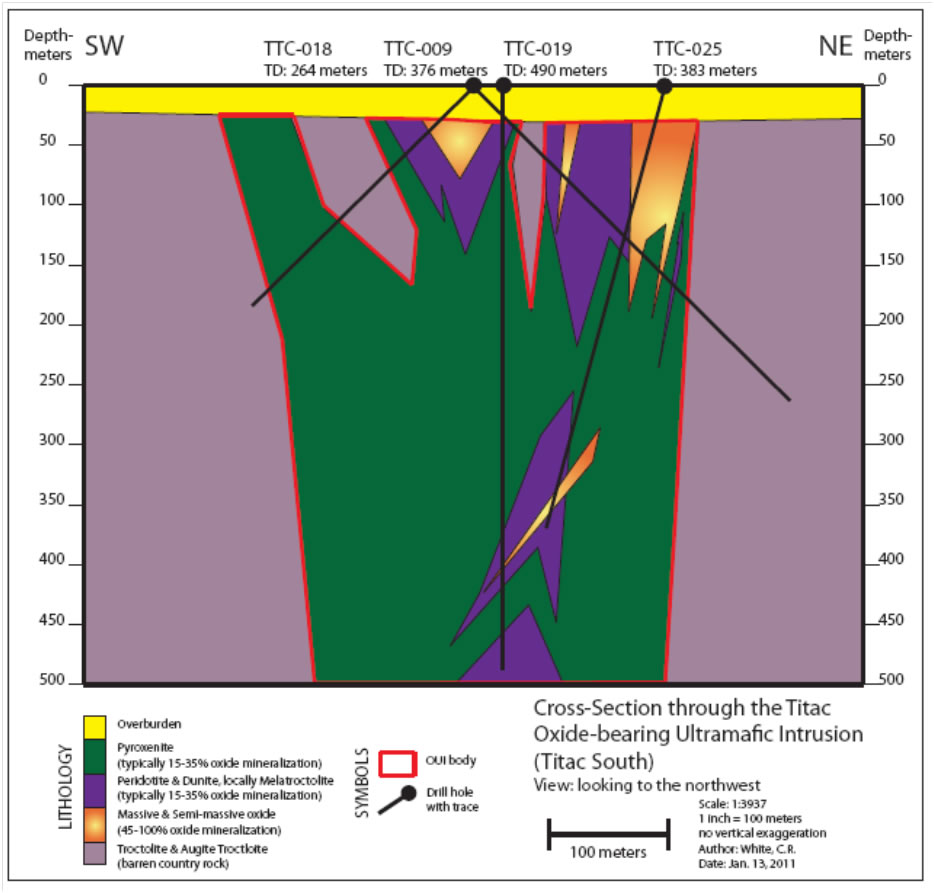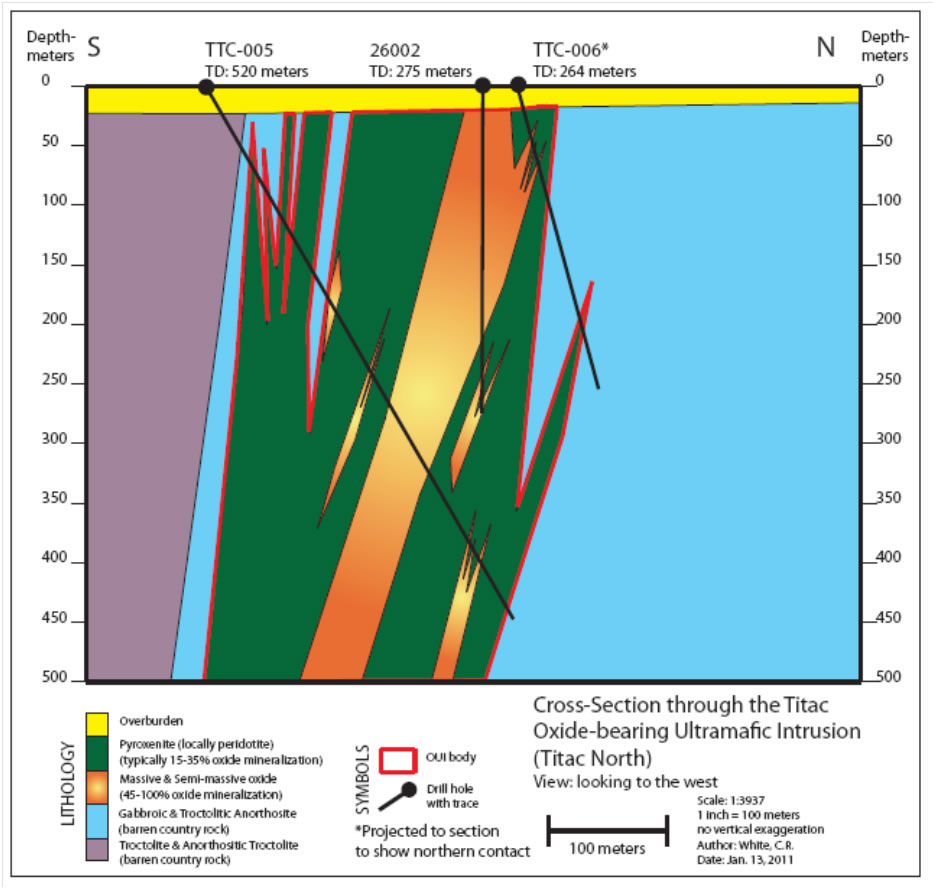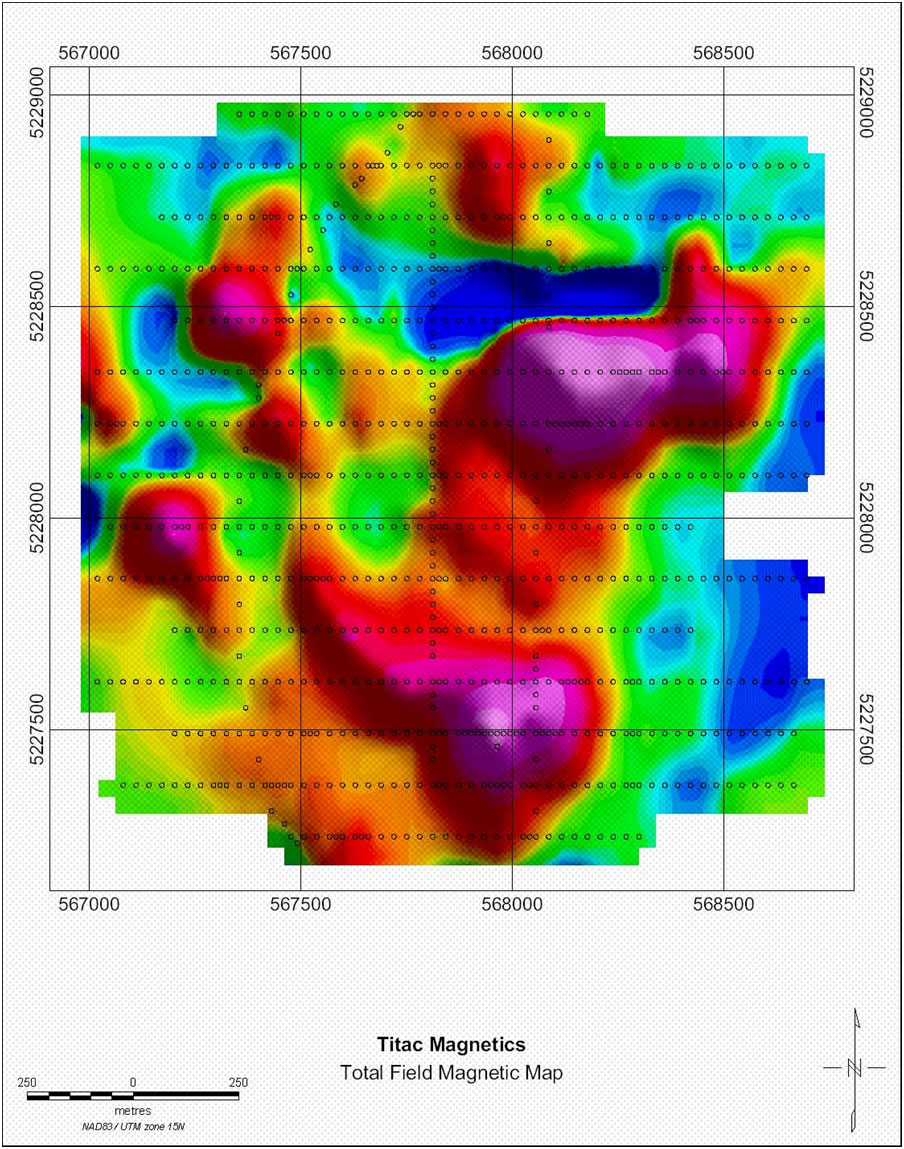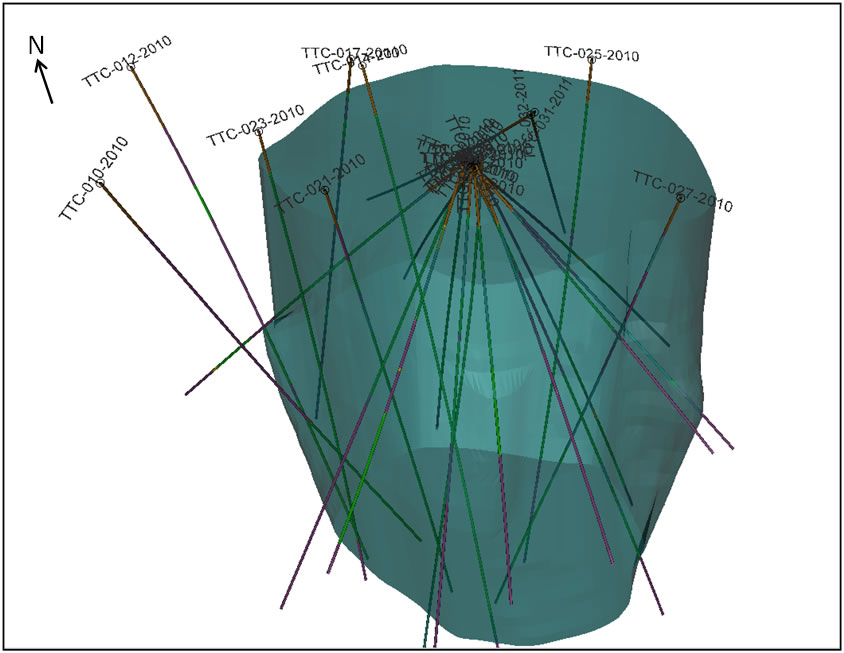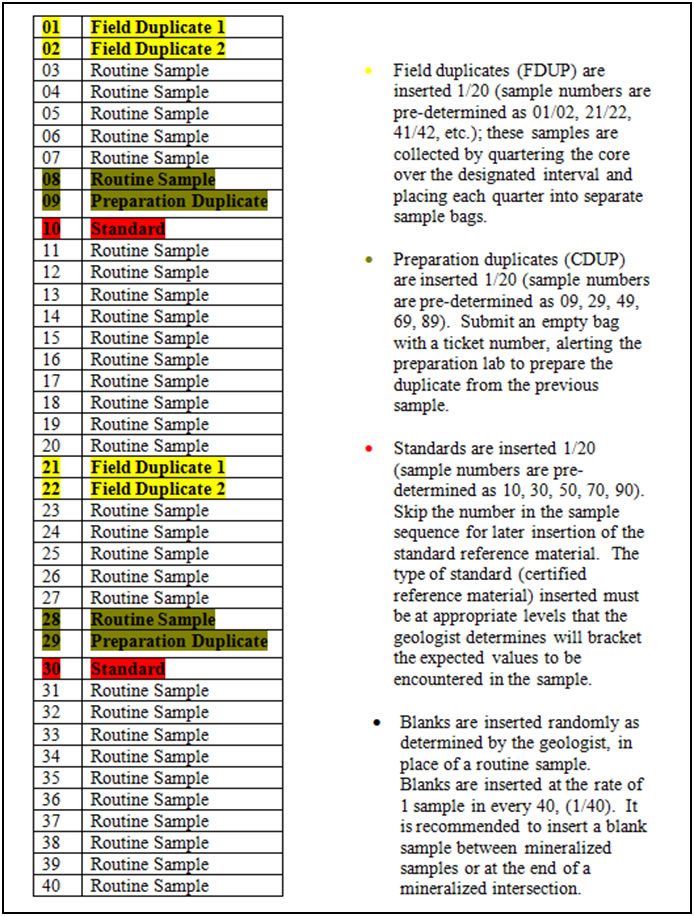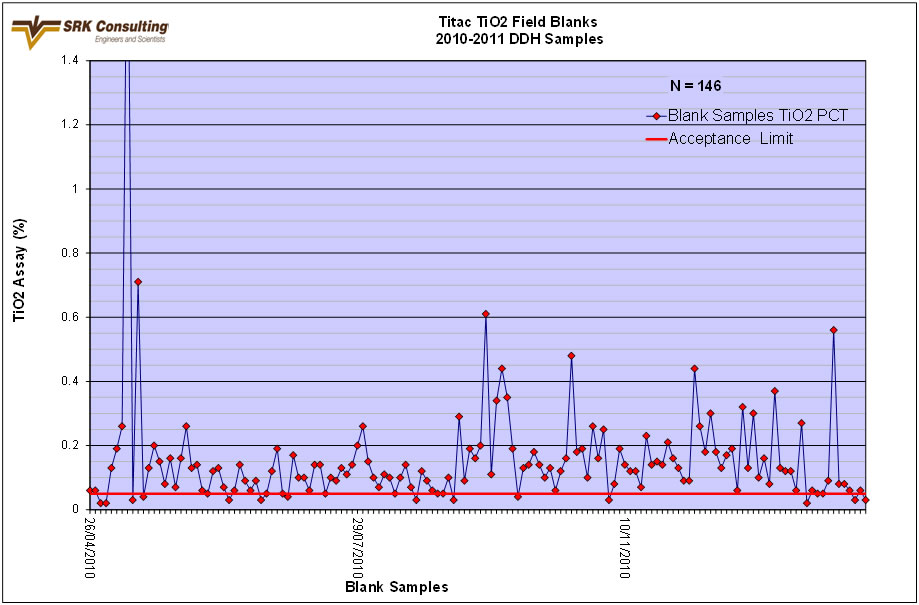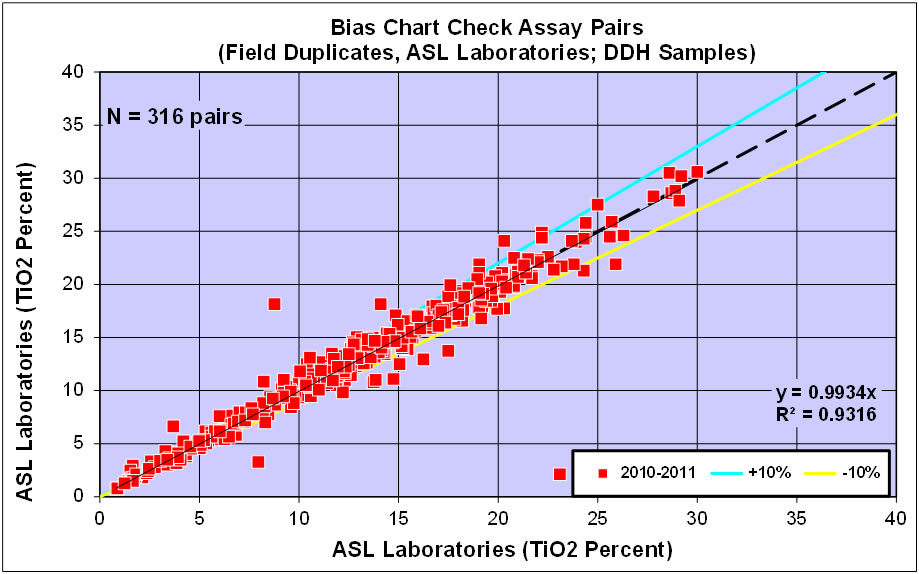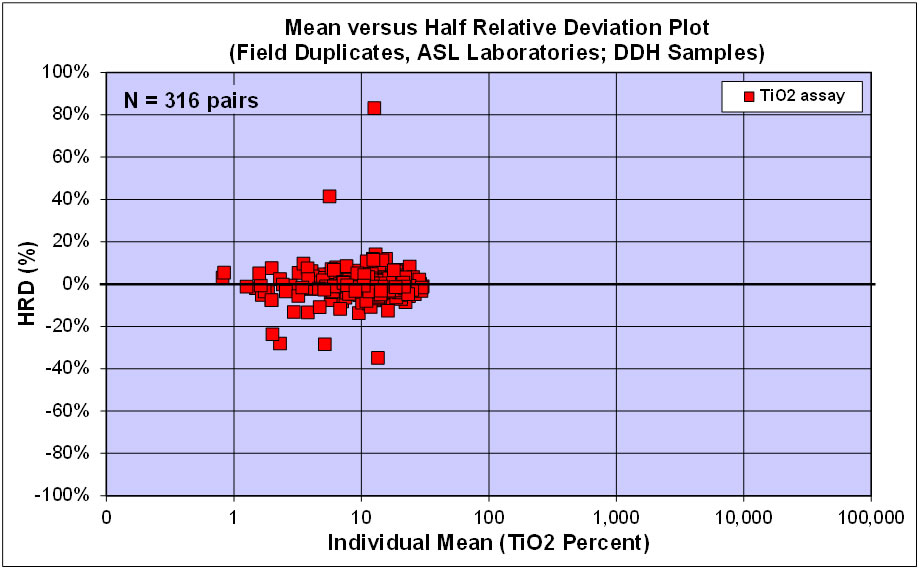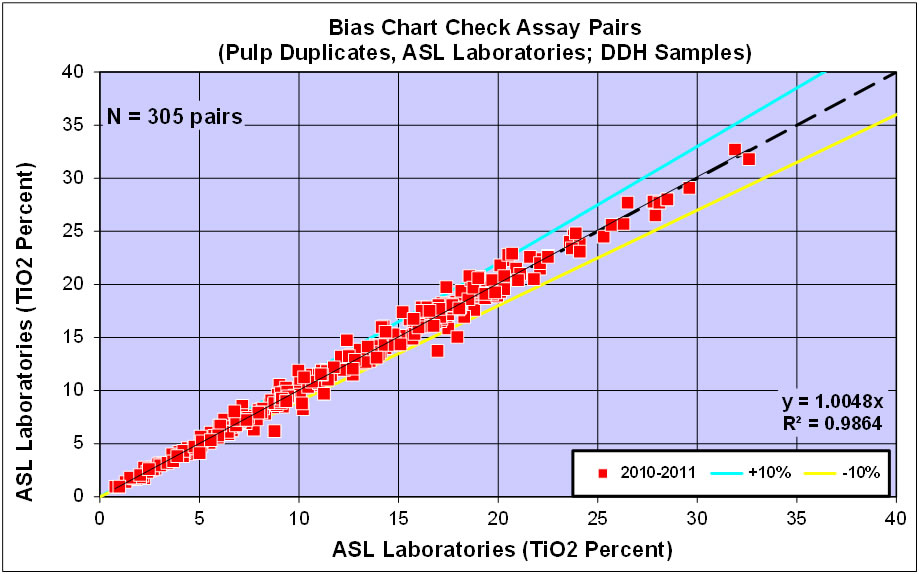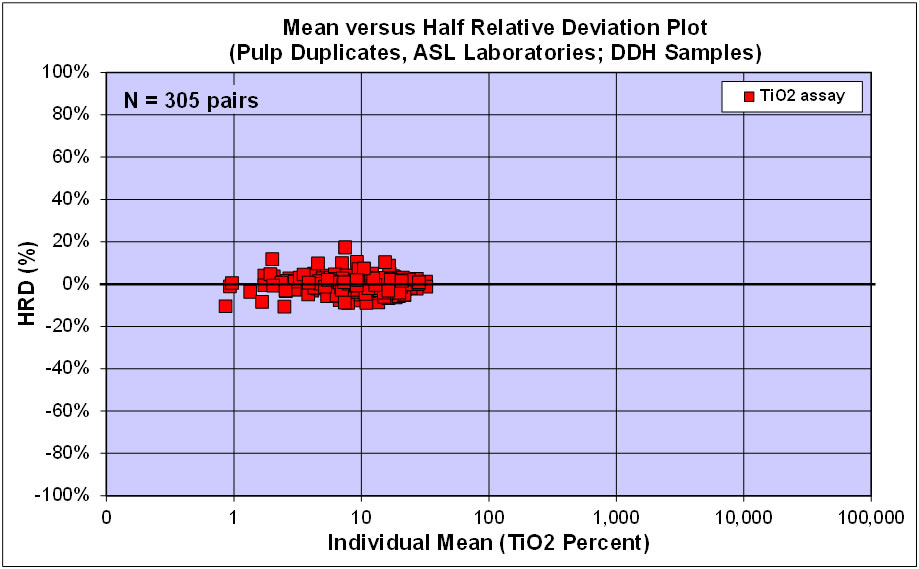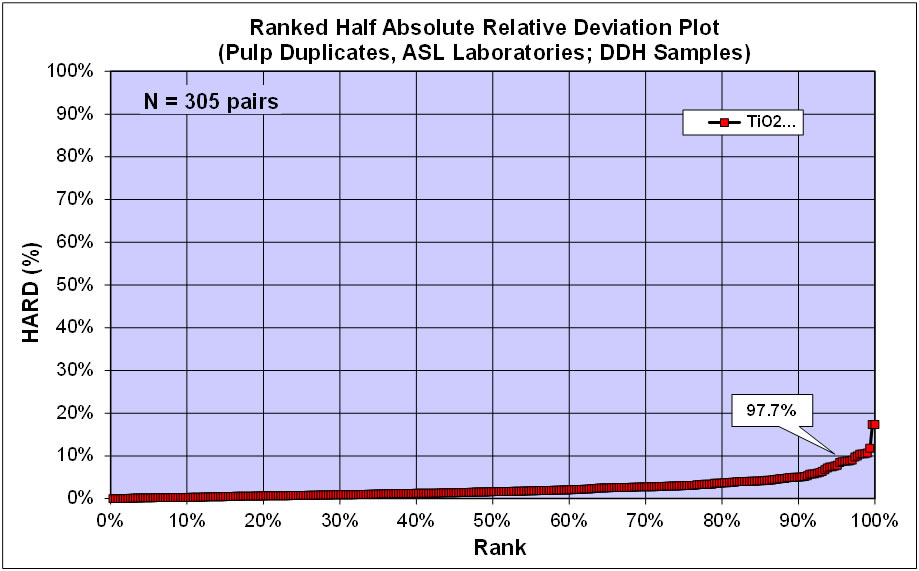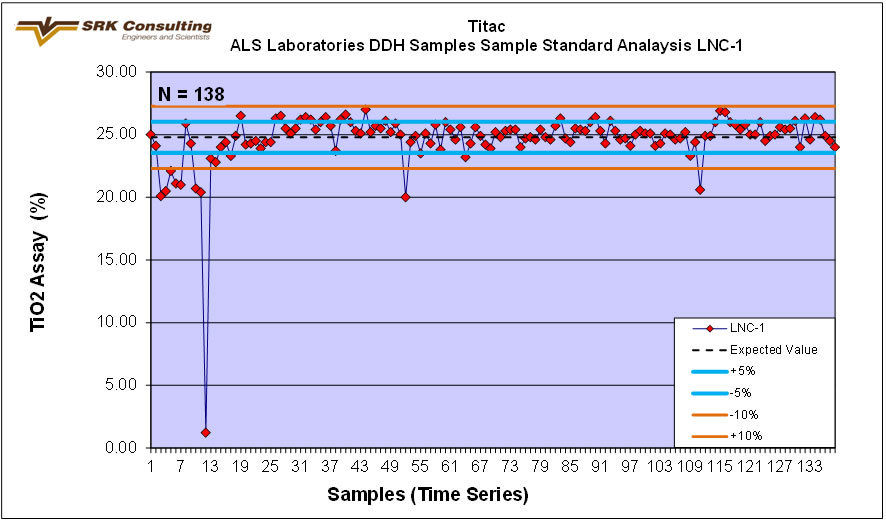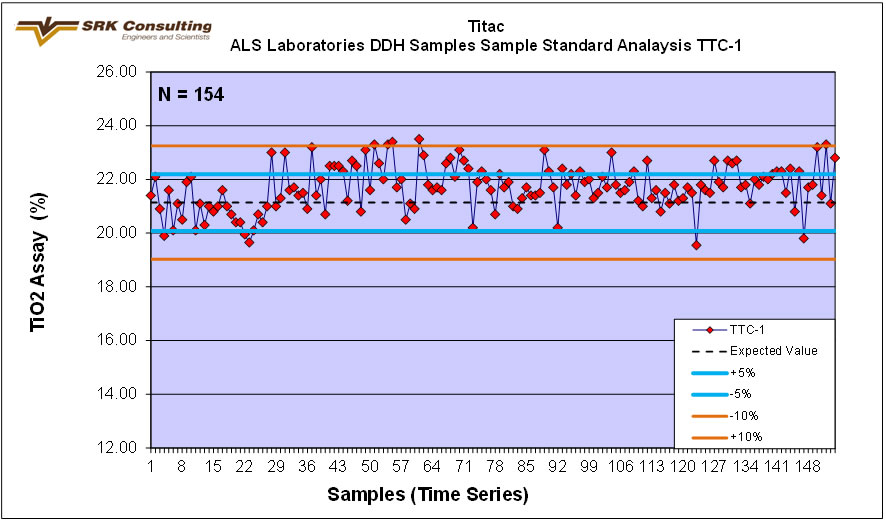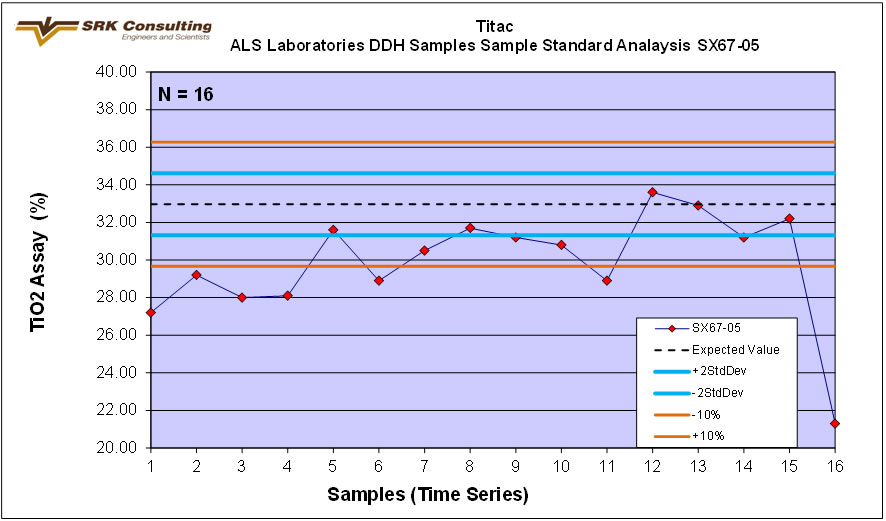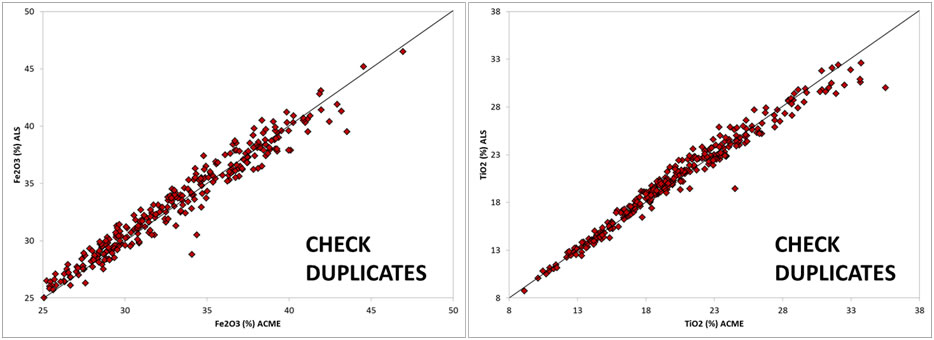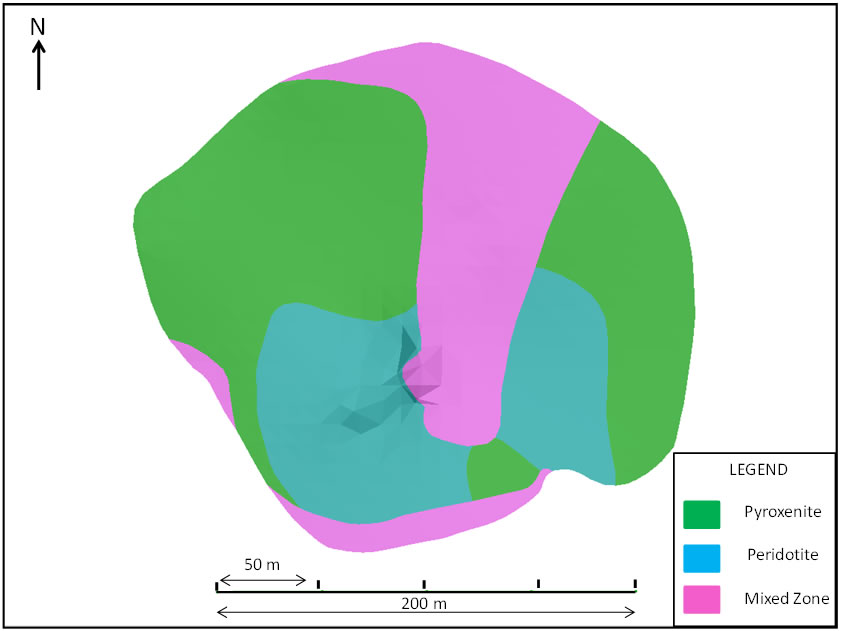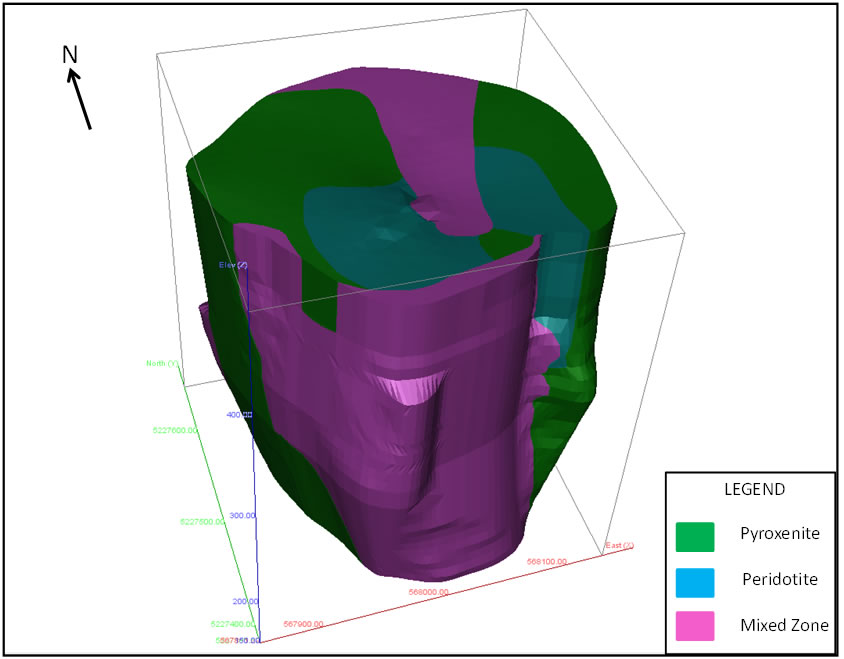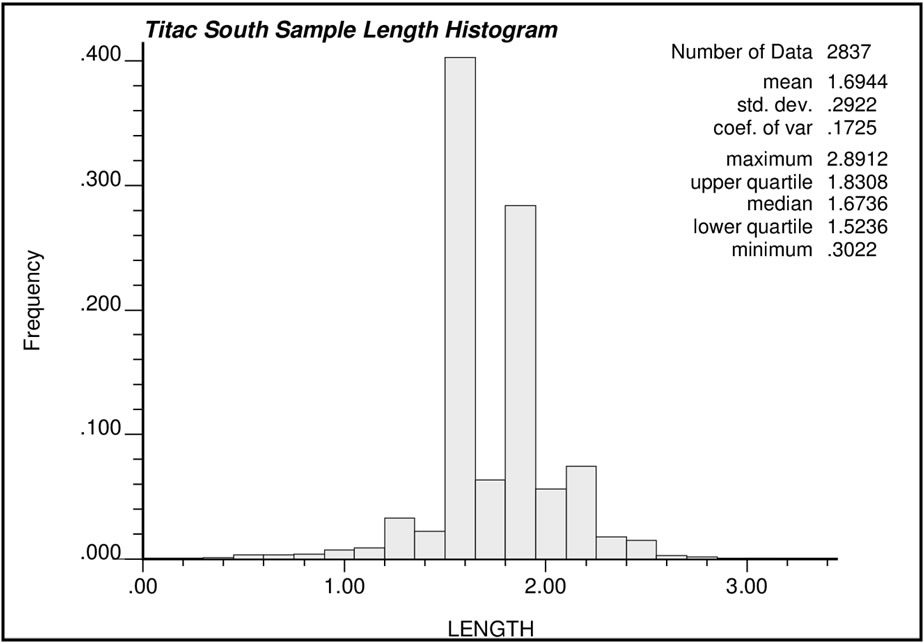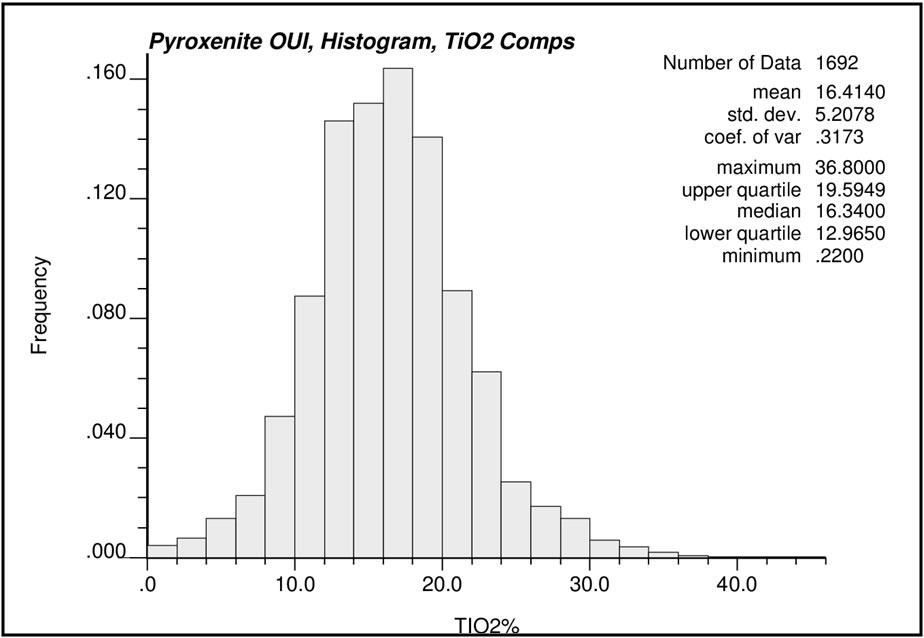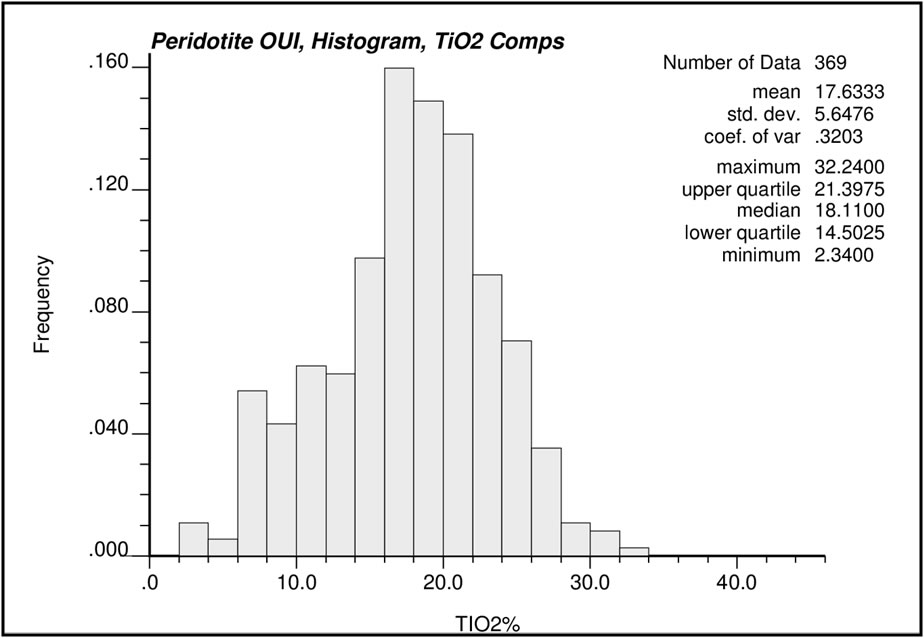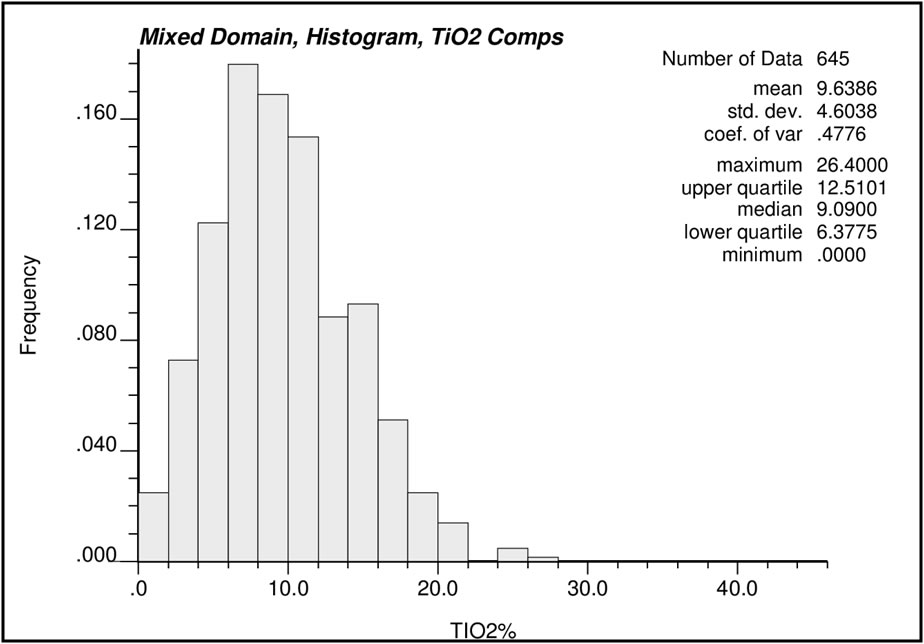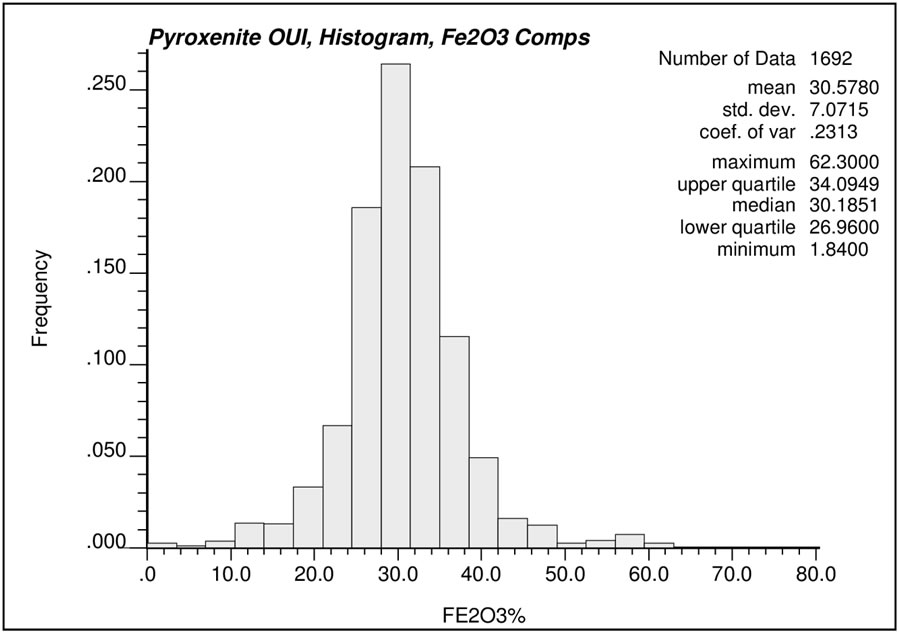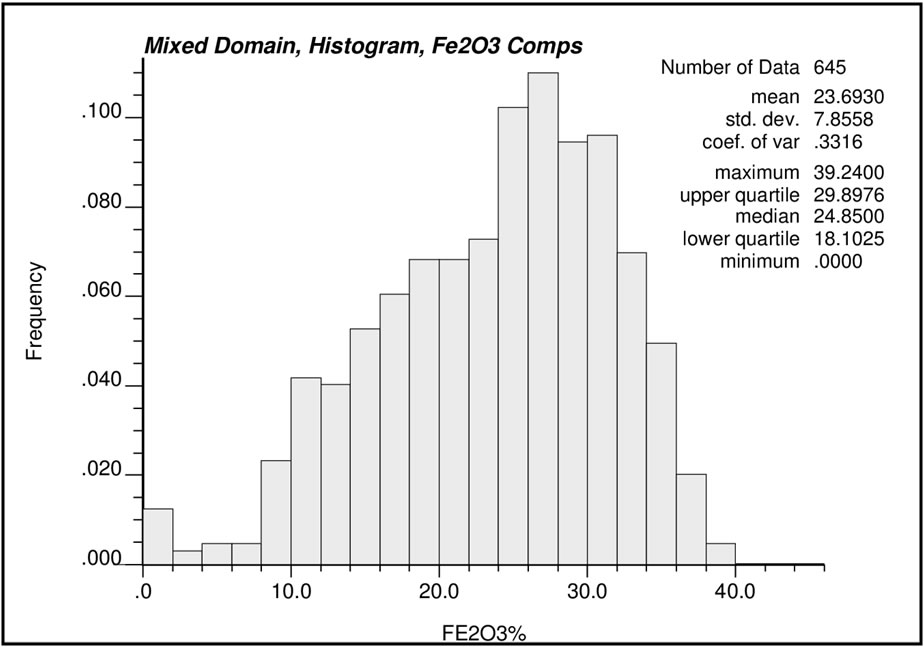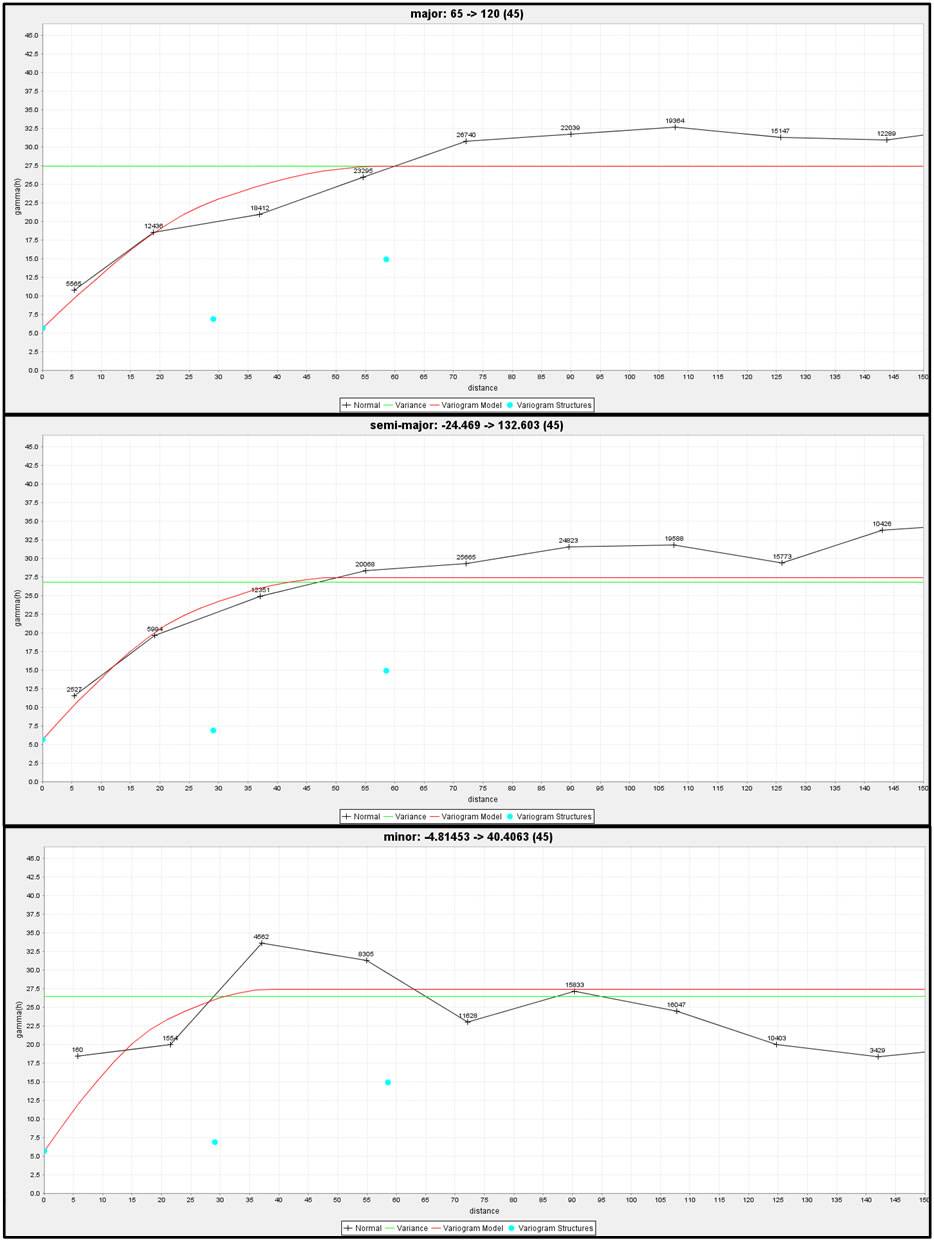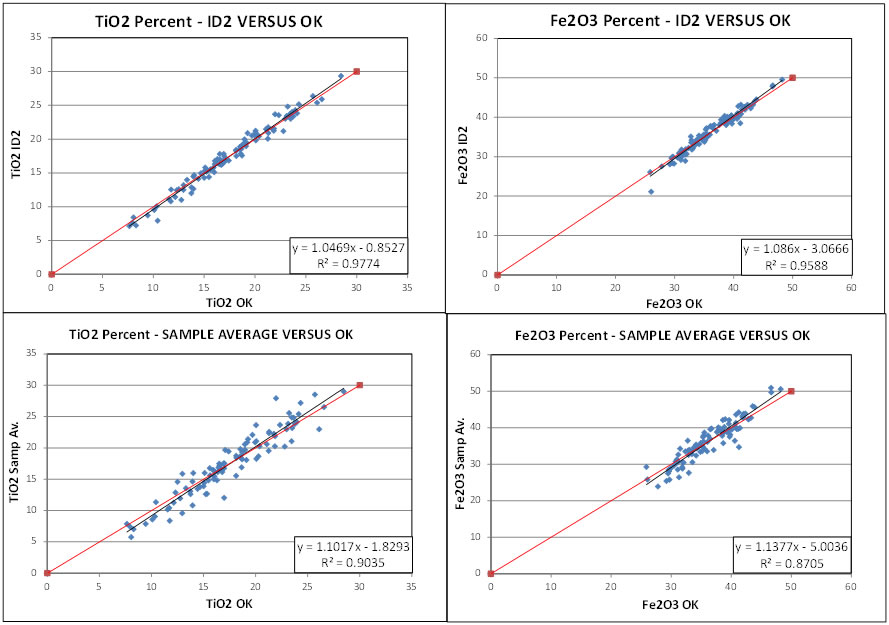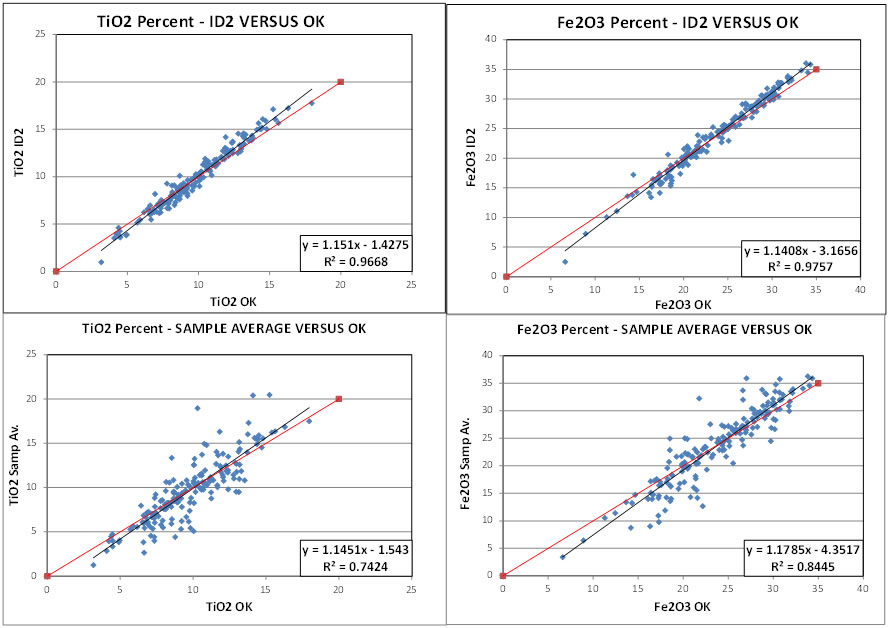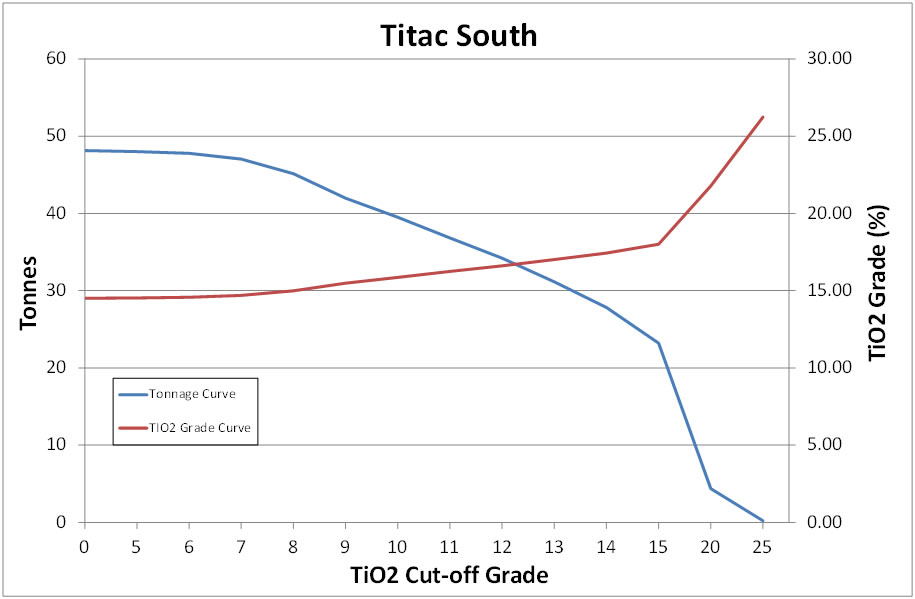ANNUAL INFORMATION FORM
FOR THE FISCAL YEAR ENDED
OCTOBER 31, 2011
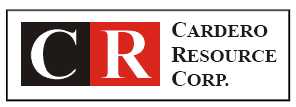
Suite 2300 – 1177 West Hastings Street
Vancouver, British
Columbia
V6E 2K3
January 26, 2012
ITEM 2 - TABLE OF CONTENTS
i
TABLE OF CONTENTS
(continued)
| Page | ||
| ITEM 15: | NAMES AND INTERESTS OF EXPERTS | 63 |
| Names and Interests of Experts | 63 | |
| ITEM 16: | ADDITIONAL INFORMATION | 64 |
| Audit Committee Information | 64 | |
| Additional Information | 64 | |
| SCHEDULE “A” – AUDIT COMMITTEE INFORMATION | ||
ii
PRELIMINARY NOTES
Documents Incorporated by Reference
Incorporated by reference into this Annual Information Form (“AIF”) are the following documents:
| (a) |
Consolidated Audited Financial Statements of the Company for the year ended October 31, 2011; | |
| (b) |
Management Discussion and Analysis of the Company for the year ended October 31, 2011 dated January 26, 2012 (“MD&A”); | |
| (c) |
Management Information Circular dated August 11, 2011 in respect of the 2011 Annual General Meeting (“Information Circular”); | |
| (d) |
Technical report dated December 6, 2011 entitled “Technical Report, Carbon Creek Coal Property, British Columbia, Canada” prepared by Norwest Corporation (the “Carbon Creek Report”); | |
| (e) |
Technical report dated January 18, 2012 entitled “Technical Report, Sheini Hills Iron Project, Ghana, Africa” prepared by Keith J. Henderson, EurGeol (the “Sheini Report”); | |
| (f) |
Technical report dated January 27, 2012, effective January 19, 2012, entitled “Technical Report on the Longnose Ilmenite Project, Minnesota, USA” prepared by SRK Consulting (Canada) Inc. (the “Longnose Report”); and | |
| (g) |
Technical report dated January 27, 2012, effective January 19, 2012, entitled “Technical Report on the Titac Ilmenite Exploration Project, Minnesota, USA” prepared by SRK Consulting (Canada) Inc. (the “Titac Report”); |
copies of which may be obtained online from SEDAR at www.sedar.com.
All financial information in this AIF is prepared in accordance with generally accepted accounting principles in Canada.
Date of Information
All information in this AIF is as of October 31, 2011 unless otherwise indicated.
Currency and Exchange Rates
All dollar amounts in this AIF are expressed in Canadian dollars unless otherwise indicated. The Company’s accounts are maintained in Canadian dollars and the Company’s financial statements are prepared in accordance with generally accepted accounting principles in Canada. All references to “U.S. dollars”, “USD” or to “US$” are to U.S. dollars, to “MXP” are to Mexican pesos, to “ARS” are to Argentinean pesos and to “PEN” are to Peruvian nuevo soles.
The following table sets forth the rate of exchange for the Canadian dollar, expressed in United States dollars in effect at the end of the periods indicated, the average of exchange rates in effect on the last day of each month during such periods, and the high and low exchange rates during such periods based on the noon rate of exchange as reported by the Bank of Canada for conversion of Canadian dollars into United States dollars.
- 4 -
| Year Ended October 31 | |||
| Canadian Dollars to U.S. Dollars | 2011 | 2010 | 2009 |
| Rate at end of period | USD 1.0065 | USD 0.9784 | USD 0.9282 |
| Average rate for period | USD 1.0139 | USD 0.9636 | USD 0.8552 |
| High for period | USD 1.0583 | USD 1.0039 | USD 0.9716 |
| Low for period | USD 0.9430 | USD 0.9278 | USD 0.7692 |
Metric Equivalents
For ease of reference, the following factors for converting Imperial measurements into metric equivalents are provided:
| To convert from Imperial | To metric | Multiply by |
| Acres | Hectares | 0.404686 |
| Feet | Metres | 0.30480 |
| Miles | Kilometres | 1.609344 |
| Tons | Tonnes | 0.907185 |
| Ounces (troy)/ton | Grams/Tonne | 34.2857 |
| 1 mile = 1.609 kilometres | 2000 pounds (1 short ton) = 0.907 tonnes |
| 1 acre = 0.405 hectares | 1 ounce (troy) = 31.103 grams |
| 2,204.62 pounds = 1 metric ton = 1 tonne | 1 ounce (troy)/ton = 34.2857 grams/tonne |
Terms used and not defined in this AIF that are defined in National Instrument 51-102 “Continuous Disclosure Obligations” shall bear that definition. Other definitions are set out in National Instrument 14-101 “Definitions”.
Forward-Looking Statements
This AIF contains forward-looking statements and forward-looking information (collectively, “forward-looking statements”) within the meaning of applicable Canadian and US securities legislation. These statements relate to future events or the future activities or performance of the Company. All statements, other than statements of historical fact, are forward-looking statements. Information concerning mineral resource estimates also may be deemed to be forward-looking statements in that it reflects a prediction of the mineralization that would be encountered if a mineral deposit were developed and mined. Forward-looking statements are typically identified by words such as: believe, expect, anticipate, intend, estimate, postulate, plans and similar expressions, or which by their nature refer to future events. These forward-looking statements include, but are not limited to, statements concerning:
-
the Company’s strategies and objectives, both generally and specifically in respect of the Carbon Creek property, the Sheini iron ore properties, and the Minnesota Iron/Titanium properties;
-
the ability of the Company to convert portions of the existing resource at the Carbon Creek property into the Measured & Indicated categories;
-
the ability of the Company to increase the global resource at the Carbon Creek property by including additional coal seams in the resource estimation;
- 5 -
-
the timing of decisions regarding the timing and costs of exploration programs with respect to, and the issuance of the necessary permits and authorizations required for, the Company’s ongoing exploration programs on its properties;
-
the Company’s estimates of the quality and quantity of the resources at its mineral properties;
-
the timing and cost of the planned future exploration programs at the Minnesota Iron/Titanium and Carbon Creek properties, and the timing of the receipt of results therefrom;
-
the Company’s future cash requirements;
-
general business and economic conditions;
-
the Company’s ability to meet its financial obligations as they come due, and to be able to raise the necessary funds to continue operations; and
-
the Company’s ability to negotiate acceptable option/joint venture agreements for some or all of its “non-core” properties.
Although the Company believes that such statements are reasonable, it can give no assurance that such expectations will prove to be correct. Inherent in forward-looking statements are risks and uncertainties beyond the Company’s ability to predict or control, including, but not limited to, risks related to the Company’s inability to identify one or more economic deposits on its properties, variations in the nature, quality and quantity of any mineral deposits that may be located, variations in the market price of any mineral products the Company may produce or plan to produce, the Company’s inability to obtain any necessary permits, consents or authorizations required for its activities, to produce minerals from its properties successfully or profitably, to continue its projected growth, to raise the necessary capital or to be fully able to implement its business strategies, and other risks identified herein under “Risk Factors”. The Company cautions investors that any forward-looking statements by the Company are not guarantees of future performance, and that actual results are likely to differ, and may differ materially, from those expressed or implied by forward-looking statements contained in this AIF. Such statements are based on a number of assumptions which may prove incorrect, including, but not limited to, assumptions about:
-
the level and volatility of the price of commodities, and iron ore, coal, vanadium and titanium in particular;
-
general business and economic conditions;
-
the timing of the receipt of regulatory and governmental approvals, permits and authorizations necessary to implement and carry on the Company’s planned exploration programs, particularly at the Minnesota Iron/Titanium and Carbon Creek property;
-
conditions in the financial markets generally;
-
the Company’s ability to secure the necessary consulting, drilling and related services and supplies on favourable terms in connection with its ongoing and planned exploration programs;
-
the Company’s ability to attract and retain key staff;
-
the accuracy of the Company’s resource estimates (including with respect to size and grade) and the geological, operational and price assumptions on which these are based;
-
the timing of the ability to commence and complete the planned work at the Carbon Creek property;
- 6 -
-
the anticipated terms of the consents, permits and authorizations necessary to carry out the planned exploration programs at the Company’s properties and the Company’s ability to comply with such terms on a safe and cost-effective basis;
-
the ongoing relations of the Company with its underlying optionors/lessors and the applicable regulatory agencies;
-
that the metallurgy and recovery characteristics of samples from certain of the Company’s mineral properties are reflective of the deposit as a whole;
-
the Company’s ability to negotiate and enter into appropriate off-take agreements for the potential products from Carbon Creek; and
-
the Company’s ability to overcome any potential difficulties in adapting pilot scale operations and testing to commercial scale operations.
In addition, in carrying out the resource estimation with respect to the Carbon Creek project, as described under “Narrative Description of the Business - Material Mineral Projects – Carbon Creek Metallurgical Coal Deposit, British Columbia, Canada”, a number of assumptions have been made, which are more particularly described in that section.
These forward-looking statements are made as of the date hereof and the Company does not intend and does not assume any obligation to update these forward-looking statements, except as required by applicable law. For the reasons set forth above, investors should not attribute undue certainty to or place undue reliance on forward-looking statements.
Caution Regarding Adjacent or Similar Mineral Properties
This AIF contains information with respect to adjacent or similar mineral properties in respect of which the Company has no interest or rights to explore or mine. The Company advises US investors that the mining guidelines of the US Securities and Exchange Commission (the “SEC”) set forth in the SEC’s Industry Guide 7 (“SEC Industry Guide 7”) strictly prohibit information of this type in documents filed with the SEC. Because Cardero meets the definition of a “foreign private issuer” under applicable SEC rules and is preparing this AIF pursuant to Canadian disclosure requirements under the Canada-U.S. Multi-Jurisdictional Disclosure System, this AIF is not subject to the requirements of SEC Industry Guide 7. Readers are cautioned that the Company has no interest in or right to acquire any interest in any such properties, and that mineral deposits on adjacent or similar properties are not indicative of mineral deposits on the Company’s properties.
Caution Regarding Reference to Resources and Reserves
National Instrument 43-101 Standards of Disclosure of Mineral Projects (“NI 43-101”) is a rule developed by the Canadian Securities Administrators which establishes standards for all public disclosure an issuer makes of scientific and technical information concerning mineral projects. Unless otherwise indicated, all reserve and resource estimates contained in or incorporated by reference in this AIF have been prepared in accordance with NI 43-101 and the guidelines set out in the Canadian Institute of Mining, Metallurgy and Petroleum (the “CIM”) Standards on Mineral Resource and Mineral Reserves, adopted by the CIM Council on November 14, 2004 (the “CIM Standards”) as they may be amended from time to time by the CIM.
United States investors are cautioned that the requirements and terminology of NI 43-101 and the CIM Standards differ significantly from the requirements and terminology set forth in SEC Industry Guide 7. Accordingly, the Company’s disclosures regarding mineralization may not be comparable to similar information disclosed by companies subject to SEC Industry Guide 7. Without limiting the foregoing, while the terms “mineral resources”, “inferred mineral resources”, “indicated mineral resources” and “measured mineral resources” are recognized and required by NI 43-101 and the CIM Standards, they are not recognized by the SEC and are not permitted to be used in documents filed with the SEC by companies subject to SEC Industry Guide 7. Mineral resources which are not mineral reserves do not have demonstrated economic viability, and US investors are cautioned not to assume that all or any part of a mineral resource will ever be converted into reserves. Further, inferred resources have a great amount of uncertainty as to their existence and as to whether they can be mined legally or economically. It cannot be assumed that all or any part of the inferred resources will ever be upgraded to a higher resource category. Under Canadian rules, estimates of inferred mineral resources may not form the basis of a feasibility study or prefeasibility study, except in rare cases. The SEC normally only permits issuers to report mineralization that does not constitute SEC Industry Guide 7 compliant “reserves” as in-place tonnage and grade without reference to unit amounts. The term “contained ounces” is not permitted under the rules of SEC Industry Guide 7. In addition, the NI 43-101 and CIM Standards definition of a “reserve” differs from the definition in SEC Industry Guide 7. In SEC Industry Guide 7, a mineral reserve is defined as a part of a mineral deposit which could be economically and legally extracted or produced at the time the mineral reserve determination is made. The SEC has taken the position that mineral reserves for a mineral property may not be designated unless: (i) competent professional engineers conduct a detailed engineering and economic study, and the “bankable” or “final” feasibility study demonstrates that a mineral deposit can be mined profitably at a commercial rate; (ii) a historic three-year average commodity price is used in any reserve or cash flow analysis used to designate reserves; and (iii) the company has demonstrated that the mineral property will receive its governmental permits, and the primary environmental document has been filed with the appropriate governmental authorities. See “Glossary of Terms”.
- 7 -
Caution Regarding Historical Results
Historical results of operations and trends that may be inferred from the discussion and analysis in this AIF may not necessarily indicate future results from operations. In particular, the current state of the global securities markets may cause significant reductions in the price of the Company’s securities and render it difficult or impossible for the Company to raise the funds necessary to continue operations. See “Risk Factors – Share Price Volatility”.
Glossary of Terms
The following is a glossary of certain mining and other terms used in this AIF:
| “aeolian” |
Caused or carried by the wind |
| “Ag” |
Silver |
| “alteration” |
Changes in the chemical or mineralogical composition of a rock, generally produced by weathering or hydrothermal solutions |
| “anomalous” |
Departing from the expected or normal |
| “anomaly” |
A geological feature, especially in the subsurface, distinguished by geological, geophysical or geochemical means, which is different from the general surroundings and is often of potential economic value |
| “As” |
Arsenic |
| “Au” |
Gold |
| “breccia” |
Angular broken rock fragments held together by a mineral cement or a fine- grained matrix |
- 8 -
| “Cardero Argentina” |
Cardero Argentina, S.A., a wholly owned Argentinean subsidiary of Cardero |
|
| |
| “Cardero Chile” |
Compania Minera Cardero Chile Limitada, a wholly owned Chilean subsidiary of Cardero |
|
| |
| “Cardero Coal” |
Cardero Coal Ltd., a wholly owned British Columbia subsidiary of Cardero |
|
| |
| “Cardero Ghana” |
Cardero Ghana Ltd., a wholly owned Ghana subisidary of Cardero Iron Ghana BVI |
|
| |
| “Cardero Hierro BVI” |
Cardero Hierro Peru (BVI) Ltd., a wholly owned British Virgin Islands subsidiary of Cardero Iron BVI |
|
| |
| “Cardero Hierro Peru” |
Cardero Hierro del Peru, S.A.C., a wholly owned Peruvian subsidiary of Cardero Hierro BVI |
|
| |
| “Cardero Iron” |
Cardero Iron Ore Company Ltd., a wholly owned British Columbia subsidiary of Cardero |
|
| |
| “Cardero Iron BVI” |
Cardero Iron Ore Company (BVI) Ltd., a wholly owned British Virgin Islands subsidiary of Cardero Iron |
|
| |
| “Cardero Iron Ghana” |
Cardero Iron Ore Ghana (BVI) Ltd., a wholly owned British Virgin Islands subsidiary of Cardero Iron BVI |
|
| |
| “Cardero Iron USA” |
Cardero Iron Ore (USA) Inc., a wholly owned Delaware subsidiary of Cardero Iron |
|
| |
| “Cardero Management USA” |
Cardero Iron Ore Management (USA) Inc., a wholly owned Delaware subsidiary of Cardero Iron |
|
| |
| “Cardero Peru” |
Cardero Peru, S.A.C., a wholly owned Peruvian subsidiary of Cardero |
|
| |
| “cateo” |
A cateo is an exploration concession, granted under Argentine mining law, which does not permit mining but gives the owner a preferential right to apply for a mining concession (mina) for the some or all of the area of the cateo following a discovery. Cateos are measured in 500 hectare unit areas, and a single cateo cannot exceed 20 units (10,000 hectares) |
|
| |
| “CCDL” |
Cerro Colorado Development Ltd., a wholly owned British Columbia subsidiary of Cardero |
|
| |
| “clastic” |
Pertaining to a rock or sediment composed principally of fragments derived from pre-existing rocks or minerals and transported some distance from their places of origin; also said of the texture of such a rock |
|
| |
| “cm” |
Centimetres |
|
| |
| “Co” |
Cobalt |
- 9 -
| “Common Shares” |
The common shares without par value in the capital stock of Cardero as the same are constituted on the date hereof |
|
| |
| “conglomerate” |
A coarse grained clastic sedimentary rock, composed of rounded to sub-angular fragments larger than 2mm in diameter set in a fine-grained matrix of sand or silt, and commonly cemented by calcium carbonate, iron oxide, silica or hardened clay |
|
| |
| “Cu” |
Copper |
|
| |
| “deposit” |
A mineralized body which has been physically delineated by sufficient drilling, trenching, and/or underground work, and found to contain a sufficient average grade of metal or metals to warrant further exploration and/or development expenditures. Such a deposit does not qualify as a commercially mineable ore body or as containing reserves or ore, unless final legal, technical and economic factors are resolved |
|
| |
| “diamond drill” |
A type of rotary drill in which the cutting is done by abrasion rather than percussion. The cutting bit is set with diamonds and is attached to the end of the long hollow rods through which water is pumped to the cutting face. The drill cuts a core of rock which is recovered in long cylindrical sections, an inch or more in diameter |
|
| |
| “dike” |
A tabular body of igneous rock that cuts across the structure of adjacent rocks or cuts massive rocks (cf: “Sill”) |
|
| |
| “dip” |
The angle that a stratum or any planar feature makes with the horizontal, measured perpendicular to the strike and in the vertical plane |
|
| |
| “direct reduction” |
In a direct reduction process, lump iron oxide pellets and/or lump iron ore are reduced (oxygen removed) by a reducing gas, producing direct reduced iron (DRI). If the cooling stage is omitted, the DRI can be immediately briquetted into hot briquetted iron (HBI) |
|
| |
| “Director” |
A member of the Board of Directors of Cardero |
|
| |
| “disseminated” |
Fine particles of mineral dispersed throughout the enclosing rock |
|
| |
| “distal” |
Said of an ore deposit formed at a considerable distance (e.g. tens of kilometres) from the volcanic source from which its constituents have been derived |
|
| |
| “DRI” |
Direct reduced iron is a virgin iron source that is relatively uniform in composition, and virtually free from tramp or deleterious elements. It is used increasingly in electric furnace steelmaking to dilute the contaminants present in the scrap used in these processes. It has an associated energy value in the form of combined carbon, which has a tendency to increase furnace efficiency |
|
| |
| “dune” |
A mound, ridge or hill of wind-blown sand, either bare or covered with vegetation |
- 10 -
| “epithermal” |
Said of a hydrothermal mineral deposit formed within about 1 kilometre of the earth’s surface and in the temperature range of 50-200° C, occurring mainly as veins |
|
| |
| “executive officer” |
When used in relation to any issuer (including Cardero) means an individual who is: |
| (a) |
a chair, vice chair or president; | |
| (b) |
a vice-president in charge of a principal business unit, division or function, including sales, finance or production; | |
| (c) |
an officer of the issuer or any of its subsidiaries that performs a policy-making function in respect of the issuer; or | |
| (d) |
performing a policy-making function in respect of the issuer |
| “exsolved” |
Said of a substance that has undergone “exsolution”, being the process of the separation of an initially homogenous solution into at least two different crystalline minerals without the addition or removal of any materials – usually occurs upon cooling |
| “Fe” |
Iron |
| “felsic” |
An igneous rock having abundant light coloured minerals, also, applied to those minerals (quartz, feldspars, feldspathoids, muscovite) as a group |
| “footwall” |
The mass of rock beneath a fault, orebody or mine working; especially the wall rock beneath an inclined vein or fault |
| “gangue” |
The valueless rock or mineral aggregates in an ore; that part of the ore that is not economically desirable but cannot be avoided in mining. It is separated from the ore minerals during concentration |
| “gneiss” |
A foliated rock formed by regional metamorphism, in which bands or lenticles of granular minerals alternate with bands or lenticles of minerals with flaky or elongate prismatic habit. Mineral composition is not an essential factor in its definition |
| “g/t” |
Grams per metric tonne |
| “grab sample” |
A sample composed of one or more pieces of rock, collected from a mineralized zone that, when analyzed, do not represent a particular width of mineralization nor necessarily the true mineral concentration of any larger portion of a mineralized zone |
| “grade” |
To contain a particular quantity of ore or mineral, relative to other constituents, in a specified quantity of rock |
| “hematite” |
A common iron mineral found in igneous, sedimentary and metamorphic rocks – a principal ore of iron |
- 11 -
| “hydrothermal” |
A term pertaining to hot aqueous solutions of magmatic origin which may transport metals and minerals in solution |
|
| |
| “hypabyssal” |
A general adjective applied to minor intrusions such as sills and dikes, and to the rocks that compose them, which have crystallized under conditions intermediate between plutonic and extrusive |
|
| |
| “ilmenite” |
An iron black opaque rhombohedral mineral (FeTiO3 ) – the principal ore of titanium |
|
| |
| “intrusion” |
The process of the emplacement of magma in pre-existing rock, magmatic activity. Also, the igneous rock mass so formed |
|
| |
| “intrusive” |
Of or pertaining to intrusion, both the process and the rock so formed |
|
| |
| “IOCG” |
iron oxide copper-gold |
|
| |
| “Iron Sands Project” |
The Pampa el Toro iron sands project in Peru |
|
| |
| “km” |
Kilometres |
|
| |
| “lens” |
A body of ore or rock that is thick in the middle and thin at the edges, like a doubly convex lens (adj: “lenticular”) |
|
| |
| “m” |
Metres |
|
| |
| “mm” |
Millimetres |
|
| |
| “mafic” |
Said of an igneous rock composed chiefly of dark, ferromagnesian minerals, also, said of those minerals |
|
| |
| “magmatic” |
Of, or pertaining to, or derived from, magma |
|
| |
| “magnetic separation” |
A process in which a magnetically susceptible mineral is separated from gangue minerals by applying a strong magnetic field; ores of iron are commonly treated in this way. It can be either “dry”(the matter to undergo separation does not have any added fluids, such as water) or “wet” (the matter to undergo separation has a fluid, such as water, added prior to undergoing separation) |
|
| |
| “magnetite” |
A black, isometric, strongly magnetic, opaque mineral of the spinel group which constitutes an important ore of iron and is a very common and widely distributed accessory mineral in rock of all kinds |
|
| |
| “massive” |
Said of a mineral deposit, especially of sulphides, characterized by a great concentration of ore in one place, as opposed to a disseminated or veinlike deposit |
|
| |
| “metallogeny” |
The study of the genesis of mineral deposits, with emphasis on their relationship in space and time to regional petrographic and tectonic features of the earth’s crust |
- 12 -
| “metasomatism” |
The process of practically simultaneous capillary solution and deposition by which a new mineral may grow in the body of an old mineral or mineral aggregate (syn: “replacement”) |
|
| |
| “migmatites” |
A rock composed of igneous or of igneous appearing and/or metamorphic materials, which are generally distinguishable megascopically |
|
| |
| “mina” |
A mina is a mining concession, granted under Argentine mining law, which permits mining within the area of the concession on a commercial basis. The area of a mina is measured in “pertenencias”. A mina may be applied for following a formal declaration of a discovery within the area of the mina. Each mina may consist of two or more pertenencias. “Common pertenencias” are six hectares and “disseminated pertenencias” are 100 hectares (relating to disseminated deposits of metals rather than discrete veins). The applicable mining authority may determine the number of pertenencias required to cover the geologic extent of the mineral deposit in question. Once granted, minas have an indefinite term assuming exploration development or mining is in progress |
|
| |
| “mineral reserve” |
The economically mineable part of a measured or indicated mineral resource demonstrated by at least a preliminary feasibility study. This study must include adequate information on mining, processing, metallurgical, economic and other relevant factors that demonstrate, at the time of reporting, that economic extraction can be justified. A mineral reserve includes diluting materials and allowances for losses that may occur when the material is mined and processed |
|
| |
| “mineral resource” |
A concentration or occurrence of natural, solid, inorganic or fossilized organic material in or on the Earth’s crust in such form and quantity and of such a grade or quality that it has reasonable prospects for economic extraction. The location, quantity, grade, geological characteristics and continuity of a mineral resource are known, estimated or interpreted from specific geological evidence and knowledge. The term “mineral resource” covers mineralization and natural material of intrinsic economic interest which has been identified and estimated through exploration and sampling and within which mineral reserves may subsequently be defined by the consideration and application of technical, economic, legal, environmental, socio-economic and governmental factors. The phrase “reasonable prospects for economic extraction” implies a judgement by a qualified person (as that term is defined in NI 43-101) in respect of the technical and economic factors likely to influence the prospect of economic extraction. A mineral resource is an inventory of mineralization that, under realistically assumed and justifiable technical and economic conditions, might become economically extractable |
|
| |
| “mineralization” |
The concentration of metals and their chemical compounds within a body of rock |
|
| |
| “MMC” |
Minerales Y Metales California, S.A. de C.V., a wholly owned Mexican subsidiary of Cardero |
- 13 -
| “National Instrument
43-101”/ “NI 43-101” |
National Instrument 43-101 of the Canadian Securities Administrators entitled “Standards of Disclosure for Mineral Projects” |
|
| |
| “NSR” |
Net smelter return |
|
| |
| “NYSE-A” |
NYSE - Amex LLC |
|
| |
| “open pit” |
A surface mine, open to daylight, such as a quarry. Also referred to as open-cut or open-cast mine |
|
| |
| “pelite” |
A mudstone or lutite |
|
| |
| “pelitic” |
Pertaining to or derived from pelite; esp. said of a sedimentary rock composed of a clay or a metamorphic rock derived from a pelite |
|
| |
| “pig iron” |
Semi-finished metal produced from iron ore in blast furnace, containing 92 percent iron, high amounts of carbon (typically up to 3.5 percent), and balance largely manganese and silicone plus small amounts of phosphorus, sulphur, and other impurities. Pig iron is further refined in a furnace for conversion into steel. The term was derived from the 19th century method of casting the bars of the pig iron in depressions or moulds formed in the sand floor adjacent to the furnace. These were connected to a runner (known as a sow) and when filled with metal the runner and the numerous smaller moulds were supposed to resemble a litter of suckling pigs, hence the term pig iron |
|
| |
| “porphyry” |
An igneous rock of any composition that contains conspicuous phenocrysts (relatively large crystals) in a fine-grained groundmass |
|
| |
| “PPB” or “ppb” |
Parts per billion |
|
| |
| “PPM or “ppm” |
Parts per million |
|
| |
| “pseudomorph” |
A mineral whose outward crystal form is that of another mineral; it is described as being” after” the mineral whose outward form it has. Adj: “pseudomorphous” |
|
| |
| “SHV” |
Sediment Hosted Vein, a reference to a family of gold deposits that consist of gold in quartz veins hosted by shale and siltstone sedimentary rocks |
|
| |
| “sill” |
A tabular igneous intrusion that parallels the planar structure of the surrounding rock (cf: dike) |
|
| |
| “slag” |
A product of smelting, containing, mostly as silicates, the substances not sought to be produced as matte or metal, and having a lower specific gravity than the latter; - called also, esp. in iron smelting, cinder. The slag of iron blast furnaces is essentially silicate of calcium, magnesium, and aluminum; that of lead and copper smelting furnaces contains iron |
|
| |
| “strike” |
The direction taken by a structural surface |
- 14 -
| “sulfide” |
A mineral compound characterized by the linkage of sulphur with a metal, such as galena (lead sulphide) or pyrite (iron sulphide) |
|
| |
| “TiO2 ” |
Titanium dioxide, also known as “titanium oxide” or “titania”, a naturally occurring oxide of titanium |
|
| |
| “tailings” |
The material that remains after all metals considered economic have been removed from ore during milling |
|
| |
| “TSE” |
Toronto Stock Exchange |
|
| |
| “V2 O5 ” |
Vanadium pentoxide, an important compound of vanadium, used primarily for the production of sulphuric acid and ferrovanadium |
- 15 -
ITEM 3: CORPORATE STRUCTURE
Name, Address and Incorporation
Cardero Resource Corp. (“Cardero”) was incorporated under the Company Act (British Columbia) on December 31, 1985 under the name “Halley Resources Ltd.”. The name was subsequently changed to “Rugby Resources Limited” on September 6, 1991, to “Euro-Ad Systems Inc.” on April 30, 1993, to “Sun Devil Gold Corp.” on July 3, 1997, and to “Cardero Resource Corp.” on May 18, 1999. Cardero was transitioned under the Business Corporations Act (British Columbia) (“BCBCA”) on January 13, 2005, and is now governed by that statute. On April 22, 2005, Cardero filed a new Notice of Articles, reflecting the adoption by the shareholders, on April 15, 2005, of a new form of Articles to govern the affairs of the Company in substitution for the original articles adopted under the old Company Act (B.C.) and reflecting the increased flexibility available to companies under the BCBCA. A copy of the new Articles is available on SEDAR at www.sedar.com.
The head office and principal business address of Cardero is located at Suite 2300 – 1177 West Hastings Street, Vancouver, British Columbia, Canada V6E 2K3, and its registered and records office is located at 550 Burrard Street, Suite 2300, P.O. Box 30, Bentall 5, Vancouver, British Columbia, Canada V6C 2B5.
Intercorporate Relationships
The following corporate chart sets forth all of Cardero’s subsidiaries and their respective jurisdictions of incorporation. Each of these subsidiaries is wholly owned, directly or indirectly, by Cardero:
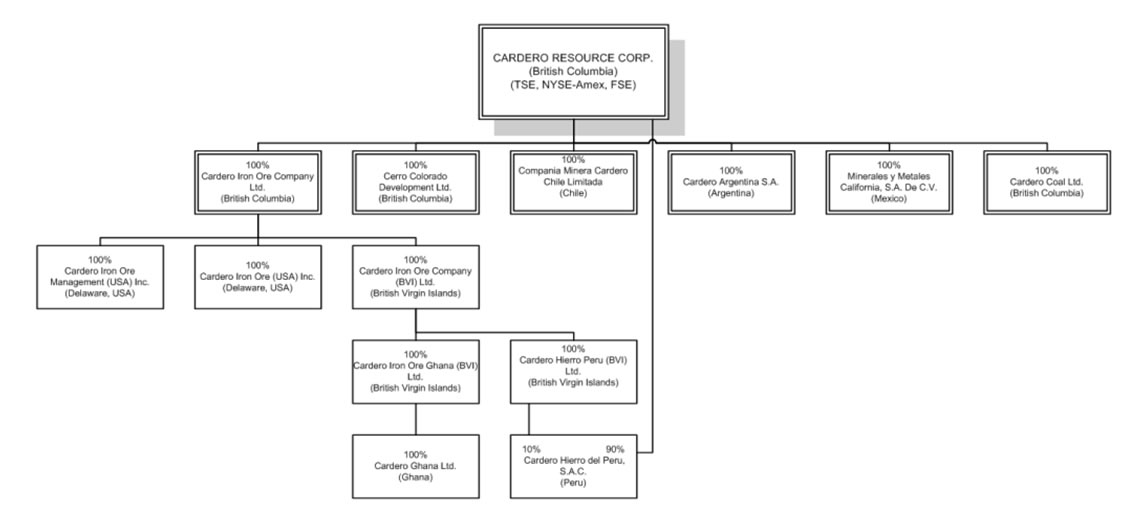
Throughout this document references made to the “Company” refer to Cardero and its consolidated subsidiaries, Cardero Coal, Cardero Iron, Cardero Argentina, Cardero Peru, Cardero Chile, CCDL, MMC, Cardero Iron USA, Cardero Management USA, Cardero Iron BVI, Cardero Hierro BVI, Cardero Hierro Peru, Cardero Iron Ghana and Cardero Ghana, while reference to “Cardero” refer to the Canadian parent company only.
- 16 -
ITEM 4: GENERAL DEVELOPMENT OF THE BUSINESS
Three Year History
The Company is a mineral exploration company engaged in the acquisition, exploration and development of mineral properties. The Company currently holds or has the right to acquire interests in a number of mineral properties in Argentina, Mexico, Peru, the United States of America, Ghana and Canada. The Company is in the exploration stage as its properties have not yet reached commercial production and none of its properties is beyond the preliminary exploration stage. All work presently planned by the Company is directed at defining mineralization and increasing understanding of the characteristics of, and economics of, that mineralization. There are currently no identified mineral reserves and, other than on the Carbon Creek property and the Longnose and Titac properties, there are currently no identified mineral resources, on any of the Company’s mineral properties.
Over the past three financial years, the Company has focused on the acquisition and exploration of mineral properties primarily in Argentina, Mexico, Peru, the United States and, more recently, Ghana and Canada. During the 2009, 2010 and 2011 financial years, the Company entered into a number of option agreements to acquire properties in these countries that it believes have the potential to host large gold, silver, copper-gold, iron ore/titanium/vanadium and/or coal deposits. Some of these, such as the Huachi, Cerro Juncal, Cerro Atajo, La Poma and Mina Azules properties in Argentina, the La Zorra and Ludivina properties in Mexico, the Amable Maria and Bocana properties in Peru, the Pedernales property in Chile and the properties acquired as part of its SHV Project in Argentina, have since been returned to the respective vendors or abandoned, and the associated costs written off, in light of disappointing exploration results. In this regard, during the 2010 fiscal year, the Company wrote off $8,498,083 in acquisition and exploration costs due to disappointing exploration results; during the 2011 fiscal year the Company wrote off $12,206,614 in acquisition and exploration costs. However, the Company has retained the most strategic concessions and continues to look for a joint venture partner to carry out additional exploration. The Organullo property in Argentina was the subject of an extensive work program in the fall of 2010, and in September 2011, the Company entered into an option/joint venture agreement with Artha Resources Corporation (“Artha”), whereby an Argentinean subsidiary of Artha can earn a 55% working interest in the Organullo property, and thereafter form a joint venture with Cardero Argentina S.A. The Company continued active discussions towards a joint venture or outright sale of the Iron Sands Project with a number of companies which continued to express an interest in this project. The Titac and Longnose properties in Minnesota were the subject of an initial drill program in 2010 and the Company completed follow-up work programs in 2011. Final drill results were received on these properties (see “Narrative Description of the Business - Material Mineral Projects - Longnose Titanium Project, Minnesota, USA” and “Titac Titanium Project, Minnesota, USA”).
During fiscal 2010, the Company optioned out its Corrales and Santa Teresa properties in Mexico and its Pirquitas property in Argentina, and will continue to seek joint venture partners for its Los Manantiales (Mina Angela) property in Argentina.
Pursuant to a Memorandum of Understanding dated August 8, 2008 (but effective as and from April 25, 2008) between the Company and International Minerals and Mines Ltd., a private Gibraltar company (“IMM”), the Company had the right to acquire up to a 30% interest in IMM Gold Limited (“IMMG”), a subsidiary of IMM which is engaged in reconnaissance exploration programs in the Caucasian Region. The Company is the manager of the exploration programs on behalf of IMMG. A director of Cardero is a director and significant shareholder of a private company which is the major shareholder (67%) of IMM. The Company acquired an initial 15% interest in IMMG by issuing to IMM an initial 500,000 Common Shares in November 2008, at which time the Company received 123,530 ordinary shares of IMMG, representing a 15% interest. While prospective areas were identified, no properties had been acquired by IMMG. Accordingly the Company determined not to acquire the additional 15% interest in IMMG before December 31, 2009. However, the Company has continued to work with IMMG in reviewing potential acquisitions.
- 17 -
Having identified iron ore as a commodity for which there was a significant demand, the Company has, on an ongoing basis, continued to evaluate a number of prospective iron ore properties, some of which have been acquired. The Pampa de Pongo Iron property (which sold for USD 100 million in January, 2010) and the Iron Sands Project, both in Peru, are examples of this. The Company has also focused on iron ore properties that contain significant titanium and vanadium, both of which are important industrial metals, and is pursuing ongoing metallurgical testwork to determine the optimum way to separate out the titanium and/or vanadium from the slag produced by treating the iron ore in a melter to produce titanium/vanadium rich slag.
The primary focus of the Company’s activities in fiscal 2008 and 2009 was the completion of a preliminary economic assessment at the Iron Sands Project in Peru, as well as ongoing metallurgical work relevant to the production of iron ore and pig iron from Pampa de Pongo material. Due to the significant costs associated with moving the project forward to commercial production, management determined that the sale of the Pampa de Pongo project was appropriate and, to this end, on October 24, 2008, the Company entered into an agreement with Nanjinzhao Group Co., Ltd., (“Nanjinzhao”), a private Chinese enterprise located in Zibo City, Shandong Province, People’s Republic of China, for the sale of the property. The sale was ultimately completed in January, 2010 and the total sale price of USD 100 million was received by the Company. The Company paid a finder’s fee to an arm’s length private company in consideration of the finder introducing Cardero to Nanjinzhao and providing ongoing advice in the negotiations.
During fiscal 2008 and fiscal 2009, the Company also carried out a pilot plant separation test at the Iron Sands Project, with a view to producing an iron concentrate and carrying out metallurgical testing of such concentrate, allowing for the Company to optimize the separation parameters and determine potential production parameters. The Company successfully produced a 40 tonne magnetic concentrate, significantly increased the pilot plant through-put (from 2.8 to 18 tonnes/hour) and increased the anticipated magnetic concentrate grade (to 55.5% iron). The concentrate was shipped to the United States, where extensive commercial scale melting tests, targeting the production of a premium-quality pig iron were carried out. In addition, bench scale testing of the concentrate indicates that a simple screening process resulted in an upgrade to 62.8% iron, and additional work is underway, targeting an increase to 64% iron through additional screening and other mineral separation techniques. The Company commissioned SRK Consulting (Johannesburg) to prepare a resource estimate for the Iron Sands Project utilizing the information from the 120 existing resource definition drillholes, and the resource estimate was delivered on, and effective as at, July 21, 2009.
In keeping with bulk-commodity focus, in June, 2010, Cardero acquired an initial interest of 49.9% in Coalhunter Mining Corporation (“Coalhunter”). Pursuant to private placements completed on September 27, 2010 and December 21, 2010, Cardero’s interest in Coalhunter increased to 45.5% . On June 1, 2011, Cardero acquired all of the issued and outstanding common shares of Coalhunter and Coalhunter subsequently changed its name to “Cardero Coal Ltd.” (see “Significant Acquisitions”). Upon completion of the acquisition, Michael Hunter was appointed President of Cardero and, subsequent to fiscal 2011, also assumed the position of Chief Executive Officer with Hendrik Van Alphen stepping down as CEO and assuming the position of Managing Director.
During fiscal 2011, Cardero acquired an aggregate of 8,634,007 common shares, representing 16.32%, of Abzu Gold Ltd. ("Abzu"), together with warrants to purchase an additional 3,782,000 common shares of Abzu. Abzu operates as a gold exploration and discovery company in Ghana, West Africa.
Cardero also completed an additional $1,175,000 investment in Kria Resources Ltd. ("Kria") through the exercise of warrants acquired by way of private placement. The investment resulted in Cardero holding an aggregate of 20,875,000 common shares of Kria, representing approximately 19.97% of the issued and outstanding common shares of Kria.
- 18 -
The Company optioned its Organullo Gold Project, Northwest Argentina, to Artha Resources Corporation ("Artha"), whereby Artha can earn an undivided fifty-five (55%) percent working interest in the Organullo Project, and thereafter form a Joint Venture with Cardero Argentina. Joint venturing of the Organullo Project is part of Cardero's strategy to option-out all non-core assets, allowing the Company to focus on development of its coal and iron ore projects.
The 2011 field program was completed at the Carbon Creek Metallurgical Coal deposit ("Carbon Creek") located in the Peace River Coal Field of northeastern British Columbia. Additionally, the Company received a Preliminary Economic Assessment (see “Narrative Description of the Business -Material Mineral Projects – Carbon Creek Metallurgical Coal Deposit, British Columbia, Canada”).
Subsequent to fiscal 2011, Cardero entered into a Letter of Intent ("LOI") with Anglo Pacific Group PLC ("Anglo Pacific") to acquire 100% of Trefi Coal Corporation ("Trefi"), a wholly owned subsidiary of Anglo Pacific which owns the Trefi Metallurgical Coal deposit in the Peace River Coalfield, northeast British Columbia, Canada. The Trefi Metallurgical Coal deposit comprises 15 coal licenses and 3 license application areas, totaling 9,437 hectares, located approximately 30 kilometres southeast of the town of Chetwynd in northeastern BC. The deposit has been explored previously by Gulf Canada (27 drillholes for 6,332 metres) and by Anglo Pacific (5 drillholes for 1,006 metres). The deposit is located within 60 kilometres of the Company's flagship metallurgical coal deposit at Carbon Creek.
Cardero closed its non-brokered private placement (the "Offering") announced on November 2, 2011 and increased on November 7, 2011. A total of 8,029,750 units ("Cardero Units") was sold at a price of CAD 0.95 per Cardero Unit for aggregate gross proceeds of CAD 7,628,262.50. Each Cardero Unit consisted of one Common Share and one-half of one common share purchase warrant (each whole warrant, a "Cardero Warrant"). Each Cardero Warrant is exercisable into one additional Common Share for a period of 12 months from the closing of the Offering at an exercise price of CAD 1.25. If, at any time from 4 months after the closing of the Offering until the expiry of the Cardero Warrants, the daily volume-weighted average trading price of the Common Shares on the TSX exceeds CAD 1.75 for at least 10 consecutive trading days, the Company may, within 30 days, give an expiry acceleration notice to the holders of Cardero Warrants and, if it does so, the Cardero Warrants will, unless exercised, expire on the 30th day after the expiry acceleration notice is given.
Cardero received repayment of the USD 8 million loan originally made to Kria Resources Inc. ("Kria") (now a wholly owned subsidiary of Trevali Mining Corporation ("Trevali")). The Company, Kria and Trevali agreed that the loan, plus interest of USD 645,260, was to be repaid as follows: (i) Kria has paid Cardero USD 5,000,000 in cash; and (ii) the balance of USD 3,645,260 (equivalent to CAD 3,734,569) has been satisfied by Trevali issuing to Cardero 4,149,521 units ("Trevali Units"), with each Trevali Unit being comprised of one common share of Trevali ("Trevali Common Share") and one-half of one transferrable common share purchase warrant (a "Trevali Warrant"), at a deemed price of CAD 0.90 per Trevali Unit. Each whole Trevali Warrant will entitle the holder thereof to purchase one Trevali Common Share ("Trevali Warrant Share") at a price of CAD 1.10 per share until January 16, 2014. The Trevali Common Shares, Trevali Warrants and any Trevali Warrant Shares issued are subject to a hold period in Canada expiring on May 17, 2012.
Cardero’s Ghanaian joint venture partner, Emmaland Resources Limited ("Emmaland"), received from the Government of the Republic of Ghana, through The Minister for Lands and Natural Resources (Ghana) ("Minister"), three prospecting licenses covering lands located in the Zabzugu-Tatale District in the Northern Region of the Republic of Ghana and referred to as the Sheini Hills Iron Project (approximately 400 square kilometres in aggregate). Cardero Ghana has signed joint venture agreements with Emmaland pursuant to which Cardero Ghana can acquire a 100% joint venture interest in each of the three licenses. Exploration has been initiated over Sheini Hills Iron Deposits, Ghana (see “Narrative Description of the Business - Material Mineral Projects – Sheini Hills Iron Project, Ghana”).
- 19 -
Significant Acquisitions
Since November 1, 2010, being the commencement of the Company’s last completed fiscal year, Cardero completed the acquisition of Coalhunter by acquiring all of the issued and outstanding shares of Coalhunter that it did not own, as set out in the Form 51-102F4 filed by the Company. Immediately prior to the acquisition, Cardero held 17,808,143 common shares of Coalhunter (representing approximately 47.48% of Coalhunter’s issued and outstanding shares).
Pursuant to an Arrangement Agreement dated April 18, 2011 between Cardero and Coalhunter, on June 1, 2011 each Coalhunter shareholder (other than Cardero) received 0.8 of a common share of Cardero for each common share of Coalhunter held, resulting in the issuance of 23,397,002 Common Shares. A further 5,885,543 Common Shares are reserved upon the exercise of options held by former Coalhunter optionees, the exercise of Coalhunter warrants and pursuant to Coalhunter property acquisition agreements.
Coalhunter is a private British Columbia company that has entered into various agreements to explore and, if warranted, develop, certain coal deposits in the Peace River Coal Field located in the northeast region of British Columbia. The property consists of a lease of freehold coal and certain coal licenses issued, or to be issued, by the British Columbia government. Coalhunter will hold a 75% interest in the joint venture and its co-venturer will hold a 25% carried interest. Coalhunter will be required to fund all exploration, development and mining costs, and the co-venturer will receive 25% of the net proceeds (after recovery by Coalhunter of its capital expenditures and ongoing operating costs). See “Narrative Description of the Business - Material Mineral Projects – Carbon Creek Metallurgical Coal Deposit, British Columbia, Canada”.
Coalhunter changed its name to “Cardero Coal Ltd.” on September 14, 2011.
ITEM 5: NARRATIVE DESCRIPTION OF THE BUSINESS
General
Summary
The Company currently holds, or has rights to acquire, interests (ranging from 75% to 100%) in several mineral properties (subject, in certain cases, to net smelter return royalties payable to the original property vendors) in Argentina, Mexico, Peru, the United States, Ghana and Canada. The Company is in the process of evaluating such properties through exploration programs or, in some cases, mineralogical and metallurgical studies and materials processing tests. In all cases, the objective is to evaluate the potential of the subject property and to determine if spending additional funds is warranted (in which case, an appropriate program to advance the property to the next decision point will be formulated and, depending upon available funds, implemented) or not (in which case the property may be offered for option/joint venture or returned to the vendor or abandoned, as applicable). At the present time, the Company is primarily interested in properties that are prospective for precious metals, copper, iron ore, titanium, vanadium and coal.
With the completion of the sale of the Pampa de Pongo Iron Project in January, 2010, the Company considers that the Carbon Creek property in British Columbia, Canada, the Longnose and Titac Iron Titanium properties in Minnesota, USA and the Sheini Hills property in Ghana, Africa, are its material mineral properties at the present time. However, ongoing work on other properties may produce results that would cause the Company to consider them as material mineral properties in the future. Information with respect to the Company’s material mineral properties is set out in the Material Mineral Projects section of this AIF.
- 20 -
The Company is in the exploration stage and does not mine, produce or sell any mineral products at this time, nor do any of its current properties have any known or identified mineral resources (with the exception of the Carbon Creek property and the Longnose and Titac properties), or mineral reserves. The Company does not propose any method of production at this time, although it is conducting extensive work on the Carbon Creek property in order to ascertain the appropriate production methods to employ should the property go into commercial production.
All aspects of the Company’s business require specialized skills and knowledge. Such skills and knowledge include the areas of geology, drilling, logistical planning, geophysics, metallurgy and mineral processing, implementation of exploration programs and accounting. While recent increased activity in the resource mining industry has made it more difficult to locate competent employees and consultants in such fields, the Company has found that it can locate and retain such employees and consultants and believes it will continue to be able to do so.
All of the raw materials the Company requires to carry on its business are readily available through normal supply or business contracting channels in Canada, Ghana, Argentina, Mexico, Peru and the United States. The Company has secured, or reasonably believes that it will be able to secure, personnel to conduct its contemplated programs.
The mining business is subject to mineral price cycles. The marketability of minerals and mineral concentrates is also affected by worldwide economic cycles. In recent years, the significant demand for minerals in some countries (notably China and India) has driven increased commodity prices to historic highs. While the downturn in the world economy in 2008 and 2009 significantly moderated the record high prices, and temporarily reduced the upward price pressures, for many commodities (including several that the Company is in the business of exploring for), the upward price movements have recently become re-established, primarily as a result of Chinese demand for commodities such as copper, coal and iron ore. It is difficult to assess if the apparent upward momentum in several commodity prices are long-term trends, and there is great uncertainty as to the recovery, or otherwise, of the world, and particularly, the Chinese, economy. If the economic recovery stalls and commodity prices decline as a consequence, a continuing period of lower prices could significantly affect the economic potential of many of the Company’s current properties and result in the Company determining to cease work on, or drop its interest in, some or all of such properties. The one exception to this is gold. Fear of potential inflation as a consequence of the stimulus packages implemented by many countries (notably the United States) and the potential negative influence on the US dollar (among other currencies), have led to significant increases in the price of gold to record highs.
The Company’s business is not substantially dependent on any contract such as a contract to sell the major part of its products or services or to purchase the major part of its requirements for goods, services or raw materials, or on any franchise or licence or other agreement to use a patent, formula, trade secret, process or trade name upon which its business depends.
It is not expected that the Company’s business will be affected in the current financial year by the renegotiation or termination of contracts or sub-contracts.
As of October 31, 2011, Cardero had 16 full-time employees, Cardero Coal had 14 full-time employees and Cardero Management USA had three full-time employees. The Company relies to a large degree upon consultants and contractors to carry on many of its activities and, in particular, to supervise and carry out the work programs on its mineral properties. However, should the Company expand its activities, it is likely that it will choose to hire additional employees.
Bankruptcy and Similar Procedures
There are no bankruptcy, receivership or similar proceedings against Cardero, nor is Cardero aware of any such pending or threatened proceedings. There have not been any voluntary bankruptcy, receivership or similar proceedings by Cardero within the three most recently completed financial years or completed or currently proposed for the current financial year.
- 21 -
Reorganizations
There have been no reorganizations of or involving Cardero within the three most recently completed financial years and no reorganizations are currently proposed for the current financial year.
Social or Environmental Policies
Cardero has created a Sustainable Development Committee (“SDC”), which has adopted a formal charter. The overall purpose of the SDC is to assist the Board in fulfilling its oversight responsibilities with respect to the Board’s and the Company’s continuing commitment to improving the environment and ensuring that the Company’s activities are carried out, and that its facilities are operated and maintained, in a safe, sustainable and environmentally sound manner. The primary function of the SDC is to monitor, review and provide oversight with respect to the Company’s policies, standards, accountabilities and programs relative to health, safety, community relations and environmental-related matters. Further, the SDC is to advise the Board and make recommendations for the Board’s consideration regarding health, safety, community relations and environmental-related issues. In particular, the SDC is to consider and advise the Board with respect to current standards of sustainable development for projects and activities such as those of the Company, particularly with a view to ensuring that the Company’s business is run in a manner, and its projects are operated and developed, so as to achieve the ideals and reflect the following principles of sustainable development:
| (a) |
living within environmental limits, | |
| (b) |
ensuring a strong, healthy and just society, | |
| (c) |
achieving a sustainable economy, | |
| (d) |
using sound science responsibly, and | |
| (e) |
promoting good governance. |
The SDC is also responsible for monitoring the activities of the Company in connection with the initial and ongoing interaction between the Company’s activities, operations and personnel and the communities in which the Company’s projects and related activities are located, with a view to ensuring that management develops and follows appropriate policies and activities to enhance the relationship between the Company and its personnel and the communities in which it operates and reflect the principles of sustainable development in that regard.
Although not set out in a specific policy, the Company strives to be a positive influence in the local communities where its mineral projects are located, not only by contributing to the welfare of such communities through donations of money and supplies, as appropriate, but also through hiring, when appropriate, local workers to assist in ongoing exploration programs as well as contributing to and improving local infrastructure. The Company considers that building and maintaining strong relationships with such communities is fundamental to its ability to continue to operate in such regions and to assist in the eventual development (if any) of mining operations in such regions, and it attaches considerable importance to commencing and fostering them from the beginning of its involvement in any particular area.
Cardero has also adopted a Code of Business Conduct and Ethics, which provides, among other things, that the Company is committed to complying with all laws and governmental regulations applicable to its activities and, specifically, to maintaining a safe and healthy work environment and conducting its activities in full compliance with all applicable environmental laws.
- 22 -
Risk Factors
In addition to those risk factors discussed elsewhere in this AIF, the Company is subject to the following risk factors:
Resource Exploration and Development is Generally a Speculative Business: Resource exploration and development is a speculative business and involves a high degree of risk, including, among other things, unprofitable efforts resulting both from the failure to discover mineral deposits and from finding mineral deposits which, though present, are insufficient in size and grade at the then prevailing market conditions to return a profit from production. The marketability of natural resources which may be acquired or discovered by the Company will be affected by numerous factors beyond the control of the Company. These factors include market fluctuations, the proximity and capacity of natural resource markets, government regulations, including regulations relating to prices, taxes, royalties, land use, importing and exporting of minerals and environmental protection. The exact effect of these factors cannot be accurately predicted, but the combination of these factors may result in the Company not receiving an adequate return on invested capital.
There are no known reserves and, other than on the Carbon Creek property and the Longnose and Titac properties, there are no known resources, on any of the Company’s properties. The majority of exploration projects do not result in the discovery of commercially mineable deposits of ore. Substantial expenditures are required to establish ore reserves through drilling and metallurgical and other testing techniques, determine metal content and metallurgical recovery processes to extract metal from the ore, and construct, renovate or expand mining and processing facilities. No assurance can be given that any level of recovery of ore reserves will be realized or that any identified mineral deposit, even it is established to contain an estimated resource, will ever qualify as a commercial mineable ore body which can be legally and economically exploited. Mineral resources are not mineral reserves and there is no assurance that any mineral resources will ultimately be reclassified as proven or probable reserves. Mineral resources which are not mineral reserves do not have demonstrated economic viability.
Fluctuation of Commodity Prices: Even if commercial quantities of mineral deposits are discovered by the Company, there is no guarantee that a profitable market will exist for the sale of the minerals produced. The Company’s long-term viability and profitability depend, in large part, upon the market price of minerals which have experienced significant movement over short periods of time, and are affected by numerous factors beyond the control of the Company, including international economic and political trends, expectations of inflation, currency exchange fluctuations, interest rates and global or regional consumption patterns, speculative activities and increased production due to improved mining and production methods. The recent price fluctuations in the price of all commodities for which the Company is presently exploring is an example of a situation over which the Company has no control and may materially adversely affect the Company in a manner that it may not be able to compensate for. The supply of and demand for minerals are affected by various factors, including political events, economic conditions and production costs in major producing regions. There can be no assurance that the price of any minerals produced from the Company’s properties will be such that any such deposits can be mined at a profit.
Recent market events and conditions: Since 2008, the U.S. credit markets have experienced serious disruption due to a deterioration in residential property values, defaults and delinquencies in the residential mortgage market (particularly, sub-prime and non-prime mortgages) and a decline in the credit quality of mortgage backed securities. These problems have led to a slow-down in residential housing market transactions, declining housing prices, delinquencies in non-mortgage consumer credit and a general decline in consumer confidence. These conditions caused a loss of confidence in the broader U.S. and global credit and financial markets and resulting in the collapse of, and government intervention in, major banks, financial institutions and insurers and creating a climate of greater volatility, less liquidity, widening of credit spreads, a lack of price transparency, increased credit losses and tighter credit conditions. Notwithstanding various actions by the U.S. and foreign governments, concerns about the general condition of the capital markets, financial instruments, banks, investment banks, insurers and other financial institutions caused the broader credit markets to further deteriorate and stock markets to decline substantially. In addition, general economic indicators have deteriorated, including declining consumer sentiment, increased unemployment and declining economic growth and uncertainty about corporate earnings.
- 23 -
While these conditions appear to have improved slightly in 2010/11, unprecedented disruptions in the credit and financial markets have had a significant material adverse impact on a number of financial institutions and have limited access to capital and credit for many companies. These disruptions could, among other things, make it more difficult for the Company to obtain, or increase its cost of obtaining, capital and financing for its operations. The Company’s access to additional capital may not be available on terms acceptable to it or at all.
General Economic Conditions: The recent unprecedented events in global financial markets have had a profound impact on the global economy. Many industries, including the gold and base metal mining industry, are impacted by these market conditions. Some of the key impacts of the current financial market turmoil include contraction in credit markets resulting in a widening of credit risk, devaluations and high volatility in global equity, commodity, foreign exchange and precious metal markets, and a lack of market liquidity. A continued or worsened slowdown in the financial markets or other economic conditions, including but not limited to, consumer spending, employment rates, business conditions, inflation, fuel and energy costs, consumer debt levels, lack of available credit, the state of the financial markets, interest rates, and tax rates may adversely affect the Company’s growth and profitability. Specifically:
-
The global credit/liquidity crisis could impact the cost and availability of financing and the Company’s overall liquidity
-
the volatility of gold and other base metal prices may impact the Company’s future revenues, profits and cash flow
-
volatile energy prices, commodity and consumables prices and currency exchange rates impact potential production costs
-
the devaluation and volatility of global stock markets impacts the valuation of the Common Shares, which may impact the Company’s ability to raise funds through the issuance of Common Shares
These factors could have a material adverse effect on the Company’s financial condition and results of operations.
Share Price Volatility: In 2010/11, worldwide securities markets, particularly those in the United States and Canada, have experienced a high level of price and volume volatility, and the market price of securities of many companies, particularly those considered exploration or development stage companies, have experienced unprecedented fluctuations in price which have not necessarily been related to the operating performance, underlying asset values or prospects of such companies. Most significantly, the share prices of junior natural resource companies have experienced an unprecedented decline in value and there has been a significant decline in the number of buyers willing to purchase such securities. In addition, significantly higher redemptions by holders of mutual funds has forced many of such funds (including those holding the Company’s securities) to sell such securities at any price. As a consequence, despite the Company’s past success in securing significant equity financing, market forces may render it difficult or impossible for the Company to secure placees to purchase new share issues at a price which will not lead to severe dilution to existing shareholders, or at all. Therefore, there can be no assurance that significant fluctuations in the Common Shares will not occur, or that such fluctuations will not materially adversely impact on the Company’s ability to raise equity funding without significant dilution to its existing shareholders, or at all.
- 24 -
Permits and Licenses: The operations of the Company will require licenses and permits from various governmental authorities. There can be no assurance that the Company will be able to obtain all necessary licenses and permits that may be required to carry out exploration, development and mining operations at its projects, on reasonable terms or at all. Delays or a failure to obtain such licenses and permits, or a failure to comply with the terms of any such licenses and permits that the Company does obtain, could have a material adverse effect on the Company.
Acquisition of Mineral Properties under Agreements: The agreements pursuant to which the Company has the right to acquire a number of its properties provide that the Company must make a series of cash payments and/or share issuances over certain time periods, expend certain minimum amounts on the exploration of the properties or contribute its share of ongoing expenditures. Failure by the Company to make such payments, issue such shares or make such expenditures in a timely fashion may result in the Company losing its interest in such properties. There can be no assurance that the Company will have, or be able to obtain, the necessary financial resources to be able to maintain all of its property agreements in good standing, or to be able to comply with all of its obligations thereunder, with the result that the Company could forfeit its interest in one or more of its mineral properties.
Title Matters: The acquisition of title to mineral properties in Mexico, Peru, Argentina and Ghana is a very detailed and time-consuming process. Title to, and the area of, mineral concessions may be disputed. While the Company has diligently investigated title to all mineral properties in which it has an interest and, to the best of its knowledge, title to all such properties is in good standing or, where not yet granted, the application process appears to be proceeding normally in all the circumstances, this should not be construed as a guarantee of title or that any such applications for concessions will be granted. Title to mineral properties may be affected by undetected defects such as aboriginal or indigenous peoples’ land claims, or unregistered agreements or transfers. The Company has not obtained title opinions for the majority of its mineral properties. Not all the mineral properties in which the Company has an interest have been surveyed, and their actual extent and location may be in doubt.
Surface Rights and Access: Although the Company acquires the rights to some or all of the minerals in the ground subject to the mineral tenures that it acquires, or has a right to acquire, in most cases it does not thereby acquire any rights to, or ownership of, the surface to the areas covered by its mineral tenures. In such cases, applicable mining laws usually provide for rights of access to the surface for the purpose of carrying on mining activities, however, the enforcement of such rights through the courts can be costly and time consuming. It is necessary to negotiate surface access or to purchase the surface rights if long-term access is required. There can be no guarantee that, despite having the right at law to access the surface and carry on mining activities, the Company will be able to negotiate satisfactory agreements with any such existing landowners/occupiers for such access or purchase of such surface rights, and therefore it may be unable to carry out planned mining activities. In addition, in circumstances where such access is denied, or no agreement can be reached, the Company may need to rely on the assistance of local officials or the courts in the applicable jurisdiction, the outcomes of which cannot be predicted with any certainty. The inability of the Company to secure surface access or purchase required surface rights could materially and adversely affect the timing, cost or overall ability of the Company to develop any mineral deposits it may locate. This is a particular problem in many areas of Mexico, Argentina, Peru and Ghana, where blockades of access to the Company’s properties, hostile actions by local communities and the potential unwillingness of local police or governmental officials to assist a foreign company against its own citizens can result in the Company being unable to carry out any exploration activities despite being legally authorized to do so and having complied with all applicable local laws and requirements.
- 25 -
No Assurance of Profitability: The Company has no history of production or earnings and due to the nature of its business there can be no assurance that the Company will be profitable. The Company has not paid dividends on its shares since incorporation and does not anticipate doing so in the foreseeable future. All of the Company’s properties are in the exploration stage and the Company has not defined or delineated any proven or probable reserves on any of its properties. None of the Company’s properties are currently under development. Continued exploration of its existing properties and the future development of any properties found to be economically feasible, will require significant funds. The only present source of funds available to the Company is through the sale of its equity securities or the sale or optioning of a portion of its interest in its mineral properties. Even if the results of exploration are encouraging, the Company may not have sufficient funds to conduct the further exploration that may be necessary to determine whether or not a commercially mineable deposit exists. While the Company may generate additional working capital through further equity offerings or through the sale or possible syndication of its properties, there is no assurance that any such funds will be available on favourable terms, or at all. At present, it is impossible to determine what amounts of additional funds, if any, may be required. Failure to raise such additional capital could put the continued viability of the Company at risk.
Uninsured or Uninsurable Risks: Exploration, development and mining operations involve various hazards, including environmental hazards, industrial accidents, metallurgical and other processing problems, unusual or unexpected rock formations, structural cave-ins or slides, flooding, fires, metal losses and periodic interruptions due to inclement or hazardous weather conditions. These risks could result in damage to or destruction of mineral properties, facilities or other property, personal injury, environmental damage, delays in operations, increased cost of operations, monetary losses and possible legal liability. The Company may not be able to obtain insurance to cover these risks at economically feasible premiums or at all. The Company may elect not to insure where premium costs are disproportionate to the Company’s perception of the relevant risks. The payment of such insurance premiums and of such liabilities would reduce the funds available for exploration and production activities.
Government Regulation: Any exploration, development or mining operations carried on by the Company will be subject to government legislation, policies and controls relating to prospecting, development, production, environmental protection, mining taxes and labour standards. The Company cannot predict whether or not such legislation, policies or controls, as presently in effect, will remain so, and any changes therein (for example, significant new royalties or taxes), which are completely outside the control of the Company, may materially adversely affect to ability of the Company to continue its planned business within any such jurisdictions.
Foreign Countries and Political Risk: The Company has mineral properties located in Peru, Argentina, Mexico, the United States and Ghana. In such countries, mineral exploration and mining activities may be affected in varying degrees by political or economic instability, expropriation of property and changes in government regulations such as tax laws, business laws, environmental laws and mining laws. Any changes in regulations or shifts in political conditions are beyond the control of the Company and may materially adversely affect it business, or if significant enough, may make it impossible to continue to operate in certain countries. Operations may be affected in varying degrees by government regulations with respect to restrictions on production, price controls, foreign exchange restrictions, export controls, income taxes, expropriation of property, environmental legislation and mine safety.
Dependence Upon Others and Key Personnel: The success of the Company’s operations will depend upon numerous factors, many of which are beyond the Company’s control, including (i) the ability of the Company to enter into strategic alliances through a combination of one or more joint ventures, mergers or acquisition transactions; and (ii) the ability to attract and retain additional key personnel in exploration, mine development, sales, marketing, technical support and finance. These and other factors will require the use of outside suppliers as well as the talents and efforts of the Company.
- 26 -
There can be no assurance of success with any or all of these factors on which the Company’s operations will depend. The Company has relied and may continue to rely, upon consultants and others for operating expertise.
Exploration and Mining Risks: Fires, power outages, labour disruptions, flooding, explosions, cave-ins, landslides and the inability to obtain suitable or adequate machinery, equipment or labour are other risks involved in the operation of mines and the conduct of exploration programs. Substantial expenditures are required to establish reserves through drilling, to develop metallurgical processes, to develop the mining and processing facilities and infrastructure at any site chosen for mining. Although substantial benefits may be derived from the discovery of a major mineralized deposit, no assurance can be given that minerals will be discovered in sufficient quantities to justify commercial operations or that funds required for development can be obtained on a timely basis. The economics of developing mineral properties is affected by many factors including the cost of operations, variations of the grade of ore mined, fluctuations in the price of gold or other minerals produced, costs of processing equipment and such other factors as government regulations, including regulations relating to royalties, allowable production, importing and exporting of minerals and environmental protection. In addition, the grade of mineralization ultimately mined may differ from that indicated by drilling results and such differences could be material. Short term factors, such as the need for orderly development of ore bodies or the processing of new or different grades, may have an adverse effect on mining operations and on the results of operations. There can be no assurance that minerals recovered in small scale laboratory tests will be duplicated in large scale tests under on-site conditions or in production scale operations. Material changes in geological resources, grades, stripping ratios or recovery rates may affect the economic viability of projects.
Currency Fluctuations: The Company presently maintains its accounts in Canadian dollars. Due to the nature of its operations in such countries, the Company also maintains accounts in U.S. dollars, Mexican and Argentinean pesos, Peruvian nuevo soles and Ghanaian Cedi. The Company’s operations in the United States, Mexico, Argentina, Peru and Ghana and its proposed payment commitments and exploration expenditures under many of the agreements pursuant to which it holds, or has a right to acquire, an interest in its mineral properties are denominated in U.S. dollars, making it subject to foreign currency fluctuations. Such fluctuations are out of its control and may materially adversely affect the Company’s financial position and results. The Company does not engage in any hedging programs with respect to currencies.
Environmental Restrictions: The activities of the Company are subject to environmental regulations promulgated by government agencies in different countries from time to time. Environmental legislation generally provides for restrictions and prohibitions on spills, releases or emissions into the air, discharges into water, management of waste, management of hazardous substances, protection of natural resources, antiquities and endangered species and reclamation of lands disturbed by mining operations. Certain types of operations require the submission and approval of environmental impact assessments. Environmental legislation is evolving in a manner which means stricter standards, and enforcement, fines and penalties for non-compliance are more stringent. Environmental assessments of proposed projects carry a heightened degree of responsibility for companies and directors, officers and employees. The cost of compliance with changes in governmental regulations has a potential to reduce the profitability of operations.
Regulatory Requirements: The activities of the Company are subject to extensive regulations governing various matters, including environmental protection, management and use of toxic substances and explosives, management of natural resources, exploration, development of mines, production and post-closure reclamation, exports, price controls, taxation, regulations concerning business dealings with indigenous peoples, labour standards on occupational health and safety, including mine safety, and historic and cultural preservation. Failure to comply with applicable laws and regulations may result in civil or criminal fines or penalties, enforcement actions thereunder, including orders issued by regulatory or judicial authorities causing operations to cease or be curtailed, and may include corrective measures requiring capital expenditures, installation of additional equipment, or remedial actions, any of which could result in the Company incurring significant expenditures. The Company may also be required to compensate those suffering loss or damage by reason of a breach of such laws, regulations or permitting requirements. It is also possible that future laws and regulations, or more stringent enforcement of current laws and regulations by governmental authorities, could cause additional expense, capital expenditures, restrictions on or suspension of the Company’s operations and delays in the exploration and development of the Company’s properties.
- 27 -
Limited Experience with Development-Stage Mining Operations: The Company has limited experience in placing resource properties into production, and its ability to do so will be dependent upon using the services of appropriately experienced personnel or entering into agreements with other major resource companies that can provide such expertise. There can be no assurance that the Company will have available to it the necessary expertise when and if it places its resource properties into production.
Estimates of Mineral Reserves and Resources and Production Risks: The mineral resource estimates presented in the Company’s filings with securities regulatory authorities, press releases and other public statements that may be made from time to time are based upon estimates made by Company personnel and independent geologists, and no assurance can be given that any particular level of recovery of minerals will in fact be realized or that an identified reserve or resource will ever qualify as a commercially mineable (or viable) deposit which can be legally and economically exploited. The estimating of mineral resources and mineral reserves is a subjective process and the accuracy of mineral resource and mineral reserve estimates is a function of the quantity and quality of available data, the accuracy of statistical computations, and the assumptions used and judgments made in interpreting available engineering and geological information. There is significant uncertainty in any mineral resource or mineral reserve estimate and the actual deposits encountered and the economic viability of a deposit may differ materially from the Company’s estimates. Accordingly, there can be no assurance that:
-
these estimates will be accurate;
-
reserves, resource or other mineralization figures will be accurate; or
-
this mineralization could be mined or processed profitably.
Because the Company has not commenced production at any of its properties, and has not defined or delineated any proven or probable reserves on any of its properties, mineralization estimates for the Company’s properties may require adjustments or downward revisions based upon further exploration or development work or actual production experience. In addition, the grade of mineralization ultimately mined may differ from that indicated by drilling results and such differences could be material. There can be no assurance that minerals recovered in small-scale tests will be duplicated in large-scale tests under on-site conditions or in production scale. Production can be affected by such factors as permitting regulations and requirements, weather, environmental factors, unforeseen technical difficulties, unusual or unexpected geological formations and work interruptions. Short term factors, such as the need for orderly development of deposits or the processing of new or different grades, may have a material adverse effect on mining operations and on the results of operations. There can be no assurance that minerals recovered in small scale laboratory tests will be duplicated in large scale tests under on-site conditions or in production scale operations. Material changes in reserves or resources, grades, stripping ratios or recovery rates may affect the economic viability of projects. The estimated resources described in the Company’s filings with securities regulatory authorities, press releases and other public statements that may be made from time to time should not be interpreted as assurances of mine life or of the profitability of future operations. Estimated mineral resources and mineral reserves may have to be re-estimated based on changes in applicable commodity prices, further exploration or development activity or actual production experience. This could materially and adversely affect estimates of the volume or grade of mineralization, estimated recovery rates or other important factors that influence mineral resource or mineral reserve estimates. Market price fluctuations for gold, silver or base metals, increased production costs or reduced recovery rates or other factors may render any particular reserves uneconomical or unprofitable to develop at a particular site or sites. A reduction in estimated reserves could require material write downs in investment in the affected mining property and increased amortization, reclamation and closure charges.
- 28 -
Mineral resources are not mineral reserves and there is no assurance that any mineral resources will ultimately be reclassified as proven or probable reserves. Mineral resources which are not mineral reserves do not have demonstrated economic viability. The failure to establish proven and probable reserves could restrict the Company’s ability to successfully implement its strategies for long-term growth.
Enforcement of Civil Liabilities: As many of the assets of the Company are located outside of Canada and the United States, and certain of the directors and officers of Cardero are resident outside of Canada and/or the United States, it may be difficult or impossible to enforce judgements granted by a court in Canada or the United States against the assets of the Company or the directors and officers of Cardero residing outside of such country.
Mining Industry is Intensely Competitive: The Company’s business of the acquisition, exploration and development of mineral properties is intensely competitive. The Company may be at a competitive disadvantage in acquiring additional mining properties because it must compete with other individuals and companies, many of which have greater financial resources, operational experience and technical capabilities than the Company. The Company may also encounter increasing competition from other mining companies in efforts to hire experienced mining professionals. Competition for exploration resources at all levels is currently very intense, particularly affecting the availability of manpower, drill rigs and helicopters. Increased competition could adversely affect the Company’s ability to attract necessary capital funding or acquire suitable producing properties or prospects for mineral exploration in the future.
The Company may be a “passive foreign investment company” under the U.S. Internal Revenue Code, which may result in material adverse U.S. federal income tax consequences to investors in Common Shares that are U.S. taxpayers: Investors in Common Shares that are U.S. taxpayers should be aware that Cardero believes that it has been in one or more prior tax years, and may be in current and future tax years, a “passive foreign investment company” under Section 1297(a) of the U.S. Internal Revenue Code (a “PFIC”). However, no determination has been made regarding Cardero’s PFIC status for any particular tax year. If Cardero is or becomes a PFIC, generally any gain recognized on the sale of the Common Shares and any “excess distributions” (as specifically defined) paid on the Common Shares must be rateably allocated to each day in a U.S. taxpayer’s holding period for the Common Shares. The amount of any such gain or excess distribution allocated to prior years of such U.S. taxpayer’s holding period for the Common Shares generally will be subject to U.S. federal income tax at the highest tax applicable to ordinary income in each such prior year, and the U.S. taxpayer will be required to pay interest on the resulting tax liability for each such prior year, calculated as if such tax liability had been due in each such prior year. The amount of any such gain or excess distribution allocated to the tax year of disposition or distribution of the excess distribution and to years before the entity became a PFIC, if any, would be taxed as ordinary income.
Alternatively, a U.S. taxpayer that makes a “qualified electing fund” (a “QEF”) election with respect to Cardero generally will be subject to U.S. federal income tax on such U.S. taxpayer’s pro rata share of Cardero’s “net capital gain” and “ordinary earnings” (as specifically defined and calculated under U.S. federal income tax rules), regardless of whether such amounts are actually distributed by Cardero. U.S. taxpayers should be aware, however, that there can be no assurance that Cardero will satisfy record keeping requirements under the QEF rules or that Cardero will supply U.S. taxpayers with required information under the QEF rules, if Cardero is a PFIC and a U.S. taxpayer wishes to make a QEF election. As a second alternative, a U.S. taxpayer may make a “mark-to-market election” if Cardero is a PFIC and the Common Shares are “marketable stock” (as specifically defined). A U.S. taxpayer that makes a mark-to-market election generally will include in gross income, for each taxable year in which Cardero is a PFIC, an amount equal to the excess, if any, of (a) the fair market value of the Common Shares as of the close of such taxable year over (b) such U.S. taxpayer’s adjusted tax basis in the Common Shares.
- 29 -
The above paragraphs contain only a brief summary of certain U.S. federal income tax considerations. Investors should consult their own tax advisor regarding the PFIC rules and other U.S. federal income tax consequences of the acquisition, ownership, and disposition of Common Shares.
Material Mineral Projects
Carbon Creek Metallurgical Coal Deposit, British Columbia, Canada
Information in this AIF regarding the Carbon Creek property is based on information provided by the Carbon Creek Report. The following summary is from the Carbon Creek Report and the detailed disclosure in the Carbon Creek Report is incorporated into this AIF by reference. Readers are encouraged to review the entire Carbon Creek Report, which is filed on SEDAR at www.sedar.com.
Location
The Carbon Creek property lies approximately 60km northwest of the town of Chetwynd, BC and 40km west of the town of Hudson’s Hope. Improved forest service roads connect the property with British Columbia Highway 29 between the towns of Chetwynd and Hudson Hope. The CN Rail line connecting Fort St John and Tumbler Ridge areas with Prince George passes 40km south of the property. The CN Rail line provides direct access to the ports of Vancouver and Ridley Terminals in Prince Rupert, BC.
Tenure and Joint Venture
The Carbon Creek property is in the Peace River Coalfield and consists of twelve Coal License Applications (and any coal licenses issued pursuant to such applications) and ten Crown Granted District Lots (CGDL), comprising a contiguous tenure parcel of 17,200ha.
Ten of the Coal License Applications have been submitted by P. Burns Resources Ltd. (Burns) of Calgary, Alberta and, upon the issuance of any coal licenses thereunder, such licenses are to be transferred to the Carbon Creek Partnership (CCP), an Alberta partnership. One Coal License Application has been submitted by Alan A. Johnson (Johnson), and one has been submitted by Cardero Coal.
The CGDL’s, totalling approximately 2,600ha, are controlled by Peace River Partnership (PRP), an Alberta partnership. Cardero Coal has entered into an option to acquire a coal lease over the CGDL from PRP.
Cardero Coal has entered into an agreement with Johnson to purchase the one coal license to be issued pursuant to the Coal License Application submitted by Johnson (subject to the issuance of the applicable coal license).
Cardero Coal has entered into a joint venture agreement with CCP, in which Cardero Coal will have a 75% interest and CCP will have a 25% interest. Pursuant to the joint venture agreement, each joint venture partner is contributing its interest in the Carbon Creek property, being the coal lease over the CGDL (when acquired by Cardero Coal), and all coal licenses (if and when issued to Burns and transferred to CCP and if as and when issued to Cardero Coal pursuant to the applicable Coal License Applications and, in the case of the coal license which may be issued to Johnson pursuant to his Coal License Application, upon its acquisition from him by Cardero Coal). The joint venture, known as the Carbon Creek Joint Venture, will control and operate the Carbon Creek property described above. The joint venture agreement provides that the CCP interest is a carried net profits interest which requires Cardero Coal to fund the exploration, development, construction and operation of the mine and that the CCP receives no profits until Cardero Coal has recovered its investment. At that point, the CCP is entitled to 25% of the net profits of the Carbon Creek Joint Venture.
- 30 -
Cardero Coal is the manager of the Carbon Creek Joint Venture.
Cardero completed the acquisition of the balance of the outstanding shares of Coalhunter through a plan of arrangement that was completed on June 1, 2011.
Geology
The local geology of the Carbon Creek Property consists of a doubly-plunging syncline which lies between two anticlinal belts that straddle the western and eastern boundaries of the property. The synclinal axis roughly parallels the course of Carbon Creek, and plunges gently (less than 5°) to the south-southeast through the main project area. Dips in the central portion of the property are nearly flat, ranging from 0º to 15º, increasing to up to 30º along the synclinal flanks in the east and west portions of the property. Dips through the east and central portions of the initial development area are very mild due to their proximity to the syncline axis. Dips increase to the west moving up the western limb of the syncline.
Four north-south trending faults were identified in early exploration programs and were thought to die out in these directions. According to Utah Mines Ltd. (Utah) dips of strata in proximity to these faults increase to the point where they effectively separate the property into discreet mining blocks. The three westernmost faults were interpreted to be high-angle reverse faults with displacements estimated to range from between 50m to 70m. The easternmost Carbon Creek fault was speculated to be a high-angle thrust and having significant displacement, in the range of hundreds of meters, based on the interpretation of a coal-barren portion of the upper Gething being exposed on its eastern side.
Recent field work conducted by Cardero Coal has shown that the severity of the faulting may be less than estimated by Utah during their evaluations in the late 1970’s and early 1980’s. Definitive data that would permit accurate, detailed mine planning in the areas proximal to suspected faults has yet to be collected and/or evaluated. The most notable change in interpretation is the intersection of what is believed to be the lower coal seams of the property’s stratigraphic sequence on the east side of the Carbon Creek Fault. This fault was formerly thought to have had sufficient uplift to expose the barren zone of the Gething Formation lying below the coal horizons. Although not sufficiently defined as a resource for inclusion in the Carbon Creek Report, it does present an exploration target for establishing additional resource tonnage in the future.
Mineralization
The mineralized zones encountered on the property are predominantly medium volatile bituminous coal seams, with minor increase or decrease in rank depending on structural or stratigraphic variations and depth of burial. Historic coal quality reports indicate that the coals will, with beneficiation (washing) to remove impurities, produce a product with coking properties suitable for metallurgic applications. Thermal coal suitable for electric power generation could be produced with or without further processing in addition to, or as an alternative to, a coking coal product.
Coal Occurrence
Over thirty coal seams occur in the middle and upper portions of the Gething Formation. Sixteen seams are present through the northern half of the property. Twelve main seams have figured prominently in historic coal tonnage calculations.
Coal deposition is typical of the Gething Formation, consisting of abundant coal seams, some showing favorable metallurgical properties. The twelve seams listed in Table 1.1 are developed sufficiently to be of economic significance. These seams range from 1.14m to 2.17m in average thickness. Raw coal qualities are presented for each of these seams. Values shown represent coal without out-of-seam dilution (OSD). Processing coal mixed with OSD using size specific density and froth flotation separating processes (coal washing) is widely used to improve coal quality by reducing ash content and raising its calorific value. Coking properties such as free swelling index (FSI) and dilation are typically improved as well, through washing.
- 31 -
Table 1.1 Raw Coal Quality
SEAM |
AVERAGE THICKNESS (M) |
COAL QUALITY (AIR DRIED BASIS) | ||||||
| MOISTURE (%) |
ASH (%) |
SULPHUR
(%) |
VOLATILE MATTER (%) |
FIXED
CARBON % |
CALORIFIC
VALUE BTU/LB |
FSI | ||
| 58 | 1.14 | 2.60 | 12.56 | 0.92 | 28.92 | 55.93 | 12,663 | 2.0 |
| 55 | 1.57 | 2.74 | 12.42 | 0.68 | 28.59 | 56.26 | 12,893 | 2.5 |
| 54 | 1.39 | 2.78 | 5.66 | 0.83 | 27.36 | 64.20 | 13,926 | 1.5 |
| 52 | 1.63 | 2.18 | 17.14 | 1.88 | 28.33 | 52.35 | 12,178 | 4.0 |
| 51A | 1.29 | 2.74 | 6.25 | 0.80 | 28.01 | 63.00 | 13,902 | 2.0 |
| 51 | 1.51 | 2.73 | 9.63 | 0.73 | 26.42 | 61.23 | 13,228 | 2.0 |
| 47 | 1.14 | 2.53 | 15.49 | 0.91 | 24.00 | 57.98 | 12,441 | 1.5 |
| 46 | 1.70 | 2.60 | 6.50 | 0.83 | 26.92 | 63.99 | 13,907 | 2.0 |
| 40 | 1.95 | 2.02 | 13.99 | 1.17 | 27.16 | 56.83 | 12,892 | 5.5 |
| 31 | 1.99 | 1.50 | 25.74 | 1.42 | 24.33 | 48.43 | 10,906 | 6.0 |
| 15 | 2.17 | 1.08 | 17.11 | 0.57 | 21.14 | 60.67 | 12,602 | 2.5 |
| 14 | 1.91 | 0.95 | 19.03 | 0.57 | 19.20 | 60.83 | 12,362 | 3.0 |
Raw coal qualities indicate good coking coal potential in seams 31, 40 and 52 based on average FSI values. In-place raw ash contents are generally low and all seams will be improved with washing which would reduce ash content further and typically increase the FSI by a few points. With careful blending, the other seams would likely be saleable in the coking coal market.
Exploration
The periods and types of coal exploration undertaken on the property are summarised in Table 1.2. The coal exploration methods can be separated into four types: regional mapping and field sampling, aerial surveys, coring and open-hole (rotary) drilling, and bulk sampling. Types by era are summarized below.
Table 1.2 Exploration Methods
Year |
Company/
Individual |
Drill Holes |
Exploration Activity |
| 1908 to 1942 | Various* | Surface mapping, and sampling, trenching | |
| 1943 | Stines | Surface mapping, and sampling, trenching | |
| 1945 | Mathews | Surface mapping, and sampling, trenching | |
| 1970 | Trend Exploration | Aerial reconnaissance mapping | |
| 1971 | Utah | 9 | Surface mapping and drilling |
| 1972 | Utah | 14 | Surface mapping and drilling |
- 32 -
Year |
Company/
Individual |
Drill Holes |
Exploration Activity |
| 1973 | Utah | 16 | Surface mapping and drilling |
| 1975 | Utah | 36 | Surface mapping, drilling, and 2D seismic program |
| 1976 | Utah | 181 | Surface mapping, drilling and bulk sampling from adits |
| 1981 | Utah | 45 | Surface mapping and drilling |
| 2010 | Coalhunter | 8 | Validation drilling (coring) |
All drilling was vertically orientated, targeting coal seams that were mostly dipping between 5o and 20o from vertical. Approximately one third of the 309 holes drilled on the property were sampled core holes. The rotary holes were completed for the purposes of coal seam correlations and mapping depth of surface weathering.
Cardero Coal has been conducting a sizable exploration and development drilling project within the CGDL area of the property since August of 2011. Drilling data from this program has not been used to define resources in the Carbon Creek Report but will be assimilated into an updated geologic model for planned feasibility work during 2012.
Coal Resources
A resource estimation of the Carbon Creek property was completed in accordance with the procedures and criteria of Geological Survey of Canada (GSC) Paper 88-21 as required by NI 43-101. The mineral resource estimates for surface and underground moderate geology-type coal reported from the current Carbon Creek geologic model are outlined in Table 1.2. The resource statement is current as of October 1, 2011. Surface mineable resources are based on mining to a maximum strip ratio (waste volume to tonne of in-place coal) of 20 to 1.
Carbon Creek has an estimated 166.7Mt of in-place coal resources in the measured and indicated categories. Table 1.3 breaks these resources into surface and underground tonnes.
Table 1.3 Classification of Resource – Carbon Creek Property – October 1, 2011
Deposit Type |
ASTM Coal Rank |
Measured (Mt) |
Indicated (Mt) |
Inferred (Mt) |
| Surface | mvB | 33.1 | 20.1 | 19.6 |
| Underground | mvB | 42.4 | 71.1 | 147.5 |
| Total | mvB | 166.7 | 167.1 | |
The accuracy of resource estimates is, in part, a function of the quality and quantity of available data and of engineering and geological interpretation and judgment. Given the data available at the time the Carbon Creek Report was prepared, the estimates presented herein are considered reasonable. However, they should be accepted with the understanding that additional data and analysis available subsequent to the date of the estimates may necessitate revision. These revisions may be material. There is no guarantee that all or any part of the estimated resources will be recoverable. Mineral resources are not mineral reserves and there is no assurance that any mineral resources will ultimately be reclassified as proven or probable reserves. Mineral resources which are not mineral reserves do not have demonstrated economic viability.
- 33 -
Mineable Coal
Based on the geological model developed in the Carbon Creek Report a general mining layout was prepared for both surface and underground mining areas. Applying mining parameters, as discussed in Section 16 of the Carbon Creek Report, a potentially mineable tonnage estimate was developed for each mining method as shown in Table 1.4.
Table 1.4 Potentially Mineable Coal Tonnes Through Year 30
Mining Method |
Mineable Tonnes
(millions) |
Resource Tonnes
(Measured & Indicated) |
| Surface | 21.8 | 53.2 |
| Underground | 115.2 | 113.5 |
| Combined Total | 137.0 | 166.7 |
The Run of Mine (“ROM”) surface potentially mineable tonnes are significantly lower than the surface resource identified above. This difference is explained by the fact that much of this resource is higher strip ratio and higher cost relative to underground mining methods. The ROM underground tonnes exceed the geological resource estimate because the mining layout includes a small amount (1.7Mt) of Inferred tonnes.
Coal Processing
ROM coal will be crushed and sent to a coal washery where ash will be removed through heavy media separation of the coarse fractions and floatation for the fines fractions. Wash plant yields have been estimated on average at 68% for surface mined coal and 62% for underground mined coal. Individual yield and indicative clean coal specifications are presented in more detail in Section 13 of the Carbon Creek Report. The clean coal will be dried in a fluidized bed dryer to approximately 6% moisture and stored in covered storage to keep it dry until shipment.
Production Volume and Schedule
Annual production is based on the mine plans described in Section 16 of the Carbon Creek Report. The surface mine will begin operations first, with the underground mine beginning operations two years after the surface mine. This allows time to develop an area to access the underground mineable coal seams. The combined mining operation is planned for 30 years excluding pre-production development and construction time.
The surface mine is projected to begin production at 3.1M ROM tonnes per annum (tpa) and maintain this level for 7 years. The expected wash plant yield of 68% results in 2.1Mtpa (Million tonnes per annum) saleable coal from the surface mine. This production from surface mining is expected to yield 14.8Mt saleable over the seven year period (years 1 – 7).
The underground mine is expected to begin production in the third year of mine operations at .59Mtpa ROM increasing to the steady state level of 4.7Mtpa ROM by the beginning of the eighth year of mining operations. The expected wash plant yield of 62% results in 2.9Mtpa saleable from the underground mine. The underground mine is assumed to operate 28 years producing 115.2M ROM tonnes and 71.4M saleable tonnes. This production schedule depletes the measured and indicated underground mineable coal tonnes shown above in Table 1.4.
Transportation
Clean coal will be loaded into highway type coal haulers operated by a trucking contractor and hauled approximately 69km to a rail loadout on the CN railway. The coal will be offloaded into a bottom-dump hopper and conveyed to a twin dome covered storage structure. Clean coal will be drawn from beneath the storage piles onto a reclaim conveyor and loaded through a batch weighing system into unit trains. The coal will be transported to the ports of Vancouver and/or Prince Rupert for loading onto ships for transport to the Pacific Rim markets. The clean coal will be exposed to the elements during train transport and while stockpiled temporarily at the port and is expected to increase in moisture content to about 8%m, which is the preferred maximum for ocean shipping.
- 34 -
Capital Costs
Assumptions regarding capital expenditures are detailed in Section 21 of the Carbon Creek Report. All dollar values throughout the Carbon Creek Report are in US$. Pre-production capital requirements total $301M and include coal handling, coal preparation, train loadout facilities, surface facilities, site access and power, and mine development and contingency. All major surface and underground mining equipment is assumed to be leased with a seven year lease term at 4.5% and a 20% residual. The total value of the mining equipment being leased is $151M. Annual lease payments at full production for surface mining total $12.3M and $9.6M for underground.
Total capital excluding leased equipment is $504M over the LOM. Lease payments for mining equipment total $321M over the LOM.
Manpower
Manpower requirements to operate and maintain the surface and underground mines and coal processing plant are shown in Tables 1.5 and 1.6.
Table 1.5 Manpower Requirements –
Surface Mine and
Four Underground Units (through year 7)
| Area | Hourly Workers | Management | Totals |
| Surface Mine | 190 | 28 | 218 |
| Underground Mine | 220 | 61 | 281 |
| Prep Plant | 62 | 11 | 73 |
| Totals | 472 | 100 | 572 |
Table 1.6 Manpower Requirements
–
Eight Underground Units (Year 8 through Year 30)
| Area | Hourly Workers | Management | Totals |
| Underground Mine | 432 | 98 | 530 |
| Prep Plant | 62 | 11 | 73 |
| Totals | 494 | 109 | 603 |
Operating Costs
Operating costs have been estimated for the surface and underground mines based on required equipment hours, labour hours and materials and supplies. These costs are shown in Table 1.7 on a unit basis for each mine and the coal handling and preparation plant (CHPP).
- 35 -
Table 1.7 Cash Operating Costs
| Cost Area | $/ROM tonne | $/Clean tonne |
| Surface Mining | 30.62 | 50.77 |
| Underground Mining | 31.86 | 57.68 |
| Coal Handling & Prep | 3.90 | |
| Sub-Total ( Includes equipment lease payments) | 60.76 | |
| Indirect Costs | 10.51 | |
| Total Cash Costs | 71.27 |
Economic Results
Norwest prepared an economic model in US$ that captures direct costs, including labor, equipment, materials, production taxes and royalties. Indirect costs including corporate overhead, mineral tax and property tax were added to the model along with depreciation of purchased equipment and facilities. A cash flow calculation was prepared on an after tax basis using an average FOB price of $185 per saleable tonne and an average clean coal production of 2.9Mtpa. Clean coal production increases from 2.1Mtpa to 3.2Mtpa over the first seven years of production and then averages 2.9Mtpa for the remaining mine life of 23 years. The first seven years includes surface mine production and the ramp up of underground mining. After seven years, the property is mined by underground methods only.
Pre-production cash outflows total $301M over the estimated three year development and construction period. Cash flow is positive once production begins and payback occurs by the end of the third year of production or six years after the initial cash outflow. After payback and providing for the net profits interest, cash flow averages $115M per year for a total net cash flow of $3.1B over the life of the mine for Cardero’s 75% interest.
The internal rate of return for Cardero’s 75% interest in the Carbon Creek Joint Venture is approximately 29%. Net present values at 8%, 10% and 12% are shown in the Table 1.8.
Table 1.8 NPV Results Cardero’s 75% Interest ($millions)
| Interest Rate | 8% | 10% | 12% |
| NPV | $752 | $551 | $408 |
The internal rate of return for the entire property is approximately 35.1% . Net present values at 8%, 10% and 12% are shown in Table 1.9.
Table 1.9 NPV Results 100% Interest ($ Millions)
| Interest Rate | 8% | 10% | 12% |
| NPV | $1,070 | $800 | $605 |
The Carbon Creek Report is preliminary in nature, and includes inferred mineral resources. Inferred mineral resources are considered too speculative geologically to have technical and economic considerations applied to them that would enable them to be categorized as mineral reserves. Mineral resources that are not mineral reserves do not have demonstrated economic viability. Accordingly, there can be no certainty that the results estimated in the Carbon Creek Report will be realized.
- 36 -
Sensitivity Analysis
Sensitivity of the economics regarding coal sales price, direct mining costs and capital expenditures were evaluated. The results are summarized in Table 1.10.
Table 1.10 Sensitivity Analysis ($millions)
| IRR | NPV at 8% | NPV at 10% | NPV at 12% | |
| Base Case at $185 | 29.3% | $752 | $551 | $408 |
| Coal Sales at $270 | 46.3% | $1,755 | $1,335 | $1,033 |
| Coal Sales at $141 | 16.1% | $229 | $142 | $79 |
| 10% Increase in Direct Mining Costs | 28.6% | $696 | $510 | $377 |
| 10% Increase in Capital Costs | 28.6% | $753 | $551 | $407 |
Given the high margins, the project is more sensitive to changes in coal prices than it is to changes in direct mining costs and capital costs. The 10% increase in capital cost does not result in any significant change in NPV because it delays the effect of the net profits interest.
Table 1.11 summarizes the key results of the Carbon Creek Report.
Table 1.11 Carbon Creek Project Summary
| Resource Measured & Indicated | Mt | 166.7 |
| Resource Inferred | Mt | 167.1 |
| Underground Potentially Mineable Tonnes | Mt | 115.1 |
| Mean Plant Recovery | % | 62% |
| Underground Clean Coal Tonnes | Mt | 71.4 |
| Surface Potentially Mineable Tonnes | Mt | 21.8 |
| Mean Plant Recovery | % | 68% |
| Surface Clean Coal Tonnes | Mt | 14.8 |
| Total Clean Coal Tonnes Produced | Mt | 86.2 |
| Surface Mining Minimum Seam Thickness | M | 0.6 |
| Surface Mining Maximum strip ratio | Ratio | 12.5:1 |
| Underground Mining Minimum Seam Thickness | M | 1.2 |
| Full Production Rate Clean Coal per Year | Mt/yr | 2.9 |
| Pre-production Capital Costs | M$ | 301 |
| Sustaining Capital LOM | M$ | 203 |
| Value of Leased Equipment LOM | M$ | 151 |
| Surface Mine OPEX ROM Basis | $/t | 30.62 |
| Underground Mine OPEX ROM Basis | $/t | 31.86 |
| Surface Mine OPEX Clean Coal Basis | $/t | 50.77 |
| Underground Mine OPEX Clean Coal Basis | $/t | 57.68 |
| Processing OPEX | $/t | 3.90 |
| Average direct mine costs (incl. equipment lease) Clean Coal Basis | $/t | 60.76 |
| Haul, Rail & Port Costs | $/t | 42.42 |
- 37 -
| FOB Price Long-Term Base Case | $/t | 185 |
| Gross Revenue LOM | M$ | 15,952 |
| Operating Costs LOM | M$ | 6,145 |
| Pre-Tax Operating Cash Flow LOM | M$ | 6,149 |
| Post-Tax NPV 8 (75% Basis) | M$ | 752 |
| Internal Rate of Return (75% Basis) | % | 29.3 |
| Post-Tax NPV 8 (100% Basis) | M$ | 1,070 |
| Internal Rate of Return (100% Basis) | % | 35.1 |
| Total Undiscounted Post-Tax Cash Flow (75% Basis) | M$ | 3,113 |
Conclusions
Based on the results of the Carbon Creek Report, Norwest has reached the following conclusions:
| 1. |
There are sufficient potentially mineable tonnes of metallurgical grade coal in the Carbon Creek resource area to produce approximately 2.9Mtpa saleable coal for a 30 year period. | |
| 2. |
No fatal flaws have been identified at this stage of project development. | |
| 3. |
Pre-production capital costs, estimated at $301M will be required to bring this project into production. Additional capital, including replacement of $203M will be required to sustain operations over the remaining life of the mine. | |
| 4. |
Operating costs per tonne of clean coal average $71.27. | |
| 5. |
At a conservative price for metallurgical grade coal of $185, this Project will generate positive cash flows and achieve an internal rate of return (IRR) on investment of 29.3%. |
Recommendations
Development Drilling
The results of the 2011 drilling program should be included in the geological database and a new geological model produced. This will provide a better mine planning base as well as indicate where future development drilling is needed to increase confidence in the resource estimates.
Mine Planning Refinement
Additional refinement of the geologic model along with a detailed mine plan is recommended and will yield a revised and more accurate recoverable reserve base if reserves are defined in the future. This work should be completed at the Prefeasibility level of project evaluation. Optimum production plans and methods should be analyzed. One example for further study is to examine surface mineable coal extractable by contour and highwall mining methods. Highwall mining generally has proven prudent in resource recovery and cost efficiency. Further evaluation can provide insight into the applicability of highwall mining at this property.
CHPP Design and Construction
Prior to proceeding with the project for detailed design and construction, Norwest recommends that additional studies be performed to better characterize the coals to ensure proper equipment design. The best available information and best practices were implemented in the design of the system, although additional information will supplement the database for final design.
Additional studies and recommended data include:
- Washability study with large diameter cores collected during 2011 field program.
- 38 -
-
Further metallurgical characterization of main seams and potential blends.
-
Materials characteristics tests for the projected refuse materials.
-
Environmental loads including temperature ranges, wind load, and expected snow and rain precipitation can be collected during a site data collection campaign. For the purposes of this study, regional data was used to estimate the effective loading.
Geotechnical Studies
Geotechnical sampling and detailed core logging should be conducted in conjunction with any drillcore activities in order to build a current rock mechanics database. Most of this work is already underway in the 2011 drilling program.
A full investigation of the foundation material around the plant and surface facilities area as well as the waste impoundment area is required. Anecdotal information was used in this design study using best practices and information from similar projects in the area, although site construction will require further studies. Detailed geotechnical data is being collected as part of the 2011 field program.
Water Supply – Hydrology
Additional work on the property should include well completions and pump tests for defining groundwater characteristics and establishing monitor wells for baseline permitting data.
A water recovery and aquifer study will be required prior to project implementation. For this study, it was assumed that a sufficient supply will be available.
Thermal Dryer
Research Turbo dryer as a possible lower cost option to the fluidized bed coal dryer.
The Company cautions that the foregoing economic analysis (“PEA”) is only preliminary in nature, and is based on technical and economic assumptions which will be evaluated in further studies. The PEA is based on the current (as at October 1, 2011) Carbon Creek estimated resource model, which consists of material in both the measured/indicated and inferred classifications. Inferred mineral resources are considered too speculative geologically to have technical and economic considerations applied to them. The current basis of project information is not sufficient to convert the mineral resources to mineral reserves, and mineral resources that are not mineral reserves do not have demonstrated economic viability. Accordingly, there can be no certainty that the results estimated in the PEA will be realized.
Planned Activities
The Company is proceeding with the preparation of a pre-feasibility study on the Carbon Creek project, which it anticipates will be complete in Q3 of 2012. In connection with the prefeasibility study work, the Company will carry out the recommendation set out in the Carbon Creek Report which are applicable to the CGDL portion of the Carbon Creek project. All necessary permits are in place for this portion of the program, and the Company has the funds to complete the proposed program.
Sheini Hills Iron Project, Ghana
Information in this AIF regarding the Sheini Project is based on information provided by the Sheini Report. The following summary is from the Sheini Report and the detailed disclosure in the Sheini Report is incorporated into this AIF by reference. Readers are encouraged to review the entire Sheini Report, which is filed on SEDAR at www.sedar.com.
- 39 -
Property Description and Location
The Project is located in the Zabzugu-Tatale District in the Northern Region of the Republic of Ghana. The Project area (“Project Area”) consists of three contiguous prospecting licences (“Prospecting Licenses”) covering a cumulative licence area of 397.5 square kilometres. The Government of the Republic of Ghana acting by the Ministry of Lands and Natural Resources has issued a licence document dated December 8, 2011 for each of the three Prospecting Licences (Sheini North, Sheini and Sheini South).
The Prospecting Licences were issued to Emmaland Resources Limited (“Emmaland”), a local Ghanaian company. Cardero Ghana Ltd. (“Cardero Ghana”), an indirect wholly owned Ghanaian subsidiary of Cardero, has entered into three separate joint ventures (one for each Prospecting License) with Emmaland. The object of each joint venture is to explore and, if warranted, develop the lands subject to the relevant Prospecting Licence. The effective date for each of the joint venture agreements is December 12, 2011.
Under the three joint ventures, Cardero Ghana will have the right to earn a 100% working interest in each Prospecting Licence, subject to (a) a 10% NPI (net profit interest) in favour of Emmaland and (b) a 10% fully carried interest, in favour of the Government of Ghana, in the portions of the licence areas that become the subject of one or more mining licences subsequently issued to Emmaland. Cardero Ghana will have the right to purchase the 10% NPI held by Emmaland in a joint venture at any time for an amount representing the net present value thereof, as calculated by an independent engineering firm, or such other amount as is acceptable to Emmaland. There are no other royalties or back-in rights to which the Project is subject.
In order to earn its interest, Cardero Ghana is required to fund all expenditures under each of the particular joint ventures and make cash payments to Emmaland totalling USD 16,600,000. To date, USD 6,450,000 million has been paid in scheduled payments and advances.
Each Prospecting License outlines a required work program and an expenditure commitment based on this work program. The expenditure commitments relate to the initial two-year licence period, ending December 8, 2013, and total USD 9,180,966 for all three Prospecting Licenses.
Accessibility, Climate, Infrastructure, and Physiography
The Project is situated in the eastern part of Ghana’s Northern Region, close to the border with Togo and approximately 400 kilometres north of Ghana’s capital city, Accra. Tamale, Ghana’s second largest city is the regional capital and an administrative centre, as well as the regional transportation hub. Sheini Village lies approximately at the centre of the concession, 20 kilometres southeast of Zabzugu.
Transportation between the main centres of population in the region is mostly by road, although there are reasonable air connections between the regional centres. Tamale is the main population centre in the region with approximately 360,000 people. Sheini Village has a population of between 400 and 500. There are a number of smaller communities south of Sheini with populations of between 100 and 200 people.
The closest railway line in Ghana to the Sheini area is the Accra–Kumasi rail line located approximately 350 kilometres south. The Ghana government has long-term plans to extend the existing railway line to Tamale and Yendi. A rail line exists closer to the Sheini area at Blita in Togo, located approximately 100 kilometres southeast of the Sheini Village. This railway line extends south to the port at Lomé, Togo’s capital, and is used primarily for the transport of limestone and phosphates.
In Ghana, the Tema sea port, the largest in the country, is located approximately 390 kilometres south-southwest of the Sheini area and approximately 30 kilometres east of Accra.
- 40 -
A major power line follows the Tamale–Yendi–Zabzugu–Tatale road, which brings power to the towns and villages along this route. Zabzugu, the closest town with electrical power, is located 20 kilometres northwest of the Sheini area.
The Oti River represents the major water source and is located 20 kilometres west of the Sheini area. The river rises in Burkina Faso and forms part of the international boundaries between Benin and Burkina Faso and between Togo and Ghana.
The Northern Region of Ghana is located in the savannah belt with a typical hot, sub-Saharan climate. There are two major seasons—dry and wet. Climatic conditions are not expected to adversely impact exploration activities in the area.
The physical geography of Ghana’s Northern Region reflects the geological setting of the area. The landscape surrounding Tamale is generally flat due to the soft sedimentary rocks of the Volta Basin. The landscape becomes more undulating east of Tamale and of the Oti River, suggesting the presence of more resistive rock formations.
The Oti River produces a broad valley with elevations of 80–90 metres above sea level in the vicinity of the Sheini area. Toward the Togo border, ridges standing several hundred metres above the surrounding savannah are elongated in a north–south direction.
Project History
The first detailed exploration work that focused on the iron occurrences around Sheini Village was by E. H. Jacques in the 1950s. His report (1958) summarizing the exploration work was re-printed by Ghana’s Geological Survey Department (“GGSD”) in 2003 (Archive Report No. 85).
According to this report, Jacques and his team carried out geological mapping, technical work, trenching (10 trenches), and diamond core drilling (nine boreholes) along the ridges with iron mineralization from Kandin in the north to the Kubalem area in the south, comprising approximately 35 kilometres of strike length. Jacques describes eight groups of iron-mineralized bodies from this large area.
All of the samples taken during this phase of exploration were assayed for iron and silica only. A small number of samples were also assayed for phosphorous. The results, presented in Jacques’ report as tables, show iron grades in the range of 30%–50% iron, with silica content of usually more than 15% SiO2. The content of phosphorous is usually below 0.2%P2O5.
In the early 1960s, geoscientists from the Soviet Union were invited to Ghana to assist with geological mapping, with prospecting, and with performing numerous specific studies in northern Ghana. The iron occurrences around Sheini Village were studied as part of one of the projects managed by the Soviets. The work included detailed geological mapping, trenching, and drilling. The results were summarized in several reports and some of them have been re-printed by the GGSD. The reports indicate that the exploration was focused mainly on the area northwest, west, and southwest of Sheini Village.
No significant exploration work was done in the Sheini area after the Soviet geologists left Ghana. According to the GGSD, small-scale exploration work has been done by St. Jude Resources Ltd. (Vancouver, BC) in the Sheini North area during 2004–2006. The exploration was testing the concept that the iron occurrences may be of epigenetic origin, similar to Olympic Dam–type Iron Oxide Copper Gold (IOCG) deposits. The St. Jude Resources exploration concession expired in 2006.
In 2008, the Minerals Commission of Ghana granted non-exclusive exploration permits to twelve companies. The size of the non-exclusive exploration permit granted was 178.81 square kilometres, coincident with Emmaland’s current Sheini Prospecting Licence and part of the Sheini North Prospecting License. The Minerals Commission of Ghana ran a competitive bidding process, with the Prospecting Licences being awarded to the company submitting the winning bid. A report was submitted by each company, including due diligence sampling results (where such work had been done), together with recommendations for multi-phase exploration and ultimate exploitation of the iron mineralization in the Sheini area.
- 41 -
The results of the work together with recommendations for a further exploration program were summarized in the report submitted to the Minerals Commission of Ghana. In December 2011, the Minerals Commission of Ghana granted three Prospecting Licenses to Emmaland covering the Project Area.
Geological Setting
At the regional scale, the Project is located within the eastern part of the West African Craton called the Eastern Pan African Domain. The Project Area is located in the Togo Belt, starting in southeast Niger and running south-southwest to southeastern Ghana, comprising supracrustal sediments and volcanics of probable late Precambrian to early Phanerozoic age. The Togo Belt consists of Buem Formation and Togo Formation. The rocks of the Buem Formation are dominated by east- to southeast-dipping clastic sediments, mainly sandstones, siltstones, shales, and mudstones. Massive chert (silexites), limestones, and dolomites are known from Togo.
The Iron Formation is located mainly within the Ghanaian part of the Buem Formation, but some of the bodies also cross the border into Togo. The iron mineralization is associated with tillites situated near the base of the Buem Formation.
The Iron Formation forms a folded sedimentary unit several hundred metres thick and outcropping along wide ridges (or sets of parallel ridges) running for more than 35 kilometres in a north–south direction. They are composed of a number of horizons varying in lithology, grain size, and mineral composition. The individual horizons of the Iron Formation have a thickness between 20 and more than 100 metres and are inter-bedded with sandstones, siltstones, and probably quartzites. The iron bearing horizons dip 10°–45°, mainly to the east-southeast (in the Sheini south and Kubalem area) and also to the west in the area west of Sheini Village.
Deposit Type
The observed geological, mineralogical, and geochemical features indicate that the Sheini mineralization fits a Banded Iron Formation (“BIF”) model. The wide scale presence of hematite and rarity of magnetite may indicate Hematite-rich Banded Iron Formation (“H-BIF”). More likely however, the low amount of magnetite at surface is probably due to surface alteration (oxidation) of magnetite to hematite (martite).
The relationship between hematite and magnetite will be clarified by the planned drilling. Based on similarities to other West African BIFs, the upper, oxidized layer is likely to be 70–120 metres in thickness. The oxidized layer is likely to be underlain by a magnetite-facies, primary BIF.
Exploration
The initial exploration work in the Sheini area, completed by Emmaland with input from Cardero, was carried out during late 2010 and throughout 2011. The initial phase of work, from late 2010 to mid-2011, was focused on obtaining sufficient data to meet the requirements of the Minerals Commission of Ghana and to successfully win the tender to obtain prospecting licenses over the Sheini area. The second phase of exploration, subsequent to the issue of the three Prospecting Licences to Emmaland in late 2011, has consisted of reconnaissance mapping over new areas to the north and south of the original, non-exclusive exploration licence.
According to the available historical reports, there was extensive exploration carried out in the Sheini area between 1945 and 1980. No maps or tables showing the exact location of the historical workings (trenches and boreholes) remain. For this reason, prospecting was focused on locating these old workings to obtain an overview of the scale of the historical exploration work.
- 42 -
A total of 35 historical trenches, mainly trending east-west with total length of around 2,076 metres, have been located to date. The trenches are situated primarily along the ridges and steep slopes exposing the iron mineralization where access for drilling was difficult. Most of the trenches are oriented in an east–west direction, which is perpendicular to the trend of the iron mineralization.
In addition to the trenches, 18 historical boreholes have been located during prospecting. According to the historical reports, 23 boreholes were drilled between the 1950s and 1970s. It is not clear which of the located collars were drilled by Jacques’ team in the 1950s or by the Soviet team in the 1960s. As with the historical trenches, there appears to be very limited data remaining in the archives of the GGSD related to the drilling program.
In total, 29 trenches with an approximate length of 1,552 metres have been cleaned and prepared for sampling to date. One-meter-channel sampling was used to collect samples from the cleaned historical trenches. In total, 656 metres of channel sampling were carried out in 29 cleaned trenches with approximate total trench length of 1,552 metres. These 656 metres of channel sampling represent 659 channel samples. A total of 307 samples were prepared and assayed by ALS laboratory in Kumasi. The rest of the samples (449) are stored securely ready for transport in the future.
The results of the 269 trench samples (excluding blanks and duplicates) adequately confirm the findings presented by historical explorers. The results also confirm the field geological and mineralogical observations that BIF, due to its composition, grain size, and texture, is typically higher grade than Fragmental Iron Formation (“Fragmental”) (BIF and Fragmental are collectively referred to as the “Iron Formations”).
Table 2.1: Iron Results for Major Iron Formation Lithologies
| Lithology |
Fe total. (%) | |||
| Min. | Max. | Median | Mean | |
| Banded Iron Formation (n=105) | 30.98 | 60.08 | 48.05 | 47.50 |
| Fragmental Iron Formation (n=155) | 29.03 | 55.04 | 38.33 | 38.84 |
| Fragmental Iron Formation (weathered) (n=9) | 16.51 | 25.46 | 20.07 | 20.55 |
Sample Analysis & QA/QC
The primary laboratory used for preparation and analysis of samples was the ALS laboratory at Kumasi, Ghana. Dr. Karel Maly of Aurum Exploration Services, Ireland (who was retained by Emmaland), visited the laboratory in 2011 to ensure that all aspects of sample preparation and analysis were satisfactory. The ALS is a global network of laboratories that operates to the highest international standards.
At the laboratory, the samples were crushed, pulverized, and assayed. Lithogeochemical analysis using the Lithium Borate Fusion and ICP-AES was used by ALS (code ME-ICP06) to determine the major elements oxides (SiO2, Al2O3, Fe2O3, CaO, MgO, Na2O, K2O, Cr2O3, TiO2, MnO, P2O5, SrO, BaO, and LOI).
No Certified Reference Material (CRM) was acquired and no CRMs were inserted into the batches of samples sent to ALS for preparation and analysis. The QA/QC procedure required the insertion of field duplicated material (inserted every 11th sample) and field blank material (inserted every 35th sample). The field blank material consisted of white barren quartzite collected from quartzite outcrops northwest of Sheini Village (coordinates 223156E 1015989N).
Prepared pulps for 10% of the assayed samples (29 samples) were sent to OMAC Laboratories in Ireland (“OMAC”) for analysis and comparison with the ALS laboratory in Ghana. At OMAC, the same analytical method as used by ALS (lithogeochemical analysis using the Lithium Borate Fusion and ICP-AES (code BF/ES)) was chosen to obtain comparable results. Results indicate good correlation of the iron data between the ALS (original) and OMAC (check) laboratories for the samples, with a slight high bias (~2%) in the OMAC results. Five check samples, however, exhibit more than 10% relative difference, and all have lower Fe2O3 results in the check assays (OMAC). These samples are currently being re-run by OMAC in order to discern whether this may have been an intra-batch analytical error at the laboratory. This issue notwithstanding, the overall quality of the analytical data is considered to be good.
- 43 -
Recommendations
Cardero Ghana, as operator of the Sheini Hills Joint Venture, has exploration expenditure commitments of $9.18 million to be incurred by December 8, 2013. This minimum expenditure commitment is a sum of three separate $3.6 million commitments, relating to each of the three Prospecting Licences.
A $19.3 million exploration program, which excludes joint venture payments, is recommended for the upcoming period ending December 8, 2013. A preliminary budget of $5.79 million is recommended to move the project through Phase I drilling and metallurgical testing in 2012.
Cardero Ghana has already signed contracts with independent and reputable consultants to:
-
Process and interpret satellite imagery covering the Project Area. The results of this work are expected in Q1 2012. Their interpretation will help identify surface alteration of rocks associated with the oxidation and upgrade of primary BIF. Additionally, the study will provide a preliminary structural understanding of the Project Area.
-
Perform an airborne geophysical survey in Q1 2012. The interpreted data, expected to be available in Q2 2012, will help define the extent of BIF and Fragmental at surface and under cover (along strike to the north and south). This survey will also assist in outlining and interpreting the geological setting of the belt by highlighting resistivity and compositional changes.
-
Carry out a diamond drill program over the Project Area to identify DSO (direct shipping ore) and to reveal more about the geological setting of the Project Area and about the relationship between iron grade, oxidation state, and depth.
Future exploration should include:
-
Additional geological mapping to provide geological context to the iron-dominant ridges.
-
Conducting a detailed infrastructure and transport study to help with future project planning.
-
Monitoring of early-stage exploration planning and procedures, ultimately producing a 43-101 resource estimate for the Sheini Project.
-
Initiating an environmental baseline study across the entire area of the Prospecting Licences.
Planned Activities
The Company intends to proceed with Phase I of the recommended program, and work has already commenced in this regard. Subject to the results of Phase I being satisfactory and the Company securing the required funding, the Company intends to proceed with Phase II of the recommended work program upon the completion of Phase I. In any case, the Company intends to meet the required expenditures under each of the Prospecting Licenses.
Longnose Titanium Project, Minnesota, USA
Information in this AIF regarding the Longnose Titanium Project is based on information provided by the Longnose Report. The following summary is from the Longnose Report and the detailed disclosure in the Longnose Report is incorporated into this AIF by reference. Readers are encouraged to review the entire Longnose Report, which is filed on SEDAR at www.sedar.com.
- 44 -
Property Description and Location
The lands making up the Project (“Project Area”) are located in northeastern Minnesota in St. Louis County, Township 59N, Range 13W, Section 30 and is centered at: (Coordinate system: Universal Trans Mercator, Zone 15 North, North American 1983 Datum) 572200 metres East, 5268300 metres North.
Cardero’s indirect wholly owned subsidiary, Cardero Iron Ore (USA) Inc. (“CIOUS”), holds an option to acquire up to an 85% interest in the Project by incurring USD 1,850,000 in expenditures (to acquire 70%) and delivering a feasibility study (to acquire an additional 15%). Upon CIOUS earning its 70% or 85% interest, the optionor of the Project has the option to maintain its 30% or 15% interest and enter into a joint venture with CIOUS, or to convert its working interest to either a 10% or 5% net profits interest. Advance royalties and production royalties are payable to the underlying property lessors.
CIOUS has all required licenses, permits and registrations in place to carry out exploration and resource definition drilling. Additional permits will be required in the future to advance to the next stage.
Accessibility, Climate, Local Resources, Infrastructure and Physiography
Topographic relief is generally low, and the surface is flat-laying. Elevations range between 465 and 490 metres (“m”) above mean sea level. The ground cover at the Project Area is a mixture of Palustrine, forested wetlands (Cowardin classification system), and higher dry forested ground. Overburden, consisting of glacial till, is present and the depth to bedrock is approximately 3 m to 30 m from surface.
Accessibility is excellent, with the Project located off of a paved county highway via a well maintained gravel road.
The climate in northeastern Minnesota is mid-continental. Winter conditions usually begin in mid-December and last until mid-March, with frozen ground beginning in late December to early January. The spring thaw usually begins in mid-March to late April, with stable, dry spring-summer-fall conditions occurring from late April to mid-December.
The population of Aurora, Minnesota (the nearest major population centre) is approximately 1,850, and the nearby city of Hoyt Lakes (8 km, 5 miles, east of Aurora), Minnesota has a population of approximately 2,000 people.
The infrastructure in northeastern Minnesota related to mining activities is excellent, with low cost electricity, railroads, paved state and county highways, international shipping ports, mining professionals, mining vendors, and trained labor all readily available. International shipping ports are located along the north shore of Lake Superior, including Duluth/Superior, Silver Bay, Taconite Harbor, and Two Harbors, with linked rail systems to all.
History
The Project Area was the subject of historical exploration processes between 1950 and 2008. The deposit was initially discovered by Bear Creek Mining, while exploring for copper-nickel (“Cu-Ni”) deposits.
Twelve (12) drill holes were completed by American Shield Corp., Bear Creek Mining, and Nicor during the 1980s and 1990s.
The Project Area was held by a series of mining companies including American Shield and BHP Minerals International Inc. (BHP). BHP held the Project Area for some time in the 1990s. Most of the work completed by BHP centered on metallurgy, and TiO2 recovery. Initial metallurgical testing focussed on the production of an ilmenite concentrate. Further upgrading analysis was completed as well, the first of which involved a smelting and sulfation-leaching process developed by the US Bureau of Mines. Their second investigation involved an oxidation-reduction roast followed by chemical leaching, using a process called the “Murso” process.
- 45 -
Several large (1.5 tonne to 60 tonne) bulk samples were utilized to complete the metallurgical testwork. The larger samples were collected from out crop of the Longnose deposit, while smaller test samples were taken from core. The University of Minnesota, Natural Resources Research Institute, Coleraine Minerals Research Laboratory houses what remains of both bulk samples.
Geological Setting and Mineralization
The Project Area is located within the Superior Province of the Canadian Shield, and is underlain by intrusive rocks generated during the formation of the Midcontinent Rift. Mineralization is hosted by Oxide-bearing Ultramafic Intrusions (“OUI” or “OUIs”) that intruded into layered series intrusions of the Duluth Complex. OUIs are dominantly composed of coarse-grained to pegmatitic pyroxenite, peridotite, and dunite that contain approximately 10-40% titanium-iron oxide mineralization, dominantly as ilmenite with lesser titaniferous magnetite. Typically, zones of massive and semi-massive oxide are also present throughout the stratigraphy. Locally, some OUIs also contain abundant copper-nickel sulfide mineralization as well; however, this style of mineralization has not been intersected within the Project Area. Most OUIs occur along the western margin of the southern portion of the Duluth Complex, and display numerous shapes (sheet-, funnel-, dike- and pipe-like geometries) and inclinations (flat-lying, moderately-dipping, and sub-vertical).
The Longnose OUI is geologically interpreted to be a late-stage intrusion that cut early Duluth Complex stratigraphy, and is associated with magmatism generated by the 1.1 billion year old Midcontinent Rift system.
The Longnose OUl contains disseminated, semi-massive, and massive ilmenite and titaniferous-magnetite mineralization. The Project Area hosts a single intrusion which is at least 150 m thick, dipping shallowly to the southeast.
Mineralization at the Project Area dominantly consists of disseminated to net-textured, medium to coarse-grained, Ilmenite, titaniferous magnetite and magnetite. Olivine-rich ultramafic rocks (peridotite, feldspathic peridotite & dunite) host the majority of the titanium-iron oxide mineralization found in the Longnose OUI, and will often be net-textured with oxide minerals interstitial to silicates. Visual modal mineral calculations generally estimate that titanium-iron oxide minerals compose 15-35% of the peridotitic and dunitic rocks at the Project. Numerous massive and semi-massive titanium-iron oxide horizons or zones (45-100% titanium-iron oxide) have been intersected in drill core. These massive and semi-massive oxides seem to be dominantly hosted by peridotite and dunite, though they have been intersected within zones of pyroxenite as well. It is clear that the main mineralized intrusion at the Project is a thick, laterally and vertically continuous intrusion dominantly composed of a mixture of oxide-bearing peridotite, oxide-bearing dunite, massive oxide, and semi-massive oxide with between 15% and 100% titanium-iron oxide mineralization.
Exploration
Exploration at the Project has included surface sampling, geophysics and diamond drilling.
Twenty-seven diamond drill core holes have been drilled on the Project Area, including six holes drilled by CIOUS in 2010, and nine holes drilled by CIOUS in 2011. Historic drilling includes 12 drill holes completed by a variety of operators in the 1980s and 1990s. The historic drill core has been re-sampled by CIOUS during 2009 and 2010, where such material was available. In total, the twenty-seven holes totalled 5,217 m, with 1,979 m from historic holes and 3,238 m from CIOUS drill holes.
Drill hole spacing for the Project is variable (drill holes are not on a regular grid) between 50 m and 100 m. Drill core has been sampled in 1 m to 6 m intervals.
Exploration data has focussed on the geology and titanium (“Ti”) and iron (“Fe”) analytical sample data; however, other elements should be reviewed and potentially estimated in future analysis. Titanium was measured as TiO2 and iron was measured as Fe2O3.
- 46 -
Sample Preparation, Analyses and Security
CIOUS has utilized a thorough and robust procedure for sampling, sample preparation, analysis and security.
Procedures for core handling, logging, sampling and sample shipping were well thought out and well implemented. Analysis was completed by ALS, one of the largest commercial laboratories in the world. A robust program of quality assurance and quality control samples was implemented and met or exceeded industry standard procedures. Sample security and chain of custody documentation was maintained throughout the process and was thoroughly reviewed by SRK.
Data Verifications
Exploration data verification for the Project has included a site visit by SRK, enforced database structures, analytical quality assurance and quality control (“QA/QC”) samples, independent sampling and assay checking.
SRK’s Wayne Barnett, Pr.Sci.Nat visited the site in July 2009 and Mike Johnson, P. Geo, visited the site in March 2010. During these site visits, SRK verified drill hole locations, drilling, logging and sampling procedures, security and documentation. SRK also collected independent sampling during these site visits and confirmed the TiO2 and Fe2O3 values for five Longnose samples.
CIOUS utilized an onsite database which validated the data entry process as it was being completed and reduced clerical errors. As well, Cardero’s head office checked the data upon import into their main exploration database in order to minimize data errors.
SRK verified 92% of the assay database by downloading these records directly from the commercial laboratory and checking them against the Mineral Resource database.
CIOUS completed QA/QC sampling (blanks, standards, duplicates) totalling 393 samples, equal to 23% of the total samples. SRK has reviewed the QA/QC sample insertion rate and results, and concluded that the analytical data should be reliable.
Mineral Processing and Metallurgical Testing
Most processing and metallurgical testwork at the Project was completed prior to CIOUS’ involvement in the property.
Historical metallurgical testwork indicated that there is a reasonable chance that a saleable ilmenite and magnetite concentrate could be created from the Longnose deposit. Metallurgical testing regarding the Longnose deposit has focussed primarily on optimizing ilmenite recovery and creation of the ilmenite concentrate.
The historic metallurgical testwork indicates a relatively simple processing flow sheet. It would include crushing the material to a selected size and processing the ore by density and then by magnetic properties. The density separation would remove the silicates from the much more dense oxides. The oxides would then be split into a non-magnetic / paramagnetic fraction as well as a magnetic fraction. Magnetite would partition into the magnetic fraction, while the ilmenite would partition into the non-magnetic / paramagnetic fraction. The magnetic fraction could be further upgraded to recover some ilmenite that would partition into that fraction. The ilmenite concentrate could then be sold to an external processing site, or could be processed at a newly created process facility as part of a further beneficiation/added value processing project; however, a potential upgrading facility would have very significant capital costs.
Historical testwork has shown that the concentrates created from the Longnose rock can be processed into a potentially saleable concentrate; however, the quality of the concentrate may be adversely affected by the high magnesium content of the ilmenite.
- 47 -
CIOUS has completed very limited metallurgical testing at this stage. Recent work includes only Davis Tube tests, which are used to determine the proportion of material which is magnetic and which is commonly associated with magnetite.
CIOUS will have to complete further metallurgical work for the Project if further economic analysis is contemplated.
Mineral Resource Estimates
In 2011, SRK was retained by Cardero to complete a Mineral Resource for the Longnose OUI deposit, as well as update the technical report for the Project.
SRK utilized Gemcom’s Surpac® version 6.2 and several other software packages to complete the estimation. A comprehensive and validated drill hole database was utilized to complete the analysis. The database includes twenty-seven drill holes; however, only twenty-four were utilized in the estimation process due to issues with resampling of some historic drill holes. All 2010-11 drill hole data included multi-shot downhole surveys; however, historic holes did not have downhole surveys. The estimation process utilized 1681 samples out of the database’s 1956 samples. A total of 855 specific gravity measurements were utilized to estimate bulk densities. Estimation of metal grades utilized regularized 2 m composites.
Two geological domains were defined for the estimation process. The domains were defined by the presence of peridotite or pyroxenite oxide bearing rocks. The peridotite domain has higher olivine content and encompasses higher TiO2 grades near the core of the deposit. The pyroxenite domain includes higher pyroxene content, has lower TiO2 grades and is generally found at the periphery of the deposit. The geological domains are generalized, with some instances of other rock types within each domain.
The estimations were made into a three–dimensional block model with 20 m by 20 m by 10 m block size, with sub-blocking to 5 m by 5 m by 2.5m. Estimated parameters included specific gravity, TiO2 and Fe2O3 grades. Metal grade interpolation was completed through three passes using increasingly larger search ellipses and lower restrictions on sample inclusion in each pass. Search ellipses were generally flat “pancakes” with the shortest direction of continuity sub-vertically and the longest in the northwest-southeast direction. The search ellipse orientations, which dip 20 degrees to the east, were based upon variography completed on the 2 m composite data. Ordinary kriging (“OK”) was used to estimate TiO2 and Fe2O3, while inverse distance squared (“ID2”) was used to estimate the specific gravity data. Mineral resources were classified in accordance with definitions provided by the Canadian Institute of Mining (“CIM”) as stipulated in NI 43-101.
In order to quantify the Mineral Resources requirement of “reasonable prospects of economic extraction”, the block model was subjected to conceptual mining limits using an open pit optimization program. The process uses reasonable mining and processing parameters to define a conceptual pit within which the material with reasonable economic prospects should be contained. For the Project optimization runs, it was assumed that all TiO2 is contained in the mineral Ilmenite. Fe2O3 values were modified to reflect the amount of iron taken up by ilmenite as well as the component estimated to be within silicates. However, more detailed testing is required in order to properly quantify the magnetite content of the resource, so iron was not given any value in the resource pit optimization limits. Historic metallurgical data indicates that a very high percentage of the TiO2 is contained within ilmenite, with a relatively small component in titaniferous magnetite and silicates.
The Mineral Resource Statement for the Project is presented in Table 3.1 below.
- 48 -
Table 3.1: Mineral Resource Statement*, Longnose Project,
Minnesota, USA, SRK
Consulting (Canada) Inc, effective date, January 19,
2012.
| Category (Open Pit**) |
Estimated Quantity
|
Estimated Grade | |
| TiO2 | Adjusted Fe2O3*** | ||
| Mt | % | % | |
| Indicated | 58.1 | 16.6 | 18.8 |
| Inferred | 65.3 | 16.4 | 19.4 |
|
* Mineral resources are reported in relation to a conceptual pit shell. Mineral resources are not mineral reserves and do not have demonstrated economic viability. All figures are rounded to reflect the relative accuracy of the estimate. All composites have been capped where appropriate. | |||
|
** Open pit (near surface) Mineral Resources are reported at a cut-off grade of 8% TiO2. Cut-off grades are based on a price of US$170 per tonne of Ilmenite back calculated to TiO2 and recoveries of 70 percent, without considering revenues from other metals including Fe. | |||
|
*** Reported Fe2O3 has been lowered to reflect the amount of Fe estimated contained within ilmenite and silicates, based upon Davis Tube testing. At this time, accurately quantifying the amount of magnetite contained within this estimate is not possible. | |||
As stated above, the Mineral Resource has been quantified in terms of TiO2 and Fe2O3, the analyticalcomponents captured for assays of titanium and iron. The Fe2O3 values have been reduced to reflect Fe found within silicates and within the ilmenite associated with the TiO2, however accurately quantifying magnetite is not possible at this time as further mineralogical work will be needed. In any potential mining scenario, the Project would produce ilmenite (FeTiO3) and may produce titaniferous magnetite (TiFe2O4) and magnetite (Fe3O4) as a by-product. Using CIOUS’s Davis Tube test results, historic mineralogy and metallurgy reports, reasonable assumptions regarding mineralogy of the deposit, estimates of the quantity of ilmenite was made. The contained ilmenite in the Mineral Resource is summarized in Table 3.2.
Table 3.2: Summary of Longnose Project ilmenite content within the Mineral Resource
Category |
Quantity |
Ilmenite Grade | Contained Ilmenite |
| (FeTiO3) | |||
| Mt | % | Mt. | |
| Indicated | 58.1 | 31.5 | 18.30 |
| Inferred | 65.3 | 31.2 | 20.40 |
Interpretation and Conclusions
The Longnose deposit is an ultramafic intrusion significantly enriched in ilmenite and magnetite oxides. The deposit is flat lying and provides a geometry that should be amicable to open pit mining. The Longnose deposit is approximately 700 m long in the north-south direction, 600 m wide in the east-west direction and 150 m thick.
The Longnose OUI is geologically interpreted to be late-stage intrusion that cuts early Duluth Complex intrusives, and is associated with magmatism generated by the 1.1 billion year old Midcontinent Rift system. The drilling program conducted in 2010 and 2011 by CIOUS confirmed strong titanium-iron-oxide mineralization at the Project Area, hosted within troctolitic rocks of the Partridge River intrusion.
The Longnose intrusion is stratigraphically simple, consisting of a core of olivine-rich dunitic and peridotitic rocks containing disseminated titanium-iron oxide mineralization with horizons of massive and semi-massive oxide throughout, that is enveloped by pyroxenitic rocks, which contain much less mineralization. Disseminated titanium-iron oxide mineralization is continuous, and the horizons of massive and semi-massive oxide may link up to form layers that dip moderately coincident with dip of the overall intrusion.
- 49 -
The exploration data for the Project is robust; viable to support the Mineral Resource defined within this document. The data has been well validated and the analyses have been found to be repeatable. Overall, correlation of the mineralization between drill holes is reasonable and it is expected that the Mineral Resource accurately represents the TiO2 and Fe2O3 mineralization. Based on the TiO2 estimates, the mineralogy of the deposit and the Davis Tube test results, the amount of ilmenite and magnetite has been quantified.
Ilmenite and, to a lesser extent, titaniferous magnetite is used as a source material for titanium which is used to make paint pigment and as a metal alloy. Rutile is the ideal source material for titanium as it contains nearly twice as much Ti as ilmenite; however, ilmenite is by far the more common source. Most ilmenite is processed from ilmenite sands (secondary ilmenite) however several primary ilmenite mines have been successfully exploited. Processing plants capable of handling ilmenite concentrates are found in Canada, the US and throughout the world.
Ilmenite is an industrial mineral and there are risks and uncertainties associated with this ilmenite resource, many of which are common to industrial mineral deposits. Industrial minerals have special risks that are not typically associated with precious or base metal mines. Special concerns include mineralogy of material, deleterious elements (such as silica, calcium, magnesium and manganese), and special market factors such as market size or proprietary technology. Because of these and other issues, industrial mineral deposits carry additional risk compared to more common metal products. Historic testwork has indicated that the Longnose deposit produces concentrate with less favourable magnesium levels, which may adversely affect the potential value of the concentrate.
Historic tests have indicated that a viable ilmenite concentrate could be created from processing of Longnose material, although higher than ideal magnesium levels may reduce the product price somewhat. The ilmenite could potentially be sold as a concentrate to an existing ilmenite processing plant, as the deposit is amicable to shipping due to its proximity to rail and a short haul to bulk ports on the western shore of Lake Superior. As well, local added-value beneficiation is under consideration by Cardero. This goal of further beneficiation would be to produce a high TiO2synthetic rutile slag amicable for processing into the paint pigments; however, such processing facilities are capital intensive and further work is required to determine if such a process is viable.
Based upon the significant amount of historical research completed on the Project, a relatively simple processing flow sheet for ilmenite concentrate, a recent increase in demand for ilmenite and the projects close proximity to other bulk mines and inexpensive shipping routes, SRK believes that the Project meets the criteria for having reasonable prospects of economic extraction.
Recommendations
In order to begin to better understand the potential economics of the Project, further work is required. At this stage of the exploration, SRK recommends the following work and expenditures:
-
a comprehensive mineralogical study of the oxide and sulfide mineralization should be conducted to confirm the specific oxide minerals present throughout the defined mineralization;
-
metallurgical testwork in conjunction with the mineralogical studies, to assist with better understanding of ilmenite and magnetite recovery, project economic analysis and provide an update to the work completed in the 1990s;
-
completion of a preliminary economic assessment to assist with further exploration and provide project specific economic criteria;
-
further study of the other elements, such as vanadium, magnesium and silica contents and how they are distributed through the deposit;
-
a relatively small infill drilling program consisting of 3-5 drill holes; and,
- 50 -
- a small step-out drilling program targeting the southern part of the intrusion consisting of 3-5 drill holes.
A budget to complete the recommended work program is presented in Table 3.3.
Table 3.3: Estimated Cost for the Exploration Program Proposed for the Longnose Project.
| Recommendation | Estimated Cost (US$) |
| Mineralogical studies and analytical data | 50,000 |
| Metallurgical analysis and testwork | 150,000 |
| Preliminary economic assessment analysis | 150,000 |
| Geophysical Survey | 30,000 |
| Longnose step-out drilling (3-5 holes/900-1500m @ $165/m*) | 200,000 |
| Longnose infill drilling (3-5 holes/600-1000m @ $165/m*) | 130,000 |
| Acquisition of additional mineral leases/property boundary survey | 40,000 |
| TOTAL | 750,000 |
| * Drilling cost per meter includes: Site and Trail preparation, drilling, sampling, facility/vehicle lease, and staffing | |
Planned Activities
The Company does not intend to proceed with further work on the Longnose Property at this time, and will be seeking a joint venture partner to further advance the property.
Titac Titanium Project, Minnesota, USA
Information in this AIF regarding the Titac Titanium Project is based on information provided by the Titac Report. The following summary is from the Titac Report and the detailed disclosure in the Titac Report is incorporated into this AIF by reference. Readers are encouraged to review the entire Titac Report, which is filed on SEDAR at www.sedar.com.
Property Description and Location
The land making up the Project (“Project Area”) is located in northeastern Minnesota in St. Louis County, Township 55N, Range 14W, Section 34, and Township 54N, Range 14W, Section 3. The property is approximately centered at: (Coordinate system: Universal Trans Mercator, Zone 15 North, North American 1983 Datum) 568000 m East, 5228000 m North.
The Project Area interests are held by Cardero Iron Ore (USA) Inc. (“CIOUS”), a wholly owned indirect subsidiary of Cardero, and work on the property is carried on through Cardero Iron Ore Management (USA) Inc., an indirectly wholly owned subsidiary of Cardero. Cardero holds a 100% leasehold interest in the Project Area under a mining lease dated July 1, 2009. The lease is for an initial term of 20 years, subject to extension for up to 20 additional years, and requires annual rental payments until commercial production and thereafter production royalty payments (minimum $200,000/year).
CIOUS has all required licenses, permits and registrations in place to carry out exploration and resource definition drilling. Additional permits will be required in the future to advance to the next stage.
- 51 -
Accessibility, Climate, Local Resources, Infrastructure and Physiography
Topographic relief on the Titac property is generally low, and the surface is flat-laying. Elevations range between 470 m and 490 m above mean sea level. The ground cover is a mixture of Palustrine, forested wetlands (Cowardin classification system), and higher dry forested ground. Overburden, consisting of glacial till, is present and the depth to bedrock is approximately 20 to 30 m (“m”) from surface.
Accessibility is excellent, with the Project Area located along a paved county highway.
The climate in northeastern Minnesota is mid-continental. Winter conditions usually begin in mid-December and last until mid-March, with frozen ground beginning in late-December to early-January. The spring thaw usually begins in mid-March to late-April, with stable, dry spring-summer-fall conditions occurring from late-April to mid-December.
The population of Aurora, Minnesota (the nearest major population centre) is approximately 1,850, and the nearby city of Hoyt Lakes (5 miles east of Aurora), Minnesota has a population of approximately 2,000 people.
The infrastructure in northeastern Minnesota related to mining activities is excellent, with low cost electricity, railroads, paved state and county highways, international shipping ports, mining professionals, mining vendors, and trained labor all readily available. International shipping ports are located along the north shore of Lake Superior, including Duluth/Superior, Silver Bay, Taconite Harbor, and Two Harbors, with linked rail systems to all.
History
Exploration of the Project Area, historically known as Section 34, has been limited, though several exploratory bore holes and geophysical surveys have been completed. Six holes were drilled historically (by United States Steel Corp.), and Cardero completed 30 holes in 2010 and 2 holes in 2011. A ground magnetic survey was conducted in the mid-1960s by United States Steel Corp. A small amount of metallurgical testwork was completed by United States Steel Corp. in 1971.
Geological Setting and Mineralization
The Project Area is located within the Superior Province of the Canadian Shield, and is underlain by intrusive rocks generated during the formation of the Midcontinent Rift. Mineralization is hosted by Oxide-bearing Ultramafic Intrusions (“OUIs”) that intruded into layered series intrusions of the Duluth Complex. OUIs are dominantly composed of coarse-grained to pegmatitic pyroxenite, peridotite, and dunite that contain approximately 15-40% titanium-iron oxide mineralization. Typically, zones of massive and semi-massive oxide are also present throughout the stratigraphy. Locally, some OUIs also contain abundant copper-nickel sulfide mineralization. Most OUIs occur along the western margin of the southern portion of the Duluth Complex, and display numerous shapes (sheet-, funnel-, dike- and pipe-like geometries), and inclinations (flat-lying, moderately-dipping, and sub-vertical).
The Titac OUIs are geologically interpreted to be late-stage intrusions that cut early Duluth Complex stratigraphy, and are associated with magmatism generated by the 1.1 billion year old Midcontinent Rift system.
The Titac OUls contain disseminated, semi-massive, and massive titanium-iron oxide mineralization, dominantly ilmenite (TiFeO3) and magnetite and titaniferous magnetite (Fe3O4, Fe2TiO4). The Project
Area contains at least two mineralized OUIs (Titac North and Titac South). Titac North is at least 450 m thick (open at depth) and has a vertical pipe-like geometry. Titac South is at least 490 m thick, and also has a pipe-like geometry.
- 52 -
Exploration and Drilling
Exploration of the Project Area by CIOUS began in 2010. Reinterpretation of the ground magnetic survey conducted by United States Steel Corp. confirmed the presence of multiple titaniferous-iron oxide-bearing intrusions at the Project Area including two large intrusions referred to as Titac North and Titac South. No bedrock is exposed on the Project Area with the result that bedrock mapping has not been undertaken.
Drilling at the Project Area is complex because of the stratigraphy of the Titac intrusions.
During 2010 and 2011, a total of 11,034.4 m were completed for 32 drill-holes, 8 (2685.3 m) of which were drilled at Titac North and 24 (8349.1 m) at Titac South. The drilling confirmed titanium-iron-oxide mineralization at the Project Area and determined that the Titac property contains at least two intrusions with large zones of titanium-iron-oxide mineralization (Titac North and Titac South). All assay results from the 2010 and 2011 drilling campaigns have been received and are included in the Titac Report.
Sample Preparation, Analyses and Security
Cardero has utilized a thorough and robust procedure for sampling, sample preparation, analysis and security.
Procedures for core handling, logging, sampling, and sample shipping were well thought out and well implemented. Analysis was completed by ALS, one of the largest commercial laboratories in the world. A robust program of quality assurance and quality control samples was implemented and met or exceeded industry standard procedures. Sample security and chain of custody documentation was maintained throughout the process and was thoroughly reviewed by SRK.
Data Verifications
Exploration data verification for the Project Area has included a site visit by SRK, enforced database structures, analytical quality assurance and quality control samples, independent sampling and assay checking.
SRK’s Wayne Barnett, Pri. Sci. Nat. visited the site in July 2009 and Mike Johnson, P. Geo, visited the site in March 2010. During these site visits, SRK verified drill hole locations, drilling, logging and sampling procedures, security and documentation. SRK also collected independent sampling during these site visits and confirmed the TiO2 and Fe2O3 values for two Titac samples.
Cardero utilized an onsite database which validated the data entry process as it was being completed and reduced clerical errors. In addition, Cardero’s head office checked the data upon import into their main exploration database in order to minimize data errors.
SRK verified 100% of the assay database by downloading these records directly from the commercial laboratory and checking them against the Mineral Resource database.
Cardero completed QA/QC sampling (blanks, standards, duplicates) totalling 1075 samples, equal to 22% of the total samples. SRK has reviewed the QA/QC sample insertion rate and results and found that they indicate that the analytical data should be reliable. However, analytical standards selection and certain standard results should be more carefully scrutinized for future programs.
Mineral Processing and Metallurgical Testing
Metallurgical test work (Davies Tube tests) was completed on two samples from one of the historical drill holes (26002) on the Project Area in 1972.
The historic metallurgical test work indicates a relatively simple processing flow sheet. It would include crushing the material to a selected size and processing the ore by density and then by magnetic properties. The density separation would remove the silicates from the much more dense oxides. The oxides would then be split into a non-magnetic / paramagnetic fraction as well as a magnetic fraction. Magnetite would partition into the magnetic fraction, while the ilmenite would partition into the non-magnetic / paramagnetic fraction. The magnetic fraction could be further upgraded to recover some ilmenite that would partition into that fraction. The ilmenite concentrate could then be sold to an external processing site, or could be processed at a newly created process facility as part of a further beneficiation/added value processing project; however, a potential upgrading facility would have very significant capital costs.
- 53 -
Cardero has completed very limited metallurgical testing at this stage. Recent work includes only Davies Tube tests, used to determine the proportion of magnetic iron commonly associated with magnetite. Significant further metallurgical work is required for the Project if further economic analysis is contemplated.
Mineral Resource Estimates
In July 2009, SRK was retained by Cardero to complete a Mineral Resource for the Titac OUI deposits, as well as update the technical report for the project.
SRK utilized Gemcom’s Gems version 6.3.1 to complete the Mineral Resource estimation. A comprehensive and validated drill hole database was utilized to complete the analysis. The database includes 32 drill holes, 8 of which were drilled in Titac North and 24 of which were drilled in Titac South. Drilling in Titac North was insufficient for the delineation of mineralized domains and resource estimation. The Mineral Resource presented here only includes Titac South. The estimation process utilized 2837 samples out of the databases 3929 samples for Titac South. A total of 855 specific gravity measurements were utilized to estimate bulk densities.
Three geological domains were modelled for the estimation process. The domains were defined by peridotite or pyroxenite dominated oxide bearing ultramafic rocks. A marginal zone of mixed perdidotite, pyroxenite and country rock was also modelled.
The Titac South resources were estimated using GemsTM (a Gemcom software product) block modeling software in multiple passes in 10 x 10 x 10 m blocks. Grade estimates were based on 1.8 m composited samples. Capping of TiO2 and Fe2O3 assays was not applied in any of the three domains. Ordinary kriging was used to estimate TiO2 and Fe2O3.Inverse distance squared was used to estimate the specific gravity data. Mineral resources were classified in accordance with definitions provided by the Canadian Institute of Mining (“CIM”) as stipulated in NI43-101. All interpolated blocks were classified as Inferred Mineral Resource.
In order to quantify the Mineral Resources requirement of “reasonable prospects of economic extraction”, the block model was subjected to conceptual mining limits using an open pit optimization program. The process uses reasonable mining and processing parameters to define a conceptual pit within which the material with reasonable economic prospects should be contained. For the Titac Project optimization runs, it was assumed that all TiO2 is contained in the mineral Ilmenite and no value was associated with the Fe2O3 material in order to avoid double counting of the value associated with iron. Historic metallurgical data indicates that a very high percentage of the TiO2 is contained within ilmenite, with a small component in titaniferous magnetite and silicates.
The Mineral Resource Statement for the Project is presented in Table 4.1 below.
- 54 -
Table 4.1: Mineral Resource Statement*, Titac Project,
Minnesota, USA, SRK
Consulting (Canada) Inc, effective date, January 19,
2012
Category |
Estimated Quantity |
Estimated Grade | |
| TiO2 | Adjusted Fe2 O3 *** | ||
| Mt | % | % | |
| Open Pit** | |||
| Inferred | 45.1 | 15.0 | 14.74 |
| * |
Mineral resources are reported in relation to a conceptual pit shell. Mineral resources are not mineral reserves and do not have demonstrated economic viability. All figures are rounded to reflect the relative accuracy of the estimate. All composites have been capped where appropriate. | |
| ** |
Open pit mineral resources are reported at a cut-off grade of 8% TiO2 . Cut-off grades are based on a price of US$170 per tonne of Ilmenite back calculated to TiO2 and recoveries of 70 percent, without considering revenues from other metals. | |
| *** |
Reported Fe2 O3 has been lowered to reflect the amount of Fe estimated to be contained in ilmenite based on the assumption that all Ti has been assigned to ilmenite. At this time, accurately quantifying the amount of magnetite contained within this estimate is not possible. |
As stated above, the Mineral Resource has been quantified in terms of TiO2 and Fe2O3, the analyticalcomponents captured for assays of titanium and iron. In any potential mining scenario, the Project would produce ilmenite (FeTiO3) and potentially titaniferous magnetite (TiFe2O4) and magnetite (Fe3O4) as a byproduct. The Fe2O3 values have been reduced to reflect Fe found within the ilmenite associated with the TiO2, however accurately quantifying magnetite is not possible at this time as further mineralogical work will be needed.
Based on the assumption that all Ti is found within ilmenite, the contained ilmenite metal in the Mineral Resource is summarized in Table 4.2.
Table 4.2: Summary of Titac Project ilmenite content within the Mineral Resource
Category |
Quantity
|
Ilmenite Grade | Contained Ilmenite |
| (FeTiO3) | |||
| Mt | % | Mt. | |
| Inferred | 45.1 | 28.5 | 12.9 |
Interpretation and Conclusions
Ilmenite and to a lesser extent titaniferous magnetite is used as a source material for titanium used as pigments and as a metal alloy. Rutile is the ideal source material for titanium as it contains nearly twice as much Ti as ilmenite; however, ilmenite is by far the more common source.
Ilmenite is an industrial mineral and there are risks and uncertainties associated with this ilmenite resource, many of which are common to industrial mineral deposits. Industrial minerals have special risks that are not typically associated with precious or base metal mines. Special concerns include mineralogy of material, deleterious elements (such as silica, calcium, magnesium and manganese), and special market factors such as market size or proprietary technology. Because of these and other issues, industrial mineral deposits carry additional risk compared to more common metal products.
Historic metallurgical tests of the Titac material are very limited. Small scale testing indicates that a viable ilmenite concentrate could be created from processing of Titac material, although higher than ideal deleterious element values, such as magnesium, may reduce the potential ilmenite product price. The ilmenite may be sold as a concentrate to an existing ilmenite processor as the deposit is amicable to shipping due to its proximity to rail and a short haul to bulk ports on the western shore of Lake Superior. As well, local beneficiation could be considered, particularly when other nearby OUI bodies are considered for increased scale. The main hurdle to overcome with future exploitation of the Titac deposit revolves around metallurgical optimization to create the highest grade concentrate while reducing potential deleterious element contamination of the concentrate. Further economic analysis of this project is anticipated and should include resolution of the mineralogical, metallurgical and processing issues.
- 55 -
Based upon a relatively simple processing flow sheet for ilmenite concentrate, a recent increase in demand for ilmenite and the project’s close proximity to other bulk mines and inexpensive shipping routes, SRK believes that the Project meets the criteria for having reasonable prospects of economic extraction.
The mineral resources for Titac South presented in the Titac Report represent the first time disclosure of Mineral Resource for the Project Area. Drilling on the Titac North deposit is insufficient for delineation of the deposit and evaluation of a resource for Titac North has not been undertaken.
The Mineral Resource for the Titac South deposit at a cut-off grade of 8% TiO2 includes 45.1 million tonnes at an average grade of 15.0% TiO2. Based on the assumption that all Ti is found within ilmenite, the contained ilmenite in the Mineral Resource includes 12.8 million tonnes at an average grade of 28.5% ilmenite. While not quantified here, the potential for extraction of iron from magnetite exists and would provide an upside to the project. As well, vanadium may be of economic interest, although it has not been significantly analyzed by SRK.
Recommendations
The Project Area is at an early exploration stage and merits additional work. The drilling program conducted in 2010 and 2011 by CIOUS has confirmed strong titanium-iron-oxide mineralization at the Project Area, and determined that the Project Area contains at least two OUIs with large zones of titanium-iron-oxide mineralization (Titac North and Titac South). The Titac South intrusion was extensively drilled by CIOUS in 2010 and 2011, and has been fairly well defined by this drilling. A modest in-fill drilling program is recommended at Titac South to further define contacts with country rock, and to fill-in local gaps within the intrusion. Ore mineral speciation and metallurgical/beneficiation studies, as well as a preliminary economic assessment, should also be conducted
SRK recommends the following work and expenditures:
-
An in-fill drilling program consisting of 6 diamond drill holes and ~1,800 m of core is recommended;
-
A petrographic and mineral chemistry study of typical oxide and sulfide mineralization present at Titac should be conducted to identify the specific oxide and sulfide minerals present, and their elemental make-up;
-
Metallurgical test work in conjunction with the mineralogical studies, to assist with better understanding of ilmenite and magnetite recovery, project economic analysis: 100 kg composite from sample coarse rejects should be collected that represents average TiO2 grades; and
-
A preliminary economic assessment should be conducted.
A 2011 budget is presented to complete the recommended work program:
- 56 -
Table 4.3: Estimated Cost for the Exploration Program Proposed for the Titac Project
| Recommendation |
Estimated Cost
(US$) |
| Titac South in-fill drilling (6 holes/1,800 m @ $180/m*) | 324,000 |
| Petrographic and mineral chemistry study | 20,000 |
| Metallurgical testing | 50,000 |
| Preliminary economic assessment study | 100,000 |
| TOTAL | 494,000 |
*Drilling cost per metre includes: Site and Trail preparation, drilling, sampling, facility/vehicle-lease, and staffing
Planned Activities
The Company does not intend to proceed with further work on the Longnose Property at this time, and will be seeking a joint venture partner to further advance the property.
Qualified Person(s) and Quality Control/Quality Assurance
Keith Henderson, EurGeol, Cardero’s Vice President-Exploration and a qualified person as defined by National Instrument 43-101, has supervised the preparation of the scientific and technical information that forms the basis for the mineral property disclosure in this AIF. Mr. Henderson is not independent of the Company, as he is an employee and holds incentive stock options.
The work programs on the Company’s non-optioned properties are designed and are supervised by Mr. Henderson, either alone or in conjunction with independent consultants. Mr. Henderson and such consultants, as applicable, are responsible for all aspects of the work, including the quality control/quality assurance program. On-site personnel at the various projects rigorously collect and track samples which are then sealed and shipped to ALS Chemex for assay. ALS Chemex’s quality system complies with the requirements for the International Standards ISO 9001:2000 and ISO 17025: 1999. Analytical accuracy and precision are monitored by the analysis of reagent blanks, reference material and replicate samples. Quality control is further assured by the use of international and in-house standards. Blind certified reference material is inserted at regular intervals into the sample sequence by Cardero personnel in order to independently assess analytical accuracy. Finally, representative blind duplicate samples are forwarded to ALS Chemex and an ISO compliant third party laboratory for additional quality control.
Gary M. Stubblefield, P.E., of Norwest Corporation, is a professional engineer (Colorado, Montana and Utah) and, as such, is acting as the Qualified Person, as defined in NI 43-101 for certain portions of the Carbon Creek Report. Mr. Stubblefield has a B.Sc. in Mining Engineering and more than 40 years of relevant experience in engineering and mine supervision and operations, including 18 years in surface coal mining. Both Mr. Stubblefield and Norwest are independent of the Company under NI 43-101.
Lawrence D. Henchel, SME, of Norwest Corporation, is a Registered Member of the Society for Mining, Metallurgy and Exploration, Inc (SME) and, as such is acting as the Qualified Person, as defined in NI 43-101 for certain portions of the Carbon Creek Report, including the October 1, 2011 resource modeling for the Carbon Creek deposit. Mr. Henchel has a B.Sc. in Geology and 28 years of relevant experience as a geologist specializing in coal and industrial minerals in both exploration and mining. Both Mr. Henchel and Norwest are independent of the Company under NI 43-101.
- 57 -
Darrell Farrow, Pr.Sci.Nat. of SRK Consulting (Canada) Inc. is a member of the South African Counsel for Scientific Natural Professions and, as such is acting as the Qualified Person, as defined in NI 43-101 for certain portions of the Longnose and Titac Reports. Mr. Farrow has a BSc. and an MSc. in Geology and 28 years of relevant experience as a research geochemist for four years, as a geologist at two mining operations over a period of ten years, as a manager of an exploration laboratory for three years, and as a consulting geologist for eleven years. Both Mr. Farrow and SRK Consulting (Canada) Inc. are independent of the Company under NI 43-101.
Michael Johnson, P.Geo of SRK Consulting (Canada) Inc. is a Professional Geoscientist (BC) and, as such is acting as the Qualified Person, as defined in NI 43-101 for certain portions of the Longnose and Titac Reports, including the January 19, 2012 resource modeling for the Longnose and Titac deposits. Mr. Johnson has a BSc. in Geological Sciences and 15 years of relevant experience as a geologist, exploration manager, mine geologist and open pit mine manager. He has extensive experience in resource estimation within many deposit types and has worked with ultramafic intrusions and related mineral deposits for more than 10 years. Both Mr. Johnson and SRK Consulting (Canada) are independent of the Company under NI 43-101.
ITEM 6: DIVIDENDS
There are no restrictions which prevent the Company from paying dividends. The Company has not paid any dividends in the last three financial years. The Company has no present intention of paying any dividends, as it anticipates that all available funds will be invested to finance the growth of its business. The directors of Cardero will determine if and when dividends should be declared and paid in the future, based on the Company’s financial position at the relevant time.
ITEM 7: DESCRIPTION OF CAPITAL STRUCTURE
General Description of Capital Structure
The authorized capital of Cardero is an unlimited number of Common Shares, of which 91,517,854 were issued at January 26, 2012. The holders of Common Shares are entitled to receive notice of and attend all meetings of shareholders, with each Common Share held entitling the holder to one vote on any resolution to be passed at such shareholder meetings. The holders of Common Shares are entitled to dividends if, as and when declared by the board of directors of Cardero. The Common Shares are entitled, upon liquidation, dissolution or winding up of Cardero, to receive the remaining assets of Cardero available for distribution to shareholders.
ITEM 8: MARKET FOR SECURITIES
The Common Shares are listed and posted for trading on the TSE (symbol “CDU”), on the NYSE-A (symbol “CDY”), and on the Frankfurt Stock Exchange (symbol “CR5”).
Trading Price and Volume
The following table provides information as to the high, low and closing prices of the Common Shares on the TSE during the 12 months of the most recently completed financial year and the 3 months since the most recent financial year end, as well as the volume of shares traded for each month:
- 58 -
Toronto Stock Exchange
| Month |
High
($) |
Low
($) |
Close
($) |
Volume
|
| January 1 to 26, 2012 | 1.56 | 1.02 | 1.51 | 8,163,017 |
| December, 2011 | 1.24 | 0.89 | 1.02 | 2,545,519 |
| November, 2011 | 1.31 | 0.96 | 1.10 | 4,755,469 |
| October, 2011 | 1.10 | 0.75 | 1.08 | 1,681,353 |
| September, 2011 | 1.22 | 0.90 | 0.96 | 2,401,852 |
| August, 2011 | 1.28 | 0.98 | 1.20 | 5,480,767 |
| July, 2011 | 1.39 | 1.17 | 1.25 | 3,868,518 |
| June, 2011 | 1.56 | 1.13 | 1.22 | 3,315,811 |
| May, 2011 | 1.77 | 1.51 | 1.56 | 1,737,496 |
| April, 2011 | 1.89 | 1.69 | 1.74 | 2,038,320 |
| March, 2011 | 2.16 | 1.59 | 1.84 | 4,125,718 |
| February, 2011 | 2.25 | 1.73 | 1.87 | 2,199,321 |
| January, 2011 | 2.22 | 1.68 | 1.78 | 2,324,008 |
| December, 2010 | 2.35 | 1.37 | 2.30 | 3,775,184 |
| November, 2010 | 1.60 | 1.20 | 1.54 | 2,879,008 |
ITEM 9: ESCROWED SECURITIES
There are no securities of the Company subject to escrow.
ITEM 10: DIRECTORS AND EXECUTIVE OFFICERS
Name, Occupation and Security Holding
The names, positions or offices held with Cardero, province/state and country of residence, and principal occupation over the last five years of the Directors and executive officers of Cardero are as follows:
| Name, Position and | Principal Occupation | Period of Service as an |
| Province/State and Country of | During the Past 5 Years(1) | Executive Officer or |
| Residence(1) | Director(2) | |
| Michael Hunter President and Chief Executive Officer British Columbia, Canada |
Businessman; Director, President & CEO of
Cardero Coal since June 2008; co-founder of First Coal Corporation, director to 2008 |
President since June 1, 2011 Chief Executive Officer since November 9, 2011 |
| Hendrik Van Alphen Managing Director British Columbia, Canada |
Businessman; President of Cardero, 2000 to June
1, 2011; Chief Executive Officer of Cardero, 2001 to November 9, 2011 |
Director since April 19, 1999 President from April 10, 2000 to June 1, 2011 Chief Executive Officer from May 14, 2001 to November 9, 2011 |
- 59 -
| Name, Position and | Principal Occupation | Period of Service as an |
| Province/State and Country of | During the Past 5 Years(1) | Executive Officer or |
| Residence(1) | Director(2) | |
| Leonard Harris(3)(4)(5)(6)
Director Colorado, USA |
Independent consultant to the
mining industry, 1992 to present. |
Since February 25, 2000 |
| Lawrence W. Talbot Director, Vice-President and General Counsel British Columbia, Canada |
Barrister and Solicitor; Owner,
Lawrence W. Talbot Law Corporation (law firm) since May, 2006; previously Partner, Gowling Lafleur Henderson LLP (law firm) since April 2000. |
Director since April 17, 2003
Vice-President & General Counsel since July 1, 2006 |
| Murray W. Hitzman,
Ph.D.(3)(4)(5) Director Colorado, United States |
Geologist; Professor of Economic
Geology at the Colorado School of Mines since June 1996 and Head of the Department of Geology and Geological Engineering at the Colorado School of Mines, August 2000 to August 2007. |
Since January 4, 2006 |
| Stephan A. Fitch(3)(4)(6)
Director London, England |
Businessman; Managing Director, IAG Holdings
Limited (private investment company) 2003 to present; previously Partner, International Asset Group Ltd. (private merchant and investment banking firm) 1995 to 2003. |
Since May 31, 2006 |
| Blaine Bailey, CGA Chief Financial Officer British Columbia, Canada |
Businessman, CGA; CFO of Cardero
Coal since July 2008; Principal of Promaid Services Ltd. from September 2002 to January 2011 |
Since November 9, 2011 |
| Keith Henderson, EurGeol Executive Vice President British Columbia, Canada |
Geologist; Vice President, Exploration of
Cardero, April 1, 2007 to November 9, 2011; President, Dorato Resources Inc., December 1, 2008 to October, 2011; Senior Project Geologist, Anglo American (Exploration) Canada Ltd., 2002 to March 31, 2007 |
Executive Vice President since November 9, 2011 |
| Glenn Hoffman CEO and President of Cardero Iron Ore Company Ltd. South Carolina, USA |
Metallurgist; CEO and President
of Cardero Iron Ore Company Ltd. (subsidiary) since August, 2007; previously, several positions, including Manager of Research and Development, with Midrex Technologies, Inc. (private process engineering and technology company) |
Since August 23, 2007
|
Notes:
| 1. |
The information as to place of residence and principal occupation, not being within the knowledge of Cardero, has been furnished by the respective Directors and executive officers individually. |
| 2. |
All directorships expire at the next Annual General Meeting of the shareholders of Cardero (which is required to be held on or before December 15, 2012). All officers hold office at the pleasure of the Board. |
| 3. |
Denotes member of the Audit Committee. |
| 4. |
Denotes member of the Compensation Committee. |
| 5. |
Denotes member of the Sustainable Development Committee. |
| 6. |
Denotes member of the Corporate Governance and Nominating Committee |
- 60 -
Cardero does not currently have any board committees other than the Audit Committee, the Compensation Committee, the Corporate Governance and Nominating Committee and the Sustainable Development Committee.
As at January 26, 2012, Cardero’s Directors and executive officers, as a group, beneficially hold a total of 3,374,609 Common Shares, directly or indirectly, representing 3.7% of the 91,517,854 issued Common Shares. Cardero’s Directors and executive officers, as a group, also hold the following incentive stock options to purchase up to the following numbers of Common Shares until the dates shown:
| Number of Options to | Exercise Price | Expiry Date |
| Purchase Common Shares | per Common Share | |
| 500,000 | $1.16 | July 29, 2012 |
| 875,000 | $1.16 | August 11, 2012 |
| 40,000 | $0.06 | June 1, 2013 |
| 80,000 | $0.16 | June 1, 2013 |
| 240,000 | $0.31 | June 1, 2013 |
| 240,000 | $0.06 | June 1, 2013 |
| 80,000 | $0.31 | June 1, 2013 |
| 60,000 | $0.38 | June 1, 2013 |
| 400,000 | $0.38 | June 1, 2013 |
| 136,000 | $0.44 | June 1, 2013 |
| 20,000 | $0.16 | June 1, 2013 |
| 985,000 | $1.10 | November 9, 2013 |
| 650,000 | $1.51 | January 26, 2014 |
Cease Trade Orders, Bankruptcies, Penalties or Sanctions
| 1. |
No Director or executive officer of Cardero is, as at the date of this AIF, or was within ten years before the date of this AIF, a director, chief executive officer or chief financial officer of any company (including Cardero) that: | ||
| (a) |
was subject to an order that was issued while the Director or executive officer was acting in the capacity as director, chief executive officer or chief financial officer, except as follows: | ||
| (i) |
Blaine Bailey, the Chief Financial Officer of Cardero, was Chief Financial Officer of Qumana Software Inc. (formerly, Thoughtshare Communications Inc.) which was subject to cease trade orders issued by the British Columbia Securities Commission (“BCSC”) and the Alberta Securities Commission (“ASC”) in September and October 2003, respectively, for failing to file financial statements. The required financial statements were subsequently filed and revocation orders from the BCSC and the ASC were issued in August, 2005. Qumana Software Inc. was subject to cease trade orders issued by the BCSC and the ASC in August 2007 and January 2008, respectively, for failing to file financial statements; | ||
| (ii) |
Blaine Bailey, the Chief Financial Officer of Cardero, was Chief Financial Officer of Gulfside Minerals Ltd. which was subject to a cease trade order issued by the BCSC for failing to file a NI 43-101 compliant technical report within the required time period. The technical report was subsequently filed and the cease trade order was revoked; or | ||
- 61 -
| (b) |
was subject to an order that was issued after the Director or executive officer ceased to be a director, chief executive officer or chief financial officer and which resulted from an event that occurred while that person was acting in the capacity as director, chief executive officer or chief financial officer. |
For the purposes hereof, the term “order” means:
| (a) |
a cease trade order; | ||
| (b) |
an order similar to a cease trade order; or | ||
| (c) |
an order that denied the relevant company access to any exemption under securities legislation, | ||
|
that was in effect for a period of more than 30 consecutive days. | |||
| 2. |
No Director or executive officer of Cardero, or a shareholder holding a sufficient number of securities of Cardero to affect materially the control of Cardero: | ||
| (a) |
is, as at the date of this AIF, or has been within the ten years before the date of this AIF, a director or executive officer of any company (including Cardero) that, while such person was acting in such capacity, or within a year of that person ceasing to act in that capacity, became bankrupt, made a proposal under any legislation relating to bankruptcy or insolvency or was subject to or instituted any proceedings, arrangement or compromise with creditors or had a receiver, receiver-manager or trustee appointed to hold its assets, except as follows: | ||
| (i) |
Blaine Bailey, the Chief Financial Officer of Cardero, was Chief Financial Officer of Golden Arch Resources Ltd., a company that was listed on the TSX Venture Exchange and placed into receivership on October 25, 2009; or | ||
| (b) |
has, within ten years before the date of this AIF, become bankrupt, made a proposal under any legislation relating to bankruptcy or insolvency, or become subject to or instituted any proceedings, arrangement or compromise with creditors, or has a receiver, receiver manager or trustee appointed to hold the assets of the Director, executive officer or shareholder. | ||
| 3. |
No Director or executive officer of Cardero, or a shareholder holding a sufficient number of securities of Cardero to affect materially the control of Cardero, has been subject to: | ||
| (a) |
any penalties or sanctions imposed by a court relating to securities legislation or by a securities regulatory authority or has entered into a settlement agreement with a securities regulatory authority; or | ||
| (b) |
any other penalties or sanctions imposed by a court or regulatory body that would likely be considered important to a reasonable investor making an investment decision. | ||
Conflicts of Interest
Certain Directors and executive officers of Cardero are directors, officers and/or shareholders of other private and publicly listed companies, including companies that engage in mineral exploration and development (including Wealth Minerals Ltd., International Tower Hill Mines Ltd., Dorato Resources Inc., Trevali Mining Corporation, Indico Resources Ltd., Balmoral Resources Ltd., Ethos Capital Corp., Pedro Resources Ltd., Remstar Resources Ltd. and Minaurum Gold Inc.). To the extent that such other companies may participate in or be affected by ventures involving Cardero, these Directors and executive officers of Cardero may have conflicting interests in negotiating, settling and approving the terms of such ventures. Conflicts of interest affecting the Directors and executive officers of Cardero will be governed by Cardero’s “Code of Business Conduct and Ethics”, the Articles of Cardero and the provisions of the BCBCA and other applicable laws. In the event that such a conflict of interest arises at a meeting of the Directors, a Director affected by the conflict must disclose the nature and extent of his interest and abstain from voting for or against matters concerning the matter in respect of which the conflict arises. Directors and executive officers are required to disclose any conflicts or potential conflicts to the board of Directors as soon as they become aware of them. In accordance with the requirements of the NYSE Amex Company Guide, transactions involving a conflict of interest or related party transactions are required to be approved by Cardero’s Audit Committee.
- 62 -
ITEM 11: PROMOTERS
Cardero does not presently have, and has not within the last two completed financial years had, any promoters.
ITEM 12: LEGAL PROCEEDINGS AND REGULATORY ACTIONS
Legal Proceedings
The Company is not currently, and has not since November 1, 2010 (being the commencement of the Company’s last competed financial year) been, a party to any legal proceedings, nor is any of the Company’s properties presently, or has, since November 1, 2010 (being the commencement of the Company’s last competed financial year), any of the Company’s properties been, subject to any legal proceedings.
Regulatory Actions
|
There have not been any: | |
| 1. |
penalties or sanctions imposed against Cardero by a court relating to securities legislation or by a securities regulatory authority during the financial year ended October 31, 2011; |
| 2. |
other penalties or sanctions imposed against Cardero by a court relating to securities legislation or by a securities regulatory authority that would likely be considered important to a reasonable investor making an investment decision; or |
| 3. |
settlement agreements entered into by Cardero before a court relating to securities legislation or with a securities regulatory authority during the financial year ended October 31, 2011. |
Interest of Management and Others in Material Transactions
|
No: | |
| 1. |
Director or executive officer of the Company; |
| 2. |
any person or company that is the direct or indirect beneficial owner of, or who exercises control or direction over, more than 10% of the Common Shares; or |
| 3. |
any associate or affiliate of any of the persons or companies referred to in paragraphs 1 or 2, |
has, during any of the financial years ended October 31, 2009, 2010 or 2011, or during the current financial year, had any material interest, direct or indirect, in any transaction that has materially affected, or will materially affect, the Company, other than:
- 63 -
| (a) |
On November 29, 2011, Cardero closed a non-brokered private placement of 8,029,750 units. The units were sold at $0.95 per unit, and each unit consisted of one Common Share and one-half of a share purchase warrant, with one whole warrant being exercisable to purchase an additional Common Share at a price of $1.25 for 12 months from closing. Michael Hunter, the President and CEO, purchased an aggregate of 205,740 units; Hendrik Van Alphen, the Managing Director, purchased an aggregate of 580,000 units; Lawrence Talbot, a Director and the Vice-President and General Counsel, purchased an aggregate of 105,000 units; and Keith Henderson, the Executive Vice President, purchased an aggregate of 121,000 units. Such purchases were upon the identical terms and conditions as the other subscribers in the placement. | |
| (b) |
Stephan Fitch, a Director of Cardero, is a director and significant shareholder of a private company which is the major shareholder (67%) of International Minerals and Mines Ltd. (“IMM”). The Company acquired from IMM a 15% interest in IMM Gold Ltd. (“IMMG”), a subsidiary of IMM (See “General Development of the Business – Three Year History” for details on this transaction). This transaction was approved by Cardero’s audit committee and board of directors (other than Stephan Fitch, who abstained from voting in each case). |
ITEM 13: TRANSFER AGENT AND REGISTRAR
Cardero’s transfer agent and registrar is Computershare Investor Services Inc. Transfers may be effected at, and registration facilities are maintained at:
| 1. |
in British Columbia, 3rd Floor, 510 Burrard Street, Vancouver, British Columbia, V6C 3B9; and |
| 2. |
in Ontario, 100 University Avenue, 11th Floor, Toronto, Ontario M5J 2Y12. |
ITEM 14: MATERIAL CONTRACTS
Other than as set out in this AIF under “Significant Acquisitions” and in the ordinary course of the Company’s business of mineral property evaluation, acquisition and divestiture and exploration, including raising the funding therefor, there are no material contracts that have been entered into by the Company since November 1, 2010 (being the commencement of the Company’s most recently completed financial year) that are still in effect and that require filing under Section 12.2 of National Instrument 51-102.
ITEM 15: NAMES AND INTERESTS OF EXPERTS
Names and Interests of Experts
The following are the persons or companies:
| 1. |
who were named as having prepared or certified a statement, report or valuation described or included in a filing, or referred to in a filing, made under National Instrument 51-102 by Cardero during, or relating to, the fiscal year ending October 31, 2011, being Cardero’s most recently completed financial year; and | ||
| 2. |
whose profession or business gives authority to the statement, report or valuation made by the person or company: | ||
| (a) |
Smythe Ratcliffe LLP, Chartered Accountants: | ||
| (i) |
provided an auditor’s report dated January 20, 2011 in respect of the Company’s consolidated financial statements for the years ended October 31, 2010 and 2009 and incorporated by reference into Cardero’s AIF dated January 20, 2011, and | ||
- 64 -
|
(ii) |
provided an auditor’s report dated January 26, 2012 in respect of the Company’s consolidated financial statements for the years ended October 31, 2011 and 2010 and incorporated by reference into this AIF. | ||
|
Smythe Ratcliffe LLP is independent in accordance with the auditors’ rules of professional conduct in British Columbia; | |||
| (b) |
Each of Gary M. Stubblefield and Lawrence D. Henchel of Norwest Corporation is responsible for the preparation of one or more sections of the Carbon Creek Report incorporated by reference into this AIF. Each of them is independent of the Company and neither holds more than 1% of the Common Shares; | ||
| (c) |
Keith J. Henderson, EurGeol, PGeo, of the Company is responsible for the preparation of the Sheini Report incorporated by reference into this AIF. Mr. Henderson is not independent of the Company, as he is the Executive Vice President, and holds Common Shares and incentive stock options; and | ||
| (d) |
Each of Michael Johnson, PGeo, and Darrell Farrow, Pr. Sci. Nat., on behalf of SRK Consulting (Canada) Inc., is responsible for the preparation of one or more sections of the Longnose Report and the Titac Report incorporated by reference into this AIF. Each of them is independent of the Company and none of them holds more than 1% of the Common Shares. | ||
ITEM 16: ADDITIONAL INFORMATION
Audit Committee Information
Under National Instrument 52-110 – Audit Committees (“NI 52-110”), companies that are required to file an Annual Information Form are required to provide certain disclosure with respect to their audit committee, including the text of the audit committee’s charter, the composition of the audit committee and the fees paid to the external auditor. This information with respect to Cardero is provided in Schedule “A”.
Additional Information
Additional information relating to Cardero may be found on SEDAR at www.sedar.com. Additional information, including Directors’ and officers’ remuneration and indebtedness, principal holders of Cardero’s securities and securities authorized for issuance under equity compensation plans, if applicable, is contained in the Information Circular. Additional financial information is available in the Financial Statements and MD&A.
A copy of this AIF, the Information Circular, the Financial Statements and the MD&A, together with any interim financial statements from the past financial year, may be found on the SEDAR website at www.sedar.com or be obtained upon request from the Secretary of Cardero. A reasonable fee for copying may be charged if the request is made by a person who is not a registered security holder of Cardero.
Schedule “A”
Audit Committee Information
The Audit Committee’s Charter
The following is the text of the current Charter for Cardero’s Audit Committee:
“CARDERO RESOURCE
CORP.
AUDIT COMMITTEE
CHARTER
(Adopted by the Board of Directors on December 16,
2004)
ARTICLE 1 - PURPOSE
The overall purpose of the Audit Committee (the “Committee”) is to:
| (a) |
ensure that the management of Cardero Resource Corp. (the “Company”) has designed and implemented an effective system of internal financial controls for reviewing and reporting on the Company’s financial statements; | ||
| (b) |
oversee, review and report on the integrity of the Company’s financial disclosure and reporting; | ||
| (c) |
review the Company's compliance with regulatory and statutory requirements as they relate to financial statements, taxation matters and disclosure of material facts; and | ||
| (d) |
be directly responsible for: | ||
| (i) |
the selection of a firm of external auditors to be proposed for election as the external auditors of the Company, | ||
| (ii) |
the oversight of the work of the Company’s external auditors, and | ||
| (iii) |
subject to the grant by the shareholders of the authority to do so, if required, fixing the compensation of the external auditors of the Company. | ||
ARTICLE 2 - COMPOSITION, PROCEDURES AND ORGANIZATION
| 2.1 |
The Committee will consist of at least three members of the Board of Directors (the “Board”), all of whom will be “independent” and “unrelated directors” of the Company within the meaning of all applicable legal and regulatory requirements (except in the circumstances, and only to the extent, permitted by all applicable legal and regulatory requirements). |
| 2.2 |
All of the members of the Committee will be “financially literate”, at least one member of the Committee will have accounting or related financial expertise (i.e. able to analyze and interpret a full set of financial statements, including the notes thereto, in accordance with generally accepted accounting principles) and at least one member of the Committee will be a “financial expert” within the meaning of the rules and forms adopted by the Securities and Exchange Commission (except in the circumstances, and only to the extent, permitted by all applicable legal and regulatory requirements). |
| 2.3 |
The Board, at its organizational meeting held in conjunction with each annual general meeting of the shareholders, will appoint the members of the Committee for the ensuing year. The Board may at any time remove or replace any member of the Committee and may fill any vacancy in the Committee. |
- 4 -
| 2.4 |
Unless the Board has appointed a chair of the Committee, the members of the Committee will elect a chair from among their number. | |||
| 2.5 |
The Committee will select an individual to act as secretary for the Committee, who will be either: | |||
| (a) |
a member of the Committee other than the chair, or | |||
| (b) |
another individual who is not a member of the management of the Company. | |||
| 2.6 |
The quorum for meetings will be a majority of the members of the Committee, present in person or by telephone or other telecommunication device that permits all persons participating in the meeting to speak and to hear each other. Decisions by the Committee will be by the affirmative vote of a majority of the members of the Committee, or by consent resolutions in writing signed by each member of the Committee. | |||
| 2.7 |
The Committee will have access to such officers and employees of the Company and to the Company's external auditors, and to such information respecting the Company, as it considers to be necessary or advisable in order to perform its duties and responsibilities. | |||
| 2.8 |
Meetings of the Committee will be conducted as follows: | |||
| (a) |
the Committee will meet: | |||
| (i) |
at least four times annually, and | |||
| (ii) |
may meet as many additional times: | |||
| A. |
as deemed necessary or appropriate by the Committee, | |||
| B. |
upon request by any member of the Committee, the Chief Executive Officer, the Chief Financial Officer or the external auditors, | |||
|
in each case at such times and at such locations as may be determined by the Committee or the chair of the Committee. Except in respect of a regularly scheduled meeting of the Committee, notice of such meeting, together with a proposed agenda, will be delivered to each member of the Committee not less that forty-eight (48) hours prior to the proposed meeting time (which notice may be waived by all of the members of the Committee); and | ||
| (b) |
the external auditors and management representatives will be invited to attend as necessary in the discretion of the Committee. |
| 2.9 |
The internal accounting staff, any external accounting consultant(s) and the external auditors will have a direct line of communication to the Committee through its chair and may bypass management if deemed necessary. The Committee, through its chair, may contact directly any employee in, or consultant of, the Company as it deems necessary, and any employee of, or consultant to, the Company may bring before the Committee any matter involving questionable, illegal or improper financial practices or transactions. |
- 5 -
| 2.10 |
The Committee may, in its sole discretion, retain, at the expense of the Company, such legal, financial or other advisors or consultants as it may deem necessary or advisable in order to properly and fully perform its duties and responsibilities hereunder. |
ARTICLE 3 - DUTIES AND RESPONSIBILITIES
| 3.1 |
The overall duties and responsibilities of the Committee will be as follows: | ||
| (a) |
be directly responsible for: | ||
| (i) |
the selection of a firm of external auditors to be proposed for election as the external auditors of the Company, | ||
| (ii) |
the oversight of the work of the Company’s external auditors, and | ||
| (iii) |
subject to the grant by the shareholders of the authority to do so, if required, fixing the compensation of the external auditors of the Company; | ||
| (b) |
to review with the management of the Company (and, in the case of the annual audited statements, with the external auditors) the annual audited consolidated and unaudited consolidated quarterly financial statements, including the notes thereto, to ensure that such statements present fairly the financial position of the Company and the results of its operations and, if appropriate, to recommend to the Board as to the approval of any such financial statements; | ||
| (c) |
to assist the Board in the discharge of its responsibilities relating to the Company’s accounting principles, reporting practices and internal controls and its approval of the Company's annual and quarterly consolidated financial statements; | ||
| (d) |
to establish and maintain a direct line of communication with the Company's internal accounting staff and any external accounting consultant(s) and assess their performance; | ||
| (e) |
to ensure that the management of the Company has designed, implemented and is maintaining an effective and appropriate system of internal financial controls; and | ||
| (f) |
to report regularly to the Board on the fulfilment of its duties and responsibilities. | ||
| 3.2 |
The duties and responsibilities of the Committee as they relate to the external auditors will be as follows: | ||
| (a) |
to select a firm of external auditors to be proposed by management of the Company to the shareholders for election by the shareholders as the external auditors for the Company, and to verify the independence of such proposed external auditors; | ||
| (b) |
to review and approve the fee, scope and timing of the annual and any other audit performed by the external auditors; | ||
| (c) |
to review and evaluate the qualifications, performance and independence of the lead partner of the external auditors of the Company; | ||
| (d) |
to discuss with management of the Company the timing and process for implementing the rotation of the lead audit partner and the reviewing partners of the external auditors of the Company; | ||
- 6 -
| (e) |
to obtain confirmation from the external auditors of the Company that they will report directly to the Committee; | ||
| (f) |
to obtain confirmation from the external auditors of the company that they will report in a timely matter to the Committee all critical accounting policies and practices to be used, all alternative accounting policies and practices, the ramifications of each of such accounting policies and practices and the accounting policy and practice preferred by the external auditors of the Company, for the financial information of the Company within applicable generally accepted accounting principles (“GAAP”) which have been discussed with management of the Company and will provide a copy of all material written communications between the external auditors of the Company and management of the Company including, without limitation, any management letter or schedule of unadjusted differences; | ||
| (g) |
obtain confirmation from the external auditors of the Company that they will ensure that all reports filed under the United States Securities Exchange Act of 1934, as amended, which contain financial statements required to be prepared in accordance with Canadian GAAP and/or are reconciled to, United States GAAP, reflect all material correcting adjustments identified by the external auditors of the Company; | ||
| (h) |
to review and approve the Company’s hiring policies regarding partners, employees and former partners and employees of the present and any former external auditors of the Company; | ||
| (i) |
to review and pre-approve all non-audit services to be provided to the Company (or any of its subsidiaries) by the external auditors, provided that such pre- approval authority may be delegated by the Committee to any member of the Committee who is “independent” and “unrelated” on the condition that any such pre-approval must be presented to the Committee at its first schedule meeting following any such approval; | ||
| (j) |
review the audit plan of the external auditors prior to the commencement of the audit; | ||
| (k) |
to review with the external auditors, upon completion of their annual audit: | ||
| (i) |
the contents of their report, | ||
| (ii) |
the scope and quality of the audit work performed, | ||
| (iii) |
the adequacy of the Company's financial and accounting personnel, | ||
| (iv) |
the co-operation received from the Company's personnel and any external consultants during the audit, | ||
| (v) |
the scope and nature of the internal resources used, | ||
| (vi) |
any significant transactions outside of the normal business of the Company, | ||
- 7 -
| (vii) | any significant proposed adjustments and recommendations for improving internal accounting controls, accounting principles or management systems, and | ||
| (viii) |
the non-audit services provided by the external auditors during the year under audit; | ||
| (l) |
to discuss with the external auditors not just the acceptability, but also the quality, of the Company’s accounting principles; and | ||
| (m) |
to implement structures and procedures to ensure that the Committee meets the external auditors on a regular basis in the absence of management. | ||
| 3.3 |
The duties and responsibilities of the Committee as they relate to the internal control procedures of the Company are to: | ||
| (a) |
review the appropriateness and effectiveness of the Company's policies and business practices which impact on the financial integrity of the Company, including those relating to internal accounting, the use of and services provided by any external accounting consultant(s), insurance, information services and systems and financial controls, management reporting and risk management, and to ensure that the Company maintains: | ||
| (i) |
the necessary books, records and accounts in reasonable detail to accurately and fairly reflect the Company’s financial transactions, | ||
| (ii) |
effective internal control systems, and | ||
| (iii) |
adequate processes for assessing the risk of material misstatement of the financial statements and for detecting control weaknesses or fraud; | ||
| (b) |
establish procedures for: | ||
| (i) |
the receipt, retention and treatment of complaints received by the Company regarding accounting, internal accounting controls or auditing matters, and | ||
| (ii) |
the confidential, anonymous submission by employees or any external consultants of the Company of concerns regarding questionable accounting or auditing matters; | ||
| (c) |
to periodically review this policy and recommend to the Board any changes which the Committee may deem appropriate; | ||
| (d) |
review any unresolved issues between management and the external auditors that could affect the financial reporting or internal controls of the Company; | ||
| (e) |
periodically review the Company's financial and auditing procedures and the extent to which recommendations made by the internal accounting staff, by any external accounting consultant(s) or by the external auditors have been implemented; | ||
| (f) |
assist in the preparation of any internal control report by management, which provides that management of the Company is responsible for establishing and maintaining an adequate control structure and procedures for financial reporting by the Company, assessing the effectiveness of such control structure and procedures, and ensuring that the external auditors of the Company attest to, and report on, the assessment of such control structure and procedures by management of the Company; | ||
- 8 -
| (g) |
assist the Chief Executive Officer and the Chief Financial Officer of the Company in their assessment of the effectiveness of the Company’s internal control over financial reporting and in determining whether there has been any material change in the Company’s internal control over financial reporting which has materially affected or could materially affect such internal control subsequent to the date of the evaluation; and | ||
| (h) |
assist the Chief Executive Officer and the Chief Financial Officer of the Company in identifying and addressing any significant deficiencies or material weaknesses in the design or operation of the Company’s internal control over financial information and any fraud, whether or not material, that involves management or other employees who have a significant role in the Company’s internal control over financial reporting. | ||
| 3.4 |
The Committee is also charged with the responsibility to: | ||
| (a) |
review the Company's quarterly statements of earnings, including the impact of unusual items and changes in accounting principles and estimates and report to the Board with respect thereto; | ||
| (b) |
review and approve the financial sections of: | ||
| (i) |
the annual report to shareholders; | ||
| (ii) |
the annual information form (if any); | ||
| (iii) |
any quarterly or annual management discussion and analysis; | ||
| (iv) |
prospectuses; and | ||
| (v) |
other public reports requiring approval by the Board, | ||
|
and report to the Board with respect thereto including, without limitation, as to the approval (or otherwise) thereof by the Board; | |||
| (c) |
review regulatory filings and decisions as they relate to the Company's consolidated annual and interim financial statements, including any press releases with respect thereto; | ||
| (d) |
ensure that the Company discloses in the periodic reports of the Company, as appropriate, whether at least one member of the Committee is a “financial expert” within the meaning of the rules and forms adopted by the Securities and Exchange Commission; | ||
| (e) |
ensure that all non-audit services approved by or on behalf of the Committee are disclosed in the periodic reports of the Company; | ||
| (f) |
ensure that each annual report and, to the extent required by any applicable legal or regulatory requirement, any quarterly report of the Company includes disclosure with respect to all material off-balance sheet transactions, arrangements, obligations (including contingent obligations) and other relationships of the Company with unconsolidated entities which may have a current or future effect on the Company in accordance with all applicable legal and regulatory requirements; | ||
- 9 -
| (g) |
ensure that all financial statements and other financial information, including pro forma financial information, included in any report filed by the Company with any regulatory authority or contained in any public disclosure or press release of the Company is presented in a manner which does not contain a material misstatement or omission and reconciles the pro forma information contained therein to Canadian GAAP, and if appropriate, reconciles such pro forma information contained therein to United States GAAP, and which otherwise complies with all applicable legal and regulatory requirements; | |
| (h) |
review the appropriateness of the policies and procedures used in the preparation of the Company's consolidated financial statements and other required disclosure documents, and consider recommendations for any material change to such policies; | |
| (i) |
review and report on the integrity of the Company’s consolidated financial statements; | |
| (j) |
review the minutes of any audit committee meeting of any subsidiaries of the Company; | |
| (k) |
review with management, the external auditors and, if necessary, with legal counsel, any litigation, claim or other contingency, including tax assessments that could have a material effect upon the financial position or operating results of the Company and the manner in which such matters have been disclosed in the consolidated financial statements; | |
| (l) |
review the Company’s compliance with regulatory and statutory requirements as they relate to financial statements, tax matters and disclosure of material facts; and | |
| (m) |
develop a calendar of activities to be undertaken by the Committee for each ensuing year and to submit the calendar in the appropriate format to the Board within a reasonable time following each annual general meeting of shareholders. | |
| 3.5 |
The Committee shall have the authority to determine: | |
| (a) |
subject to the grant by the shareholders of the authority to do so, if required, the compensation to be received by the external auditors of the Company in connection with all audit services, and non-audit services, to be performed by the auditors; | |
| (b) |
the compensation to be received by any legal, financial or other advisors or consultants engaged by the Committee to assist it in performing its duties and responsibilities hereunder; and | |
| (c) |
the appropriate funding for the ordinary administrative expenses of the Committee. | |
- 10 -
ARTICLE 4 – GENERAL
| 4.1 |
The Committee will: | |
| (a) |
prepare any report or other disclosure, including any recommendation of the Committee, required by any applicable legal or regulatory requirement to be included in the annual proxy or information circular of the Company; | |
| (b) |
review this Charter at least annually and recommend any changes herein to the Board; | |
| (c) |
report the activities of the Committee to the Board on a regular basis and make such recommendations thereto as the Committee may deem necessary or appropriate; and | |
| (d) |
prepare and review with the Board an annual performance evaluation of the Committee, which performance evaluation must compare the performance of the Committee with the requirements of this Charter and be conducted in such manner as the Committee deems appropriate. Such report to the Board may be in such form as the Committee determines, which may include being in the form of an oral report by the chair of the Committee or by another member of the Committee designated by the Committee to make such report. | |
| 4.2 |
No member of the Committee will receive any compensation from the Company, other than fees for being a director of the Company, or a member of a committee of the Board. | |
| 4.3 |
In addition to the foregoing, the Committee will perform such other duties as may be assigned to it by the Board from time to time or as may be required by any applicable stock exchanges, regulatory authorities or legislation.” | |
Composition of the Audit Committee
Cardero’s Audit Committee is made up of the following directors:
| Name | Independent (Y/N) | Status |
| Leonard Harris | Independent | Financially Literate |
| Murray Hitzman | Independent | Financially Literate |
| Stephan Fitch | Independent | Financially Literate |
Relevant Education And Experience
The experience and education of each member of the Audit Committee that is relevant to the performance of his responsibilities as a member of the Audit Committee is as follows: Leonard Harris: Mr. Harris is a professional engineer with Metallurgy diploma and 50 years experience in all aspects of mineral processing and mining operations worldwide, a significant part of which has been in South America. Mr. Harris spent 16 years with Cerro de Pasco Corporation before joining Newmont Mining Corporation, where he served as President and General Manager of Newmont Peru Limited and Vice-President and General Manager of Newmont Latin America. Mr. Harris was General Manager (involved in construction and operation) of the Minera Yanacocha gold mine in Peru. Since 1995, Mr. Harris has been a consultant and director of several small capitalized mining companies including Glamis Gold Ltd., Solitario Resources Inc., Alamos Gold Inc., Corriente Resources Inc., Endeavour Silver Corp. and Cardero. In such roles, he has had extensive experience with the review and understanding of the accounting principles relevant to the financial statements of public natural resource companies, including companies comparable to Cardero.
- 11 -
Murray Hitzman: Dr. Hitzman received BA degrees in Earth Science and Anthropology from Dartmouth College in 1976, an MS in geology from the University of Washington, Seattle in 1978, and a Ph.D. from Stanford University in 1983. Dr. Hitzman began work in the mining industry with Anaconda in 1976 at the Yerington porphyry copper mine in Nevada and subsequently worked for Anaconda in Alaska from 1977 through 1982. From 1982 through 1993, Dr. Hitzman worked throughout the world for Chevron Resources Company and initiated and managed base and precious metal exploration projects in Papua New Guinea, Brazil, Spain, Ireland, France, Germany, Italy, Tanzania, Canada, and the United States. In 1990 he discovered the Lisheen zinc-lead-silver deposit in Ireland. From 1990 through 1993, Dr. Hitzman was manager of the Lisheen project, guiding it through exploration and pre-feasibility, including engineering and environmental studies. In 1993, Dr. Hitzman was named Geological Society of America Congressional Fellow and served from September, 1993 to August, 1994, on the staff of U.S. Senator Joseph Lieberman (D - CT) working on natural resource and environmental issues. Dr. Hitzman was named Executive Branch Fellow by the American Association for the Advancement for Science/Sloan Foundation during 1994. As the Executive Branch Fellow he served as a senior policy analyst in the White House Office of Science and Technology Policy from September, 1994 through March, 1996 specializing in natural resource, environmental, and geoscience issues. In June, 1996, Dr. Hitzman became the Charles F. Fogarty Professor of Economic Geology at the Colorado School of Mines, and in 2000 was named Head of the Department of Geology and Geological Engineering at the Colorado School of Mines (he stepped down as such in August, 2007). Mr. Hitzman has been a director of a number of public companies similar to Cardero and, in such roles, he has had experience with the review and understanding of the accounting principles relevant to the financial statements of public natural resource companies.
Stephan Fitch: Stephan Fitch is a co-founder and a managing director of the London based International Asset Group, Ltd. (IAGL), a private company which specializes in international merchant banking activities. He has been involved in a broad range of international corporate finance/investment banking activities for over 18 years specializing primarily in start up, venture capital and small-capitalized public companies. Prior to joining IAGL, Mr. Fitch was co-founder and Executive Vice President of New World Capital, Inc. New World was established in 1992 and was involved in corporate finance and investment banking activities throughout Europe and the US. The firm's activities included the raising of capital from European institutional investors for small-capitalized US public companies, corporate restructuring, technology transfers between U.S. high tech companies and European conglomerates and, numerous M & A/strategic advisory projects. During this time, he assisted with the purchase and management of Eastern Securities, a fully licensed, NASD member, and New York City based broker/dealer. Prior to joining New World, Mr. Fitch co-founded in 1986, Somerset Partners Ltd., a Denver based partnership specializing in M & A activities. From 1984 to 1986, Mr. Fitch worked as an assistant research analyst for Cambridge Research and Management Group, a registered commodities trading advisor, based in Century City, California. In 1984, Mr. Fitch earned a Bachelor of Arts degree from the University of California, Los Angeles in Political Science with a specialization in International Relations. In connection with these activities, Mr. Fitch has had extensive experience in reviewing, interpreting and assessing financial statements and the underlying accounting principles, and has been involved in the development and analysis of internal controls and procedures for financial reporting.
Reliance on Certain Exemptions
At no time since November 1, 2010, being the commencement of Cardero’s most recently completed financial year, has the Company relied on the exemptions in the following sections of MI 52-110:
- 12 -
| 1. |
Section 2.4 (De Minimis Non-audit Services); |
| 2. |
Section 3.2 (Initial Public Offerings); |
| 3. |
Section 3.3(2) (Controlled Companies); |
| 4. |
Section 3.4 (Events Outside Control of Member); |
| 5. |
Section 3.5 (Death, Disability or Resignation of Audit Committee Member); |
| 6. |
Section 3.6 (Temporary Exemption for Limited and Exceptional Circumstances); |
| 7. |
Section 3.8 (Acquisition of Financial Literacy); or |
| 8. |
an exemption from MI 52-110, in whole or in part, granted under Part 8 of MI 52-110. |
Audit Committee Oversight
At no time since November 1, 2010, being the commencement of Cardero’s most recently completed financial year, was a recommendation of the Audit Committee to nominate or compensate an external auditor not adopted by the Board.
Pre-Approval Policies and Procedures
The Audit Committee is authorized by the Board to review the performance of Cardero’s external auditors and approve in advance provision of services other than auditing and to consider the independence of the external auditors, including reviewing the range of services provided in the context of all consulting services bought by Cardero. The Chairman of the Audit Committee is authorized to approve, in advance, any non-audit services or additional work which the Chairman deems as necessary and is required to notify the other members of the Audit Committee of such non-audit or additional work.
External Auditor Service Fees (By Category)
The aggregate fees billed by the Company’s external auditors in each of the last two fiscal years for professional services rendered are as follows:
| Financial Year Ending |
Audit
Fees(1) |
Audit Related
Fees(2) |
Tax
Fees(3) |
All Other
Fees(4) |
| October 31, 2011 | $152,000 | $50,000(5) | $8,000 | $77,000(6) |
| October 31, 2010 | $193,000 | $56,000(5) | $7,000 | $7,500(6) |
(1) The aggregate audit fees billed for the audit of the financial statements for the fiscal year indicated, including with respect to the audit of the Company’s internal control over financial reporting in accordance with Section 404 of the Sarbanes-Oxley Act of 2002.
(2) The aggregate fees billed for assurance and related services that are reasonably related to the performance of the audit or review of the Company’s financial statements which are not included under the heading “Audit Fees”.
(3) The aggregate fees billed for professional services rendered for tax compliance, tax advice and tax planning. The work performed in each year was assistance in the preparation and review of Cardero’s tax returns.
(4) The aggregate fees billed for products and services other than as set out under the headings “Audit Fees”, “Audit Related Fees” and “Tax Fees”.
(5) The services rendered are in connection with the review of the Company’s quarterly financial statement and of its Form 40F and AIF disclosure documents and management discussion and analysis for the fiscal years indicated.
(6) The services rendered are in connection with the consideration of consolidating accounting issues (2011 - $30,000), plan of arrangement (2011 - $17,000) and the sale of the Pampa de Pongo property in Peru (2011 - $30,000; 2010 - $7,500).






